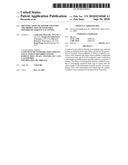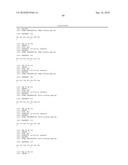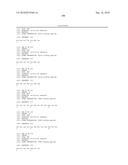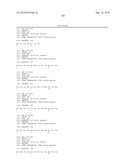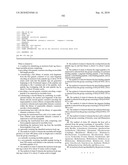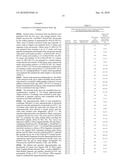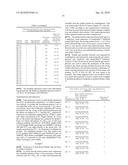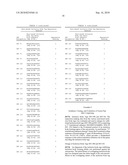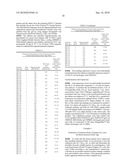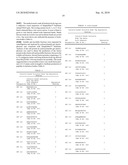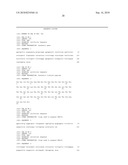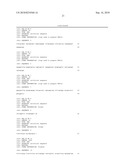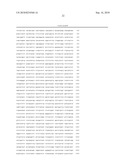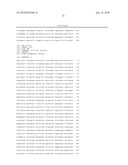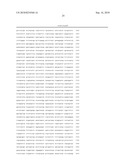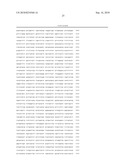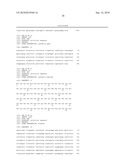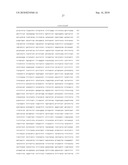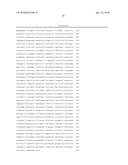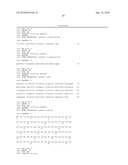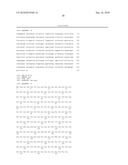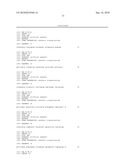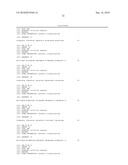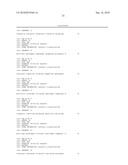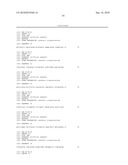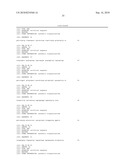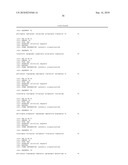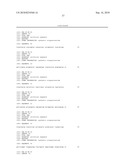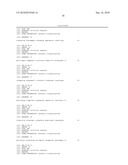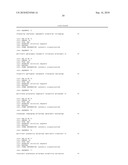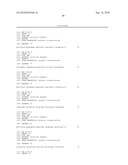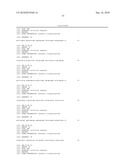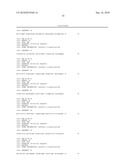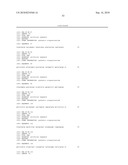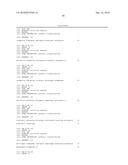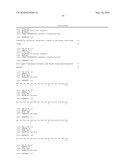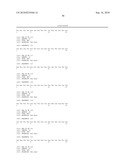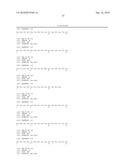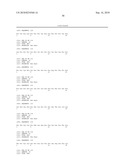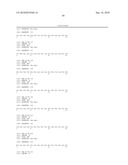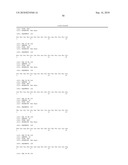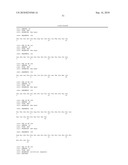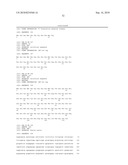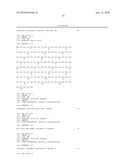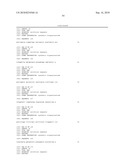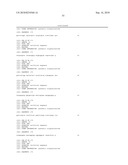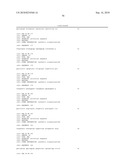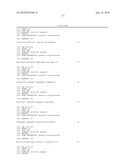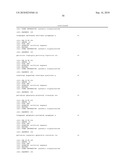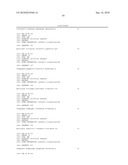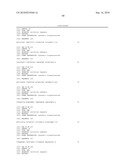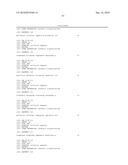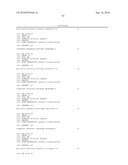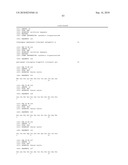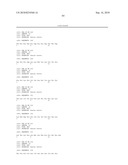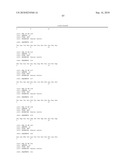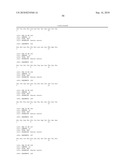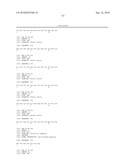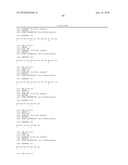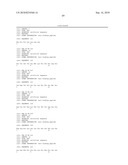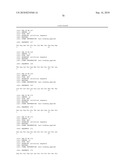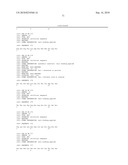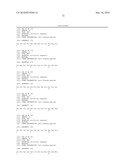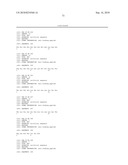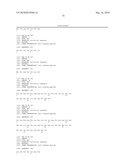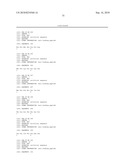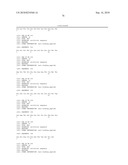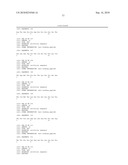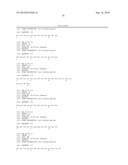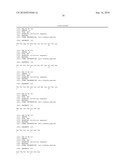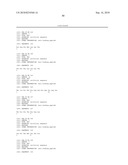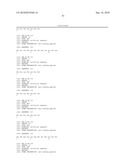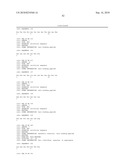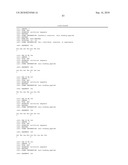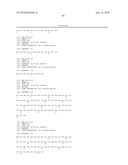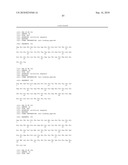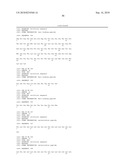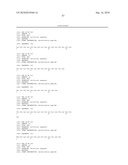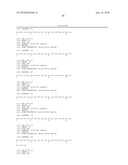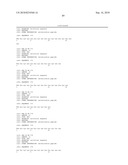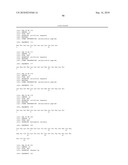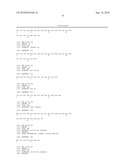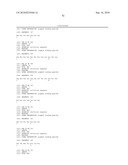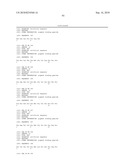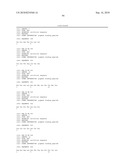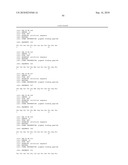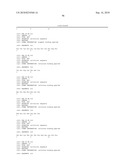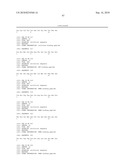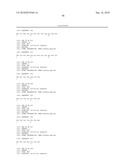Patent application title: Identification of peptide tags for the production of insoluble peptides by sequence scanning
Inventors:
Linda Jane Decarolis (Wilmington, DE, US)
Stephen R. Fahnestock (Wilmington, DE, US)
Pierre E. Rouviere (Wilmington, DE, US)
Pierre E. Rouviere (Wilmington, DE, US)
Hong Wang (Kennett Square, PA, US)
IPC8 Class: AC07K1400FI
USPC Class:
530350
Class name: Chemistry: natural resins or derivatives; peptides or proteins; lignins or reaction products thereof proteins, i.e., more than 100 amino acid residues
Publication date: 2010-09-16
Patent application number: 20100234568
Claims:
1. A method for identifying an inclusion body tag from a large insoluble
protein comprising:a) providing a first genetic construct encoding an
insoluble full-length protein;b) constructing a first library of nucleic
acid fragments from the first genetic construct of (a), each fragment
encoding an inclusion body peptide tag of about 10-50 amino acids such
that the peptide tags are generated beginning at the N-terminal region of
the peptide and extending to the C-terminal end of the peptide, each
peptide tag overlapping with the next peptide tag by about 3 to about 10
amino acids;c) providing a second genetic construct encoding a target
peptide to be expressed in insoluble form;d) constructing a second
library by combining, in combinatorial fashion, the nucleic acid
fragments of the first library and the second genetic construct encoding
the target peptide to create a library of expressible chimeric
constructs; wherein each expressible chimeric construct within the
library of expressible chimeric constructs encodes a fusion peptide;e)
transforming host cells with the library of expressible chimeric
constructs of (d);f) growing the transformed host cells of (e) under
conditions wherein each expressible chimeric construct is expressed as
said fusion peptideg) selecting the transformed host cells comprising
said fusion peptide expressed in insoluble form;j) identifying the
inclusion body tag from the insoluble fusion peptide of (g); andk)
optionally isolating the identified inclusion body tag.
2. The method of claim 1 wherein the insoluble full-length protein is at least 100 amino acids in length and is selected from the group consisting of:a) a naturally occurring insoluble peptide; andb) a non-naturally occurring insoluble peptide having at least 70% amino acid identity to the naturally occurring insoluble peptide of (a).
3. The method of claim 1 wherein the inclusion body peptide tag is about 10 to about 35 amino acids in length.
4. The method of claim 3 wherein the inclusion body peptide tag is about 12 to about 15 amino acids in length.
5. The method of claim 1 wherein the overlap between the peptide tags in said first library is about 3 to about 6 amino acids.
6. The method of claim 1 wherein the target peptide to be expressed is selected from the group consisting of a polymer binding peptide, a pigment binding peptide, a hair binding peptide, a nail binding peptide, a skin binding peptide, and an antimicrobial peptide.
7. The method of claim 6 wherein the hair binding peptide is selected from the group consisting of SEQ ID NOs: 262 to 354.
8. The method of claim 6 wherein the skin binding peptide is selected from the group consisting of SEQ ID NOs: 254 to 261.
9. The method of claim 6 wherein the nail binding peptide is selected from the group consisting of SEQ ID NOs: 355 to 356.
10. The method of claim 6 wherein the polymer binding peptide is selected from the group consisting of SEQ ID NOs: 412 to 445.
11. The method of claim 6 wherein the pigment binding peptide is selected from the group consisting of SEQ ID NOs: 386 to 411.
12. The method of claim 6 wherein the antimicrobial peptide is selected from the group consisting of SEQ ID NOs: 357 to 385.
13. The method of claim 1 wherein the host cell is selected from the group consisting of bacteria, yeast and filamentous fungi.
14. The method of claim 13, wherein the host cell is selected from the group consisting of Aspergillus, Trichoderma, Saccharomyces, Pichia, Candida, Hansenula, Salmonella, Bacillus, Acinetobacter, Zymomonas, Agrobacterium, Erythrobacter, Chlorobium, Chromatium, Flavobacterium, Cytophaga, Rhodobacter, Rhodococcus, Streptomyces, Brevibacterium, Corynebacteria, Mycobacterium, Deinococcus, Escherichia, Erwinia, Pantoea, Pseudomonas, Sphingomonas, Methylomonas, Methylobacter, Methylococcus, Methylosinus, Methylomicrobium, Methylocystis, Alcaligenes, Synechocystis, Synechococcus, Anabaena, Thiobacillus, Methanobacterium, Klebsiella, and Myxococcus.
15. An inclusion body tag identified by the process of claim 1.
Description:
[0001]This application claims priority under 35 U.S.C. §119 from U.S.
Provisional Application Ser. No. 60/852,841, filed Oct. 19, 2006.
FIELD OF THE INVENTION
[0002]The invention relates to the field of protein expression from microbial cells. More specifically, a method to identify short peptide tags useful in the preparation of insoluble fusion peptides is provided.
BACKGROUND OF THE INVENTION
[0003]The efficient production of bioactive proteins and peptides has become a hallmark of the biomedical and industrial biochemical industry. Bioactive peptides and proteins are used as curative agents in a variety of diseases such as diabetes (insulin), viral infections and leukemia (interferon), diseases of the immune system (interleukins), and red blood cell deficiencies (erythropoietin) to name a few. Additionally, large quantities of proteins and peptides are needed for various industrial applications including, for example, the pulp and paper and pulp industries, textiles, food industries, sugar refining, wastewater treatment, production of alcoholic beverages and as catalysts for the generation of new pharmaceuticals.
[0004]With the advent of the discovery and implementation of combinatorial peptide screening technologies such as bacterial display (Kemp, D. J.; Proc. Natl. Acad. Sci. USA 78(7): 4520-4524 (1981); yeast display (Chien et al., Proc Natl Acad Sci USA 88(21): 9578-82 (1991)), combinatorial solid phase peptide synthesis (U.S. Pat. No. 5,449,754, U.S. Pat. No. 5,480,971, U.S. Pat. No. 5,585,275, U.S. Pat. No. 5,639,603), and phage display technology (U.S. Pat. No. 5,223,409, U.S. Pat. No. 5,403,484, U.S. Pat. No. 5,571,698, U.S. Pat. No. 5,837,500) new applications for peptides having specific binding affinities have been developed. In particular, peptides are being looked to as linkers in biomedical fields for the attachment of diagnostic and pharmaceutical agents to surfaces (see Grinstaff et al, U.S. Patent Application Publication No. 2003/0185870 and Linter in U.S. Pat. No. 6,620,419), as well as in the personal care industry for the attachment of benefit agents to body surfaces such as hair and skin (see commonly owned U.S. patent application Ser. No. 10/935,642, and Janssen et al. U.S. Patent Application Publication No. 2003/0152976), and in the printing industry for the attachment of pigments to print media (see commonly owned U.S. patent application Ser. No. 10/935,254).
[0005]In some limited situations, commercially useful proteins and peptides may be synthetically generated or isolated from natural sources. However, these methods are often expensive, time consuming and characterized by limited production capacity. The preferred method of protein and peptide production is through the fermentation of recombinantly constructed organisms, engineered to over-express the protein or peptide of interest. Although preferable to synthesis or isolation, recombinant expression of peptides has a number of obstacles to be overcome in order to be a cost-effective means of production. For example, peptides (and in particular short peptides) produced in a cellular environment are susceptible to degradation from the action of native cellular proteases. Additionally, purification can be difficult, resulting in poor yields depending on the nature of the protein or peptide of interest.
[0006]One means to mitigate the above difficulties is the use the genetic chimera for protein and peptide expression. A chimeric protein or "fusion protein" is a polypeptide comprising at least one portion of the desired protein product fused to at least one portion comprising a peptide tag. The peptide tag may be used to assist protein folding, assist post expression purification, protect the protein from the action of degradative enzymes, and/or assist the protein in passing through the cell membrane.
[0007]In many cases it is useful to express a protein or peptide in insoluble form, particularly when the peptide of interest is rather short, normally soluble, and subject to proteolytic degradation within the host cell. Production of the peptide in insoluble form both facilitates simple recovery and protects the peptide from the undesirable proteolytic degradation. One means to produce the peptide in insoluble form is to recombinantly produce the peptide as part of an insoluble fusion protein by including in the fusion construct at least one peptide tag (i.e., an inclusion body tag) that induces inclusion body formation. Typically, the fusion protein is designed to include at least one cleavable peptide linker so that the peptide of interest can be subsequently recovered from the fusion protein. The fusion protein may be designed to include a plurality of inclusion body tags, cleavable peptide linkers, and regions encoding the peptide of interest.
[0008]Fusion proteins comprising a carrier protein tag that facilitates the expression of insoluble proteins are well known in the art. Typically, the tag portion of the chimeric or fusion protein is large, increasing the likelihood that the fusion protein will be insoluble. Example of large peptide tags typically used include, but are not limited to chloramphenicol acetyltransferase (Dykes et al., Eur. J. Biochem., 174:411 (1988), β-galactosidase (Schellenberger et al., Int. J. Peptide Protein Res., 41:326' (1993); Shen et al., Proc. Nat. Acad. Sci. USA 281:4627 (1984); and Kempe et al., Gene, 39:239 (1985)), glutathione-S-transferase (Ray et al., Bio/Technology, 11:64 (1993) and Hancock et al. (WO94/04688)), the N-terminus of L-ribulokinase (U.S. Pat. No. 5,206,154 and Lai et al., Antimicrob. Agents & Chemo., 37:1614 (1993), bacteriophage T4 gp55 protein (Gramm et al., Bio/Technology, 12:1017 (1994), bacterial ketosteroid isomerase protein (Kuliopulos et al., J. Am. Chem. Soc. 116:4599 (1994), ubiquitin (Pilon et al., Biotechnol. Prog., 13:374-79 (1997), bovine prochymosin (Haught et al., Biotechnol. Bioengineer. 57:55-61 (1998), and bactericidal/permeability-increasing protein ("BPI"; Better, M. D. and Gavit, P D., U.S. Pat. No. 6,242,219). The art is replete with specific examples of this technology, see for example U.S. Pat. No. 6,613,548, describing fusion protein of proteinaceous tag and a soluble protein and subsequent purification from cell lysate; U.S. Pat. No. 6,037,145, teaching a tag that protects the expressed chimeric protein from a specific protease; U.S. Pat. No. 5,648,244, teaching the synthesis of a fusion protein having a tag and a cleavable linker for facile purification of the desired protein; and U.S. Pat. No. 5,215,896; U.S. Pat. No. 5,302,526; U.S. Pat. No. 5,330,902; and US 2005221444, describing fusion tags containing amino acid compositions specifically designed to increase insolubility of the chimeric protein or peptide.
[0009]Recombinant production of a short peptide using a large, insoluble carrier protein decreases the production efficiency of the desired peptide it is only makes up a small percentage of the total mass of the purified fusion protein. This is particularly problematic in situations where the desired protein or peptide is small. In such situations it is advantageous to use a small fusion tags (i.e., short peptides capable of inducing inclusion body formation, herein referred to as "inclusion body tags") to maximized yield.
[0010]Limited numbers of effective, short, inclusion body tags have been reported in the art. Their effectiveness may depend on the peptide targeted for production. The identification of suitable short peptide tags often relies, to a great extent, on serendipity. As such, a method to identify short peptide tags having the ability to induce the formation insoluble fusion protein is needed.
[0011]Many of the carrier proteins used in the art were selected base on previous observations about their inherent insolubility. However, their insolubility may be attributed to small portions of the total protein. The structure of these small regions responsible for inducing insoluble fusion protein formation is somewhat unpredictable. As such, an efficient method to identify small regions within the larger insoluble protein is need.
[0012]The problem to be solved is to provide a simple and efficient method to identify short peptides that facilitate insoluble fusion protein formation when operably linked to a short peptide-of-interest.
SUMMARY OF THE INVENTION
[0013]A method is provided for identifying short peptides (inclusion body tags) that are useful for synthesizing insoluble fusion proteins. Short inclusion body tags are particularly useful for increasing expression and simplifying purification of short peptides ("peptides of interest"), especially short peptides useful in affinity applications.
[0014]The present method identifies short peptide tags (typically less than 50 amino acid in length) that are useful as inclusion body tags from a large insoluble protein or a protein having significant amino acid sequence homology to large insoluble protein.
[0015]Accordingly, a method to identify an inclusion body tag from a large insoluble protein is provided comprising: [0016]a) providing a first genetic construct encoding an insoluble full-length protein; [0017]b) constructing a first library of nucleic acid fragments from the first genetic construct of (a), each fragment encoding an inclusion body peptide tag of about 10-50 amino acids such that the peptide tags are generated beginning at the N-terminal region of the peptide and extending to the C-terminal end of the peptide, each peptide tag overlapping with the next peptide tag by about 3 to about 10 amino acids; [0018]c) providing a second genetic construct encoding a target peptide to be expressed in insoluble form; [0019]d) constructing a second library by combining, in combinatorial fashion, the nucleic acid fragments of the first library and the second genetic construct encoding the target peptide to create a library of expressible chimeric constructs; wherein each expressible chimeric construct within the library of expressible chimeric constructs encodes a fusion peptide; [0020]e) transforming host cells with the library of expressible chimeric constructs of (d); [0021]f) growing the transformed host cells of (e) under conditions wherein each expressible chimeric constructs is expressed as said fusion peptide [0022]g) selecting the transformed host cells comprising said fusion peptide expressed in insoluble form; [0023]h) identifying the inclusion body tag from the insoluble fusion peptide of (g); and [0024]i) optionally isolating the identified inclusion body tag.
[0025]In another embodiment, the present invention provides an inclusion body tag identified by the above process.
BRIEF DESCRIPTION OF THE BIOLOGICAL SEQUENCES
[0026]The following sequences comply with 37 C.F.R. 1.821-1.825 ("Requirements for Patent Applications Containing Nucleotide Sequences and/or Amino Acid Sequence Disclosures--the Sequence Rules") and are consistent with World Intellectual Property Organization (WIPO) Standard ST.25 (1998) and the sequence listing requirements of the EPC and PCT (Rules 5.2 and 49.5(a-bis), and Section 208 and Annex C of the Administrative Instructions). The symbols and format used for nucleotide and amino acid sequence data comply with the rules set forth in 37 C.F.R. §1.822.
[0027]A Sequence Listing is provided herewith on Compact Disk. The contents of the Compact Disk containing the Sequence Listing are hereby incorporated by reference in compliance with 37 CFR 1.52(e). The Compact Disks are submitted in triplicate and are identical to one another. The disks are labeled "Copy 1--Sequence Listing", "Copy 2--Sequence Listing", and CRF. The disks contain the following file: CL3005 US NA.ST25 having the following size: 118,000 bytes and which was created Nov. 30, 2006.
[0028]SEQ ID NO: 1 is the nucleotide sequence of the TBP1 coding sequence encoding the TBP101 peptide.
[0029]SEQ ID NO: 2 is the amino acid sequence of the TBP101 peptide.
[0030]SEQ ID NOs: 3-7 are the nucleotide sequences of oligonucleotides used to synthesize TBP1.
[0031]SEQ ID NO: 8 and 9 are the nucleotide sequences of the primers used to PCR amplify TBP1.
[0032]SEQ ID NO: 10 is the nucleotide sequence of pENTRT®/D-TOPO® plasmid (Invitrogen, Carlsbad, Calif.).
[0033]SEQ ID NO: 11 is the nucleotide sequence of the pDEST plasmid (Invitrogen).
[0034]SEQ ID NO: 12 is the nucleotide sequence of the coding region encoding the INK101 fusion peptide.
[0035]SEQ ID NO: 13 is the amino acid sequence of the INK101 fusion peptide.
[0036]SEQ ID NO: 14 is the nucleotide sequence of plasmid pLX121.
[0037]SEQ ID NOs: 15 and 16 are the nucleotide sequences of primers used to introduce an acid cleavable aspartic acid-proline dipeptide linker into TBP101.
[0038]SEQ ID NO: 17 is the nucleotide sequence of the coding region encoding the INK101DP peptide.
[0039]SEQ ID NO: 18 is the amino acid sequence of the INK101DP peptide.
[0040]SEQ ID NO: 19 is the nucleotide sequence of the opaque2 modifier (referred to herein as "gamma zeinA") coding region from Zea mays.
[0041]SEQ ID NO: 20 is the amino acid sequence of the 27-kDa gamma zeinA protein (GenBank® AAP32017).
[0042]SEQ ID NOs: 21 to 110 are the nucleotide sequences of oligonucleotides used to prepare the zein-based inclusion body tags.
[0043]SEQ ID NOs: 111 to 155 and 157 to 158 are the amino acid sequences of zein-based peptides evaluated as potential inclusion body tags.
[0044]SEQ ID NO: 156 is the amino acid sequence of the T7 translation enhancer element found in IBT-180 and IBT-181.
[0045]SEQ ID NO: 159 is the nucleotide sequence of the coding region for the gene encoding the Daucus carota (carrot) extracellular cystatin protein (GenBank® BAA20464).
[0046]SEQ ID NO: 160 is the amino acid sequence of the Daucus carota extracellular cystatin protein (GenBank® BAA20464).
[0047]SEQ ID NOs: 161 to 222 are the nucleotide sequences of oligonucleotides used to prepare the cystatin-based inclusion body tags.
[0048]SEQ ID NOs: 223 to 253 are the amino acid sequences of the cystatin-based peptides evaluated as potential inclusion body tags.
[0049]SEQ ID NOs: 254 to 356 are examples of amino acid sequences of body surface binding peptides, SEQ ID NOs 254-261 are skin binding peptides, SEQ ID NOs 262-354 are hair binding peptides, and SEQ ID NOs: 355-356 are nail binding peptides.
[0050]SEQ ID NOs: 356 to 385 are examples of antimicrobial peptide sequences.
[0051]SEQ ID NOs: 386 to 411 are examples of pigment binding peptides,
[0052]SEQ ID NOs: 386-389 bind carbon black, SEQ ID NOs: 390-398 are Cromophtal® yellow (Ciba Specialty Chemicals, Basel, Switzerland) binding peptides, SEQ ID NOs: 399-401 are Sunfast® magenta (Sun Chemical Corp., Parsippany, N.J.) binding peptides, and SEQ ID NOs: 402-411 are Sunfast® blue binding peptides.
[0053]SEQ ID NOs: 412 to 445 are examples of polymer binding peptides, SEQ ID NOs: 412-417 are cellulose binding peptides, SEQ ID NO: 418 is a polyethylene terephthalate) (PET) binding peptide, SEQ ID NOs: 419-430 are poly(methyl methacrylate) (PMMA) binding peptides, SEQ ID NOs: 431-436 are nylon binding peptides, and SEQ ID NOs: 437-445 are poly(tetrafluoro ethylene) (PTFE) binding peptides.
[0054]SEQ ID NO: 446 is the amino acid sequence of the Caspase-3 cleavage site that may be used as a cleavable peptide linker domain.
DETAILED DESCRIPTION OF THE INVENTION
[0055]The present invention provides a method to identify short peptide tags ("inclusion body tag fusion partners") derived from a larger insoluble protein that may be coupled with a peptide of interest to form an insoluble fusion protein. In this manner, short inclusion body tags can be identified quickly and efficiently.
[0056]Specifically, a library of chimeric genes encoding fusion proteins was designed to assess the ability of small peptide tags derived from a larger, insoluble protein to induce the formation of insoluble inclusion bodies when fused to a short, soluble peptide of interest. A library of peptide tags comprising 10 to 50 contiguous amino acids from a larger, insoluble protein was prepared such that the peptide tags were generated beginning at the N-terminal region of the insoluble full length protein and extending to the C-terminal end of the insoluble full length protein, each peptide tag overlapping with the next peptide tag by about 3 to about 10 amino acids. In this way, the larger, insoluble protein was "scanned" or "probed" for small regions suitable for use as potential inclusion body tags in a method referred to herein as "tag scanning" or "sequence scanning".
[0057]The present method provides a means to identify short inclusion body tags useful for the expression and recovery of short peptides of interest. Such peptides typically have high value in any number of applications including, but not limited to medical, biomedical, diagnostic, personal care, and affinity applications where the peptides of interest are used as linkers to various surfaces.
[0058]The following definitions are used herein and should be referred to for interpretation of the claims and the specification. Unless otherwise noted, all U.S. patents and U.S. patent applications referenced herein are incorporated by reference in their entirety.
[0059]As used herein, the term "comprising" means the presence of the stated features, integers, steps, or components as referred to in the claims, but that it does not preclude the presence or addition of one or more other features, integers, steps, components or groups thereof.
[0060]The term "invention" or "present invention" as used herein is a non-limiting term and is not intended to refer to any single embodiment of the particular invention but encompasses all possible embodiments as described in the specification and the claims.
[0061]"Open reading frame" is abbreviated ORF.
[0062]"Polymerase chain reaction" is abbreviated PCR.
[0063]As used herein, the term "isolated nucleic acid molecule" is a polymer of RNA or DNA that is single- or double-stranded, optionally containing synthetic, non-natural or altered nucleotide bases. An isolated nucleic acid molecule in the form of a polymer of DNA may be comprised of one or more segments of cDNA, genomic DNA or synthetic DNA.
[0064]As used herein, the term "hair" as used herein refers to human hair, eyebrows, and eyelashes.
[0065]As used herein, the term "skin" as used herein refers to human skin, or substitutes for human skin, such as pig skin, Vitro-Skin® and EpiDerm®. Skin, as used herein, will refer to a body surface generally comprising a layer of epithelial cells and may additionally comprise a layer of endothelial cells.
[0066]As used herein, the term "nails" as used herein refers to human fingernails and toenails and other body surfaces comprising primarily keratin.
[0067]As used herein, the term "pigment" refers to an insoluble, organic or inorganic colorant.
[0068]As used herein, "HBP" means hair-binding peptide. Examples of hair binding peptides have been reported (U.S. patent application Ser. No. 11/074,473 to Huang et al.; WO 0179479; U.S. Patent Application Publication No. 2002/0098524 to Murray et al.; Janssen et al., U.S. Patent Application Publication No. 2003/0152976 to Janssen et al.; WO 04048399; U.S. Provisional Patent Application No. 60/721,329; U.S. Provisional Application No. 60/721,329, and U.S. Provisional Patent Application No. 60/790,149).
[0069]As used herein, "SBP" means skin-binding peptide. Examples of skin binding peptides have also been reported (U.S. patent application Ser. No. 11/069,858 to Buseman-Williams; Rothe et. al., WO 2004/000257; and U.S. Provisional Patent Application No. 60/790,149).
[0070]As used herein, "NBP" means nail-binding peptide. Examples of nail binding peptides have been reported (U.S. Provisional Patent Application No. 60/790,149).
[0071]As used herein, an "antimicrobial peptide" is a peptide having the ability to kill microbial cell populations (U.S. Provisional Patent Application No. 60/790,149).
[0072]As used herein, the terms "cystatin", "cystatin protein", "Daucus carota cystatin", and "extracellular insoluble cystatin" will refer to the Daucus carota protein having the amino acid sequence as set forth in SEQ ID NO: 160 (GenBank® Accession No. BAA20464). The coding region of the cystatin gene having GenBank® Accession No. BAA20464 is provided as SEQ ID NO: 159. As used herein, "cystatin-based" inclusion body tags are short peptides derived from a portion of the cystatin protein (SEQ ID NO: 160).
[0073]As used herein, the terms "zein 27 kDa storage protein", "zein protein", "gamma zein protein", and "opaque2 protein" will refer to the Zea mays protein having the amino acid sequence as set forth in SEQ ID NO:20 (GenBank® Accession No. AAP32017). The coding region encoding the zein protein having GenBank® Accession No. AAP32017 is provided as SEQ ID NO: 19. As used herein, "zein-based" inclusion body tags are short peptides derived from a portion of the Zea mays zein protein as set forth in SEQ ID NO: 20.
[0074]As used herein, the term "inclusion body tag" will be abbreviated "IBT" and will refer a polypeptide that facilitates/stimulates formation of inclusion bodies when fused to a peptide of interest. The peptide of interest is typically short and soluble within the host cell and/or host cell lysate when not fused to an inclusion body tag. Fusion of the peptide of interest to the inclusion body tag produces an insoluble fusion protein that typically agglomerates into intracellular bodies (inclusion bodies) within the host cell. The fusion protein comprises at least one portion comprising an inclusion body tag and at least one portion comprising the polypeptide of interest. In one aspect, the protein/polypeptides of interest are separated from the inclusion body tags using cleavable peptide linker elements. Using the present method, inclusion body tags of about 10 to about 50 amino acids in length are identified from portions of a large insoluble protein. The length of the inclusion body tags identified using the present method are about 10 to about 50 amino acids in length, preferably 10 to about 35 amino acids in length, more preferably 10 to about 25 amino acids in length, and more preferably 12 to 15 amino acids in length.
[0075]As used herein, "cleavable linker elements", "peptide linkers", and "cleavable peptide linkers" will be used interchangeably and refer to cleavable peptide segments typically found between inclusion body tags and the peptide of interest. After the inclusion bodies are separated and/or partially-purified or purified from the cell lysate, the cleavable linker elements can be cleaved chemically and/or enzymatically to separate the inclusion body tag from the peptide of interest. The peptide of interest can then be isolated from the inclusion body tag, if necessary. In one embodiment, the inclusion body tag(s) and the peptide of interest exhibit different solubilities in a defined medium (typically an aqueous medium), facilitating separation of the inclusion body tag from the protein/polypeptide of interest. In a preferred embodiment, the inclusion body tag is insoluble in an aqueous solution while the protein/polypeptide of interest is appreciably soluble in an aqueous solution. The pH, temperature, and/or ionic strength of the aqueous solution can be adjusted to facilitate recovery of the peptide of interest. In a preferred embodiment, the differential solubility between the inclusion body tag and the peptide of interest occurs in an aqueous solution having a pH of 5 to 10 and a temperature range of 15 to 50° C. The cleavable peptide linker may be from 1 to about 50 amino acids, preferably from 1 to about 20 amino acids in length. An example of a cleavable peptide linker is provided by SEQ ID NO: 446 (Caspase-3 cleavage sequence). The cleavable peptide linkers may be incorporated into the fusion proteins using any number of techniques well known in the art.
[0076]As used herein, the term "dispersant" as used herein refers to a substance that stabilizes the formation of a colloidal solution of solid pigment particles in a liquid medium. As used herein, the term "triblock dispersant" to a pigment dispersant that consists of three different units or blocks, each serving a specific function. In the present examples, a synthetic peptide encoding a peptide-based triblock dispersant was used as the "peptide of interest" to evaluate the performance of the present inclusion body tags (U.S. Ser. No. 10/935,254).
[0077]As used herein, the term "operably linked" refers to the association of nucleic acid sequences on a single nucleic acid fragment so that the function of one is affected by the other. For example, a promoter is operably linked with a coding sequence when it is capable of effecting the expression of that coding sequence (i.e., that the coding sequence is under the transcriptional control of the promoter). In a further embodiment, the definition of "operably linked" may also be extended to describe the products of chimeric genes, such as fusion proteins. As such, "operably linked" will also refer to the linking of an inclusion body tag to a peptide of interest to be produced and recovered. The inclusion body tag is "operably linked" to the peptide of interest if upon expression the fusion protein is insoluble and accumulates it inclusion bodies in the expressing host cell. In a preferred embodiment, the fusion peptide will include at least one cleavable peptide linker useful in separating the inclusion body tag from the peptide of interest. In a further preferred embodiment, the cleavable linker is an acid cleavable aspartic acid--proline dipeptide (D-P) moiety (see INK101DP; SEQ ID NO: 18). The cleavable peptide linkers may be incorporated into the fusion proteins using any number of techniques well known in the art.
[0078]As used herein, the term "in a combinatorial fashion" or "combinatorially" means an action, method or process wherein combinations of different, but structurally related molecules are assembled from combinations and/or arrangements of elements in sets. As shown in the present examples, a library of genetic constructs encoding fusion proteins were prepared by combining various portions of a large, insoluble protein ("the peptide tag") with a short peptide of interest. Each of the constructs was expressed in an appropriate host cell and assessed for inclusion body formation.
[0079]As used herein, the term "tag scanning" or "sequence scanning" will be used to refer to the present method of assaying a library of short, overlapping peptide tags derived from a large, insoluble protein for their ability to promote insoluble fusion peptide formation when operably linked a short peptide of interest. In the present method, a library of genetic constructs (chimeric genes) are prepared encoding fusion peptides comprising at least one first portion and at least one second portion wherein said first portion comprises a 10 to 50 contiguous amino acid sequence derived from a large, insoluble protein fused to said second portion comprising a short peptide of interest. In a preferred aspect, the first portion comprises 10 to 35 contiguous amino acids, preferably 10 to 25 contiguous amino acid, and more preferably 12-15 contiguous amino acids from a portion of a large insoluble protein.
[0080]As used herein, "contiguous amino acids" means a peptide of a defined length comprising an amino acid sequence identical to a portion of a large, insoluble protein from which the sequence was derived.
[0081]As used herein, the terms "large insoluble protein", "insoluble full-length protein", and "insoluble carrier protein" will be used interchangeably and used to describe (1) a protein reported in the art to be insoluble under normal physiological conditions (i.e., when expressed in a suitable host cell) or (2) a protein having high homology to a protein reported to typically be insoluble under normal physiological conditions. Recombinant peptide production using a large, insoluble carrier protein is known in the art. However, the production efficiency for short peptides of interest is adversely affected when fused to a large, insoluble carrier protein (i.e., the short peptide of interest comprises only a small weight percent of the total fusion protein). As such, the present method is used to identify small portions of the larger insoluble protein that have the ability to induce inclusion body formation. In one aspect, the large insoluble protein of interest is at least 100 amino acids in length, preferably at least 125 amino acids in length, more preferably at least 150 amino acids in length, and most preferably at least 175 amino acids in length. As exemplified herein, two different large, insoluble proteins (cystatin and zein) were evaluated using the present method and found to contain regions suitable for use in preparing inclusion body tags.
[0082]As used herein, the terms "fusion protein", "fusion peptide", "chimeric protein", and "chimeric peptide" will be used interchangeably and will refer to a polymer of amino acids (peptide, oligopeptide, polypeptide, or protein) comprising at least one first portion and at least one second portion, each portion comprising a distinct function. The first portion of the fusion peptide comprises at least one of the present inclusion body tags. The second portion comprises at least one peptide of interest. In a preferred embodiment, the fusion protein additionally includes at least one additional portion comprising at least one cleavable peptide linker that facilitates cleavage (chemical and/or enzymatic) and separation of the inclusion body tag(s) and the peptide(s) of interest.
[0083]Means to prepare peptides (inclusion body tags, cleavable peptide linkers, peptides of interest, and fusion peptides) are well known in the art (see, for example, Stewart et al., Solid Phase Peptide Synthesis, Pierce Chemical Co., Rockford, Ill., 1984; Bodanszky, Principles of Peptide Synthesis, Springer-Verlag, New York, 1984; and Pennington et al., Peptide Synthesis Protocols, Humana Press, Totowa, N.J., 1994). The various components of the fusion peptides (inclusion body tag, peptide of interest, and the cleavable linker) described herein can be combined using carbodiimide coupling agents (see for example, Hermanson, Greg T., Bioconjugate Techniques, Academic Press, New York (1996)), diacid chlorides, diisocyanates and other difunctional coupling reagents that are reactive to terminal amine and/or carboxylic acid groups on the peptides. However, chemical synthesis is often limited to peptides of less than about 50 amino acids length due to cost and/or impurities. In a preferred embodiment, the entire peptide reagent is prepared using recombinant DNA and molecular cloning techniques.
[0084]As used herein, the terms "polypeptide" and "peptide" will be used interchangeably to refer to a polymer of two or more amino acids joined together by a peptide bond, wherein the peptide is of unspecified length, thus, peptides, oligopeptides, polypeptides, and proteins are included within the present definition. In one aspect, this term also includes post expression modifications of the polypeptide, for example, glycosylations, acetylations, phosphorylations and the like. Included within the definition are, for example, peptides containing one or more analogues of an amino acid or labeled amino acids and peptidomimetics.
[0085]As used herein, the terms "polypeptide of interest", "peptide of interest", "short peptide of interest", "targeted protein", "targeted polypeptide", and "targeted peptide" will be used interchangeably and refer to a peptide having a defined activity or use that may be expressed by the genetic machinery of a host cell. In one aspect, the present method is useful for identifying inclusion body tags suitable for expressing short, soluble, peptides of interest in an insoluble form (i.e. an insoluble fusion peptide). In another aspect, the short peptide of interest is less than 100 amino acids in length, preferably less than 75 amino acids in length, more preferably less than 50 amino acids in length, and more preferably less than 35 amino acids in length.
[0086]As used herein, the terms "bioactive" and "peptide of interest activity" are used interchangeably and refer to the activity or characteristic associated with the peptide of interest. The bioactive peptides may be used in a variety of applications including, but not limited to curative agents for diseases (e.g., insulin, interferon, interleukins, anti-angiogenic peptides (U.S. Pat. No. 6,815,426), and polypeptides that bind to defined cellular targets such as receptors, channels, lipids, cytosolic proteins, and membrane proteins, to name a few), peptides having antimicrobial activity, peptides having an affinity for a particular material (e.g., hair binding polypeptides, skin binding polypeptides, nail binding polypeptides, cellulose binding polypeptides, polymer binding polypeptides, clay binding polypeptides, silicon binding polypeptides, carbon nanotube binding polypeptides, and peptides that have an affinity for particular animal or plant tissues) for targeted delivery of benefit agents.
[0087]As used herein, the "benefit agent" refers to a molecule that imparts a desired functionality to the complex for a defined application. The benefit agent may be peptide of interest itself or may be one or more molecules bound to (covalently or non-covalently), or associated with, the peptide of interest wherein the binding affinity of the targeted polypeptide is used to selectively target the benefit agent to the targeted material. In another embodiment, the targeted polypeptide comprises at least one region having an affinity for at least one target material (e.g., biological molecules, polymers, hair, skin, nail, other peptides, etc.) and at least one region having an affinity for the benefit agent (e.g., pharmaceutical agents, pigments, conditioners, dyes, fragrances, etc.). In another embodiment, the peptide of interest comprises a plurality of regions having an affinity for the target material and a plurality of regions having an affinity for the benefit agent. In yet another embodiment, the peptide of interest comprises at least one region having an affinity for a targeted material and a plurality of regions having an affinity for a variety of benefit agents wherein the benefit agents may be the same of different. Examples of benefits agents may include, but are not limited to conditioners for personal care products, pigments, dye, fragrances, pharmaceutical agents (e.g., targeted delivery of cancer treatment agents), diagnostic/labeling agents, ultraviolet light blocking agents (i.e., active agents in sunscreen protectants), and antimicrobial agents (e.g., antimicrobial peptides), to name a few.
[0088]As used herein, an "inclusion body" is an intracellular amorphous deposit comprising aggregated protein found in the cytoplasm of a cell. Peptides of interest that are typically soluble with the host cell and/or cell lysates can be fused to one or more of the short inclusion body tags to facilitate formation of an insoluble fusion protein. In an alternative embodiment, the peptide of interest may be partially insoluble in the host cell, but produced at relatively lows levels where significant inclusion body formation does not occur. In a further embodiment, fusion of the peptide of interest to one or more inclusion body tags (IBTs) increases the amount of protein produced in the host cell. Formation of the inclusion body facilitates simple and efficient isolation of the fusion peptide from the cell lysate using techniques well known in the art such as centrifugation and filtration. The isolated fusion peptide may be further processed using any number of common purification techniques well known in the art (precipitation, extraction, ion exchange, chromatographic techniques, etc.) to isolate the desired peptide of interest. The fusion protein typically includes one or more cleavable peptide linkers used to separate the protein/polypeptide of interest from the inclusion body tag(s). The cleavable peptide linker is designed so that the inclusion body tag(s) and the protein/polypeptide(s) of interest can be easily separated by cleaving the linker element. The peptide linker can be cleaved chemically (e.g., acid hydrolysis) or enzymatically (i.e., use of a protease/peptidase that preferentially recognizes an amino acid cleavage site and/or sequence within the cleavable peptide linker).
[0089]As used herein, the term "solubility" refers to the amount of a substance that can be dissolved in a unit volume of a liquid under specified conditions. In the present application, the term "solubility" is used to describe the ability of a peptide (inclusion body tag, peptide of interest, or fusion peptides) to be resuspended in a volume of solvent, such as a biological buffer. In one aspect, the substance (peptide, fusion peptide, inclusion body tags, etc.) is "insoluble" when less than 5 mg can be dissolved in 100 mL of solvent (e.g. an aqueous matrix such as biological buffer). In one embodiment, the peptides targeted for production ("peptides of interest") are normally soluble in the cell and/or cell lysate under normal physiological conditions. Fusion of one or more inclusion body tags (IBTs) to the target peptide results in the formation of a fusion peptide that is insoluble under normal physiological conditions, resulting in the formation of inclusion bodies. In one embodiment, the peptide of interest is insoluble in an aqueous matrix having a pH range of 5-12, preferably 6-10; and a temperature range of 5° C. to 50° C., preferably 10° C. to 40° C. Fusion of the peptide of interest to at least one of the present inclusion body tags results in the formation of an insoluble fusion protein that agglomerates into at least one inclusion body under normal physiological conditions.
[0090]The term "amino acid" refers to the basic chemical structural unit of a protein or polypeptide. The following abbreviations are used herein to identify specific amino acids:
TABLE-US-00001 Three-Letter One-Letter Amino Acid Abbreviation Abbreviation Alanine Ala A Arginine Arg R Asparagine Asn N Aspartic acid Asp D Cysteine Cys C Glutamine Gln Q Glutamic acid Glu E Glycine Gly G Histidine His H Isoleucine Ile I Leucine Leu L Lysine Lys K Methionine Met M Phenylalanine Phe F Proline Pro P Serine Ser S Threonine Thr T Tryptophan Trp W Tyrosine Tyr Y Valine Val V Miscellaneous Xaa X (or as defined herein)
[0091]"Gene" refers to a nucleic acid fragment that expresses a specific protein, including regulatory sequences preceding (5' non-coding sequences) and following (3' non-coding sequences) the coding sequence. "Native gene" refers to a gene as found in nature with its own regulatory sequences "Chimeric gene" refers to any gene that is not a native gene, comprising regulatory and coding sequences (including coding regions engineered to encode fusion peptides) that are not found together in nature. Accordingly, a chimeric gene may comprise regulatory sequences and coding sequences that are derived from different sources, or regulatory sequences and coding sequences derived from the same source, but arranged in a manner different than that found in nature. A "foreign" gene refers to a gene not normally found in the host organism, but that is introduced into the host organism by gene transfer. Foreign genes can comprise native genes inserted into a non-native organism, or chimeric genes.
[0092]As used herein, the term "genetic construct" refers to a series of contiguous nucleic acids useful for modulating the genotype or phenotype of an organism. Non-limiting examples of a genetic constructs include, but are not limited to a nucleic acid molecule, an open reading frame, a gene, a coding region, a plasmid, and the like. Typically, the genetic construct will include a chimeric gene encoding a fusion peptide, said chimeric gene comprising a coding region operably linked to suitable 5' and 3' regulatory regions. Given the structures of (1) the inclusion body tag and (2) the peptide of interest, it is well within the skill of one in the art to assemble an expressible genetic construct encoding the desired fusion peptide.
[0093]As used herein, the term "expression ranking" means the relative yield of insoluble fusion protein estimated visually and scored on a relative scale of 0 (no insoluble fusion peptide) to 3 (highest yield of insoluble fusion peptide). As described in the present examples, the relative yield of insoluble fusion protein was estimated visually from stained polyacrylamide gels.
[0094]As used herein, the term "transformation" refers to the transfer of a nucleic acid fragment into the genome of a host organism, resulting in genetically stable inheritance. As used herein, the host cell's genome is comprised of chromosomal and extrachromosomal (e.g., plasmid) genes. Host organisms containing the transformed nucleic acid fragments are referred to as "transgenic" or "recombinant" or "transformed" organisms.
[0095]As used herein, the term "host cell" refers to cell which has been transformed or transfected, or is capable of transformation or transfection by an exogenous polynucleotide sequence.
[0096]As used herein, the terms "plasmid", "vector" and "cassette" refer to an extrachromosomal element often carrying genes which are not part of the central metabolism of the cell, and usually in the form of circular double-stranded DNA molecules. Such elements may be autonomously replicating sequences, genome integrating sequences, phage or nucleotide sequences, linear or circular, of a single- or double-stranded DNA or RNA, derived from any source, in which a number of nucleotide sequences have been joined or recombined into a unique construction which is capable of introducing a promoter fragment and DNA sequence for a selected gene product along with appropriate 3' untranslated sequence into a cell. "Transformation cassette" refers to a specific vector containing a foreign gene and having elements in addition to the foreign gene that facilitates transformation of a particular host cell. "Expression cassette" refers to a specific vector containing a foreign gene and having elements in addition to the foreign gene that allow for enhanced expression of that gene in a foreign host.
[0097]Standard recombinant DNA and molecular cloning techniques used herein are well known in the art and are described by Sambrook, J., Fritsch, E. F. and Maniatis, T., Molecular Cloning: A Laboratory Manual, Third Edition, Cold Spring Harbor Laboratory Press, Cold Spring Harbor, N.Y. (2001); and by Silhavy, T. J., Bennan, M. L. and Enquist, L. W., Experiments with Gene Fusions, Cold Spring Harbor Laboratory Cold Press Spring Harbor, N.Y. (1984); and by Ausubel, F. M. et al., Current Protocols in Molecular Biology, published by Greene Publishing Assoc. and Wiley-Interscience (1987).
Insoluble Protein Sequence Scanning
[0098]Many large carrier proteins have been used to produce insoluble fusion proteins. Examples of these proteins include β-galactosidase, glutathione-S-transferase, bacteriophage T4 gp55 protein, and bacterial ketosteroid isomerase, to name a few. However, the use of a large carrier protein for recombinant peptide production significantly reduces the overall production efficiency, especially when the peptide of interest is small (<100 amino acids). As such, the peptide of interest is only a small percentage of the total mass of the purified fusion protein. There is a need to identify short peptide tags capable of inducing insoluble fusion peptide formation.
[0099]The present method provides short peptide tags ("inclusion body tags") suitable for preparing insoluble fusion peptides. The present method identifies portions and/or regions of larger, insoluble proteins that are suitable for use an inclusion body tags.
[0100]In general, a library of genetic constructs is prepared encoding a library of fusion peptides. Each fusion peptide comprises at least two portions. The first portion comprises a 10-50 contiguous amino acid sequence from a larger, insoluble protein. The second portion comprises a short peptide of interest that is typically soluble and/or difficult to produce due to the host cell's endogenous proteolytic activity. The library is constructed such that short, 10-50 contiguous amino acid peptide tags are generated beginning at the N-terminal region of the full-length insoluble protein, extending to the C-terminal end of the insoluble full-length protein, each peptide tag overlapping the next peptide tag in the library by about 3 to about 10 amino acids.
[0101]The genetic constructs encoding the various members of the fusion peptide library are transformed and expressed in an appropriate host cell. Host cells comprising the fusion peptides are evaluated for inclusion body formation. The sequences of the peptide tags capable of inducing inclusion body formation are compared to the sequence of the insoluble full-length protein.
[0102]Preferably, each of the amino acid residues within the larger, insoluble peptide will be found within at least one of the members of the peptide tag library. In another preferred aspect, each amino acid from the larger, insoluble full-length protein will be represented in a plurality of overlapping members within the tag library. In this way, the entire sequence of the insoluble full-length protein is evaluated for suitable short inclusion body tags. Regions of the insoluble full-length protein that produce short peptide tags having inclusion body forming ability can be identified and refined by comparing the effective inclusion body forming tags against the sequence of the insoluble full-length protein. As shown in the present examples, suitable regions will typically be represented by multiple tags within the library (i.e., the inclusion body tag sequences will typically overlap to some extent).
[0103]The insoluble full-length protein refers to any protein reported to be insoluble under normal physiological conditions or a protein believed to insoluble based on homology to another insoluble protein. In another aspect, the selected protein used to prepare the library of short peptide tags has significant homology to a natural full-length protein reported in the art to be insoluble. In one embodiment, "significant homology" means a protein having at least 60%, preferably at least 70%, more preferably at least 80%, even more preferably at least 90%, and most preferably at least 95% amino acid sequence identify to a previously reported full-length insoluble protein. In a yet another aspect, the full-length protein is an insoluble protein found in nature or a derivative of the full-length protein found in nature sharing high homology over at least 100 amino acids to the natural protein. In another embodiment, proteins having "significant homology" to an insoluble full-length protein may also be identified by structural similarities between their respective gene sequences (i.e. coding regions). A common tool to identify nucleic acid molecules sharing significant homology is hybridization (Maniatis, supra). The skilled artisan recognizes that substantially similar nucleic acid sequences encoding full-length insoluble proteins can be defined by their ability to hybridize, under highly stringent conditions (0.1×SSC, 0.1% SDS, 65° C. and washed with 2×SSC, 0.1% SDS followed by 0.1×SSC, 0.1% SDS, 65° C.), with the target sequence.
[0104]In one aspect, the library of peptide tags is prepared from a full-length insoluble protein that is typically at least 100 amino acids in length, preferably at least 125 amino acids in length, more preferably at least 150 amino acids in length, and most preferably at least 175 amino acids in length.
[0105]In one aspect, the library of peptide tags is prepared to ensure that the overlapping members of the library cover at least 90% of the entire length of the full-length insoluble protein. In a highly preferred aspect, the library of peptide tags covers the entire length of the full-length insoluble protein.
[0106]The peptide tags are designed to represent a 10 to 50 contiguous amino acid portion of the full-length insoluble protein. In one aspect, the members of the peptide tag library are 10 to about 35 amino acids in length, more preferably 10 to about 25 amino acids in length, and more preferably 12 to 15 amino acids in length.
[0107]The library of peptide tags library is designed so that at least each peptide tag overlaps with another peptide tags by about 3 to about 10 amino acids, preferably overlapping from 3 to 10 amino acids, more preferably overlapping by about 3 to 6 about amino acids, and most preferably overlapping by about 5 amino acids. The use of overlapping tags enables one to refine and identify those regions suitable for preparing short inclusion body tags.
[0108]The structure of short peptide tags capable of inducing inclusion body formation is somewhat unpredictable. As such, the present method simplifies a process to identify the regions within larger, insoluble proteins responsible for inducing inclusion body formation. In one aspect, the structural information obtained using the present methodology can be used to develop a database inclusion body tags. In a further aspect, the information within the database is used to design further inclusion body tags.
Inclusion Body Tags
[0109]Exemplified herein are inclusion body tags prepared and identified by the present method. The peptide tags were derived from the Daucus carota cystatin protein (GenBank® accession No. BAA20464; SEQ ID NO: 160) or the Zea mays zein protein (GenBank® AAP32017; SEQ ID NO: 20). Each of these proteins was selected as the starting material for preparation of a library of putative inclusion body tags. Several overlapping series of 12 to 15 amino acid long peptides were prepared and evaluated from each protein as potential inclusion body tags. The library was prepared by synthesizing and fusing short peptides (12-15 contiguous amino acids) identical to various sections of each respective protein to a soluble peptide of interest. Expression analysis identified a two regions of the cystatin protein (amino acid residues 1-28 or 45-133 of SEQ ID NO: 160) and a central region of the zein protein (amino acid residues 76-175 of SEQ ID NO: 20) that were particularly suitable for the preparation of short inclusion body tags. Short inclusion body tags prepared from the region(s) of the respective proteins were able to induce inclusion body formation (i.e. form insoluble fusion peptides) when fused to a short peptide of interest.
[0110]Each of the fusion tags prepared by the present method was fused to a standard peptide of interest (a modified version of the TBP101 peptide (INK101DP) incorporating an acid cleavable aspartic acid--proline moiety useful in separating the peptide of interest from the inclusion body tag; see Example 1). TBP101 (when not linked to an inclusion body tag) is a short, soluble, peptide of interest in the present test system. Each genetic construct was recombinantly expressed in an appropriate host cell and evaluated for insoluble fusion peptide formation.
[0111]Using the present method, a family zein-derived inclusion body tags were identified having an amino acid sequence selected from the group consisting of SEQ ID NOs: 116, 117, 119, 121, 125, 131, 132, 133, 135, 145, 147, 148, 149, 150, 154, 155, 157, and 158.
[0112]The present method was repeated using the Daucus carota cystatin protein (SEQ ID NO: 160) resulting in the identification of a family of cystatin-derived inclusion body tags having an amino acid sequence selected from the group consisting of SEQ ID NOs: 223, 224, 227, 228, 229, 230, 231, 232, 233, 238, 240, 242, 247, 248, 249, 252, and 253.
[0113]In another aspect, the present method may be used to scan a library of genetic constructs that are also designed to include at least one cleavable peptide linker useful in separating the peptide of interest from the fusion peptide. The cleavable peptide linker can be an enzymatic cleavage sequence and/or a chemical cleavage sequence. In another preferred embodiment, the cleavable peptide linker comprises at least one acid cleavable aspartic acid--proline moiety (for example, see the INK101DP peptide; SEQ ID NO: 18).
Expressible Peptides of Interest
[0114]The peptide of interest ("expressible peptide") is one that is appreciably soluble in the host cell and/or host cell liquid lysate under normal physiological conditions. In a preferred aspect, the peptides of interest are generally short (<100 amino acids in length) and difficult to produce in sufficient amounts due to proteolytic degradation. Fusion of the peptide of interest to at least one inclusion body forming tag identified by the present method creates a fusion peptide that is insoluble in the host cell and/or host cell lysate under normal physiological conditions. Production of the peptide of interest is typically increased when expressed and accumulated in the form of an insoluble inclusion body. Production of the peptide of interest in an insoluble form facilitates simple isolation from the cell lysate using procedures such as centrifugation or filtration.
[0115]The length of the peptide of interest may vary as long as (1) the peptide is appreciably soluble in the host cell and/or cell lysate, and/or (2) the amount of the targeted peptide produced is significantly increased when expressed in the form of an insoluble fusion peptide/inclusion body (i.e. expression in the form of a fusion protein protect the peptide of interest from proteolytic degradation). Typically the peptide of interest is less than 200 amino acids in length, preferably less than 100 amino acids in length, more preferably less than 75 amino acids in length, even more preferably less than 50 amino acids in length, and most preferably less than 25 amino acids in length.
[0116]The function of the peptide of interest is not limited by the present method and may include, but is not limited to bioactive molecules such as curative agents for diseases (e.g., insulin, interferon, interleukins, peptide hormones, anti-angiogenic peptides, and peptides that bind to and affect defined cellular targets such as receptors, channels, lipids, cytosolic proteins, and membrane proteins; see U.S. Pat. No. 6,696,089,), peptides having an affinity for a particular material (e.g., biological tissues, biological molecules, hair binding peptides (U.S. patent application Ser. No. 11/074,473; WO 0179479; U.S. Patent Application Publication No. 2002/0098524; U.S. Patent Application Publication No. 2003/0152976; WO 04048399; U.S. Provisional Patent Application No. 60/721,329; and U.S. Provisional Patent Application No. 60/790,149)., skin binding peptides (U.S. patent application Ser. No. 11/069,858; WO 2004/000257; and U.S. Provisional Patent Application No. 60/790,149), nail binding peptides (U.S. Provisional Patent Application No. 60/790,149), cellulose binding peptides, polymer binding peptides (U.S. Provision Patent Application Nos. 60/750,598, 60/750,599, 60/750,726, 60/750,748, and 60/750,850), clay binding peptides, silicon binding peptides, and carbon nanotube binding peptides) for targeted delivery of at least one benefit agent (see U.S. patent application Ser. No. 10/935,642; U.S. patent application Ser. No. 11/074,473; and U.S. Provisional Patent Application No. 60/790,149).
[0117]In a preferred aspect, the peptide of interest is selected from the group of hair binding peptides (U.S. patent application Ser. No. 11/074,473; WO 0179479; U.S. Patent Application Publication No. 2002/0098524; Janssen et al., U.S. Patent Application Publication No. 2003/0152976; WO 04048399; U.S. Provisional Patent Application No. 60/721,329; and U.S. Provisional Patent Application No. 60/790,149), skin binding peptides (U.S. patent application Ser. No. 11/069,858; WO 2004/000257; and U.S. Provisional Patent Application No. 60/790,149), nail binding peptides (U.S. Provisional Patent Application No. 60/790,149), antimicrobial peptides (U.S. Provisional Patent Application No. 60/790,149), and polymer binding peptides (U.S. Provision Patent Application Nos. 60/750,598, 60/750,599, 60/750,726, 60/750,748, and 60/750,850). In another preferred aspect, the hair binding peptide is selected from the group consisting of SEQ ID NOs: 262-354; the skin binding peptide is selected from the group consisting of SEQ ID NOs: 254-261; the nail binding peptide is selected from the group consisting of SEQ ID NOs: 355-356; the antimicrobial peptide is selected from the group consisting of SEQ ID NOs: 357-385; the pigment binding peptide selected from the group consisting of SEQ ID NOs: 386-411; and the polymer binding peptide is selected from the group consisting of SEQ ID NOs: 412-445.
[0118]As used herein, the "benefit agent" refers to a molecule that imparts a desired functionality to a target material (e.g., hair, skin, etc.) for a defined application (U.S. patent application Ser. No. 10/935,642; U.S. patent application Ser. No. 11/074,473; and U.S. Patent Application 60/790,149 for a list of typical benefit agents such as conditioners, pigments/colorants, fragrances, etc.). The benefit agent may be peptide of interest itself or may be one or more molecules bound to (covalently or non-covalently), or associated with, the peptide of interest wherein the binding affinity of the peptide of interest is used to selectively target the benefit agent to the targeted material. In another embodiment, the peptide of interest comprises at least one region having an affinity for at least one target material (e.g., biological molecules, polymers, hair, skin, nail, other peptides, etc.) and at least one region having an affinity for the benefit agent (e.g., pharmaceutical agents, antimicrobial agents, pigments, conditioners, dyes, fragrances, etc.). In another embodiment, the peptide of interest comprises a plurality of regions having an affinity for the target material and a plurality of regions having an affinity for one or more benefit agents. In yet another embodiment, the peptide of interest comprises at least one region having an affinity for a targeted material and a plurality of regions having an affinity for a variety of benefit agents wherein the benefit agents may be the same of different. Examples of benefits agents may include, but are not limited to conditioners for personal care products, pigments, dye, fragrances, pharmaceutical agents (e.g., targeted delivery of cancer treatment agents), diagnostic/labeling agents, ultraviolet light blocking agents (i.e., active agents in sunscreen protectants), and antimicrobial agents (e.g., antimicrobial peptides), to name a few.
Cleavable Peptide Linkers
[0119]The present method provides short inclusion body tags useful in preparing insoluble fusion peptides. Given an inclusion body tag identified by the present method, it is well within the skill of one in the art to prepare genetic constructs encoding fusion peptides/proteins comprising the peptide of interest. In a preferred embodiment, the fusion peptide will include at least one cleavable peptide linker separating the inclusion body tag(s) from the peptide(s) of interest.
[0120]The use of cleavable peptide linkers is well known in the art. The cleavable sequence facilitates separation of the inclusion body tag(s) from the peptide(s) of interest. In one embodiment, the cleavable sequence may be provided by a portion of the inclusion body tag and/or the peptide of interest (e.g., inclusion of an acid cleavable aspartic acid--proline moiety). In a preferred embodiment, the cleavable sequence is provided by including (in the fusion peptide) at least one cleavable peptide linker between the inclusion body tag and the peptide of interest.
[0121]Means to cleave the peptide linkers are well known in the art and may include chemical hydrolysis, enzymatic cleavage agents, and combinations thereof. In one embodiment, one or more chemically cleavable peptide linkers are included in the fusion construct to facilitate recovery of the peptide of interest from the inclusion body fusion protein. Examples of chemical cleavage reagents include cyanogen bromide (cleaves methionine residues), N-chloro succinimide, iodobenzoic acid or BNPS-skatole [2-(2-nitrophenylsulfenyl)-3-methylindole] (cleaves tryptophan residues), dilute acids (cleaves at aspartyl-prolyl bonds), and hydroxylamine (cleaves at asparagine-glycine bonds at pH 9.0); see Gavit, P. and Better, M., J. Biotechnol., 79:127-136 (2000); Szoka et al., DNA, 5(1):11-20 (1986); and Walker, J. M., The Proteomics Protocols Handbook, 2005, Humana Press, Totowa, N.J.)). In a preferred embodiment, one or more aspartic acid--proline acid cleavable recognition sites (i.e., a cleavable peptide linker comprising one or more D-P dipeptide moieties) are included in the fusion protein construct to facilitate separation of the inclusion body tag(s) form the peptide of interest. In another embodiment, the fusion peptide may include multiple regions encoding peptides of interest separated by one or more cleavable peptide linkers.
[0122]In another embodiment, one or more enzymatic cleavage sequences are included in the fusion protein construct to facilitate recovery of the peptide of interest. Proteolytic enzymes and their respective cleavage site specificities are well known in the art. In a preferred embodiment, the proteolytic enzyme is selected to specifically cleave only the peptide linker separating the inclusion body tag and the peptide of interest. Examples of enzymes useful for cleaving the peptide linker include, but are not limited to Arg-C proteinase, Asp-N endopeptidase, chymotrypsin, clostripain, enterokinase, Factor Xa, glutamyl endopeptidase, Granzyme B, Achromobacter proteinase I, pepsin, proline endopeptidase, proteinase K, Staphylococcal peptidase I, thermolysin, thrombin, trypsin, and members of the Caspase family of proteolytic enzymes (e.g. Caspases 1-10) (Walker, J. M., supra). An example of a cleavage site sequence is provided by SEQ ID NO: 446 (Caspase-3 cleavage site; Thornberry et al., J. Biol. Chem., 272:17907-17911 (1997) and Tyas et al., EMBO Reports, 1(3):266-270 (2000)).
[0123]Typically, the cleavage step occurs after the insoluble inclusion bodies and/or insoluble fusion peptides are isolated from the cell lysate. The cells can be lysed using any number of means well known in the art (e.g. mechanical, enzymatic, and/or chemical lysis). Methods to isolate the insoluble inclusion bodies/fusion peptides from the cell lysate are well known in the art (e.g., centrifugation, filtration, and combinations thereof). Once recovered from the cell lysate, the insoluble inclusion bodies and/or fusion peptides can be treated with a cleavage agent (chemical or enzymatic) to cleavage the inclusion body tag from the peptide of interest. In one embodiment, the fusion protein and/or inclusion body is diluted and/or dissolved in a suitable solvent prior to treatment with the cleavage agent. In a further embodiment, the cleavage step may be omitted if the inclusion body tag does not interfere with the activity of the peptide of interest.
[0124]After the cleavage step, and in a preferred embodiment, the peptide of interest can be separated and/or isolated from the fusion protein and the inclusion body tags based on a differential solubility of the components. Parameters such as pH, salt concentration, and temperature may be adjusted to facilitate separation of the inclusion body tag from the peptide of interest. In one embodiment, the peptide of interest is soluble while the inclusion body tag and/or fusion protein is insoluble in the defined process matrix (typically an aqueous matrix). In another embodiment, the peptide of interest is insoluble while the inclusion body tag is soluble in the defined process matrix.
[0125]In an alternate embodiment, the peptide of interest may be further purified using any number of well known purification techniques in the art such as ion exchange, gel purification techniques, and column chromatography (see U.S. Pat. No. 5,648,244), to name a few.
Fusion Peptides
[0126]The present method identifies short peptide tags useful for recombinant production of insoluble chimeric polypeptides ("fusion peptides" or "fusion proteins"). Synthesis and expression of genetic constructs encoding fusion peptides is well known to one of skill.
[0127]The fusion peptides will include at least one of the inclusion body tags identified by the present method (IBTs) operably linked to at least one peptide of interest. Typically, the fusion peptides will also include at least one cleavable peptide linker having a cleavage site between the inclusion body tag and the peptide of interest. In one embodiment, the inclusion body tag may include a cleavage site whereby inclusion of a separate cleavable peptide linker may not be necessary. In a preferred embodiment, the cleavage method is chosen to ensure that the peptide of interest is not adversely affected by the cleavage agent(s) employed. In a further embodiment, the peptide of interest may be modified to eliminate possible cleavage sites with the peptide so long as the desired activity of the peptide is not adversely altered.
[0128]One of skill in the art will recognize that the elements of the fusion protein can be structured in a variety of ways. Typically, the fusion protein will include at least one IBT, at least one peptide of interest (P01), and at least one cleavable linker (CL) located between the IBT and the POI. The inclusion body tag may be organized as a leader sequence or a terminator sequence relative to the position of the peptide of interest within the fusion peptide. In another embodiment, a plurality of IBTs, POIs, and CLs are used when engineering the fusion peptide. In a further embodiment, the fusion peptide may include a plurality of IBTs (as defined herein), POIs, and CLs that are the same or different.
[0129]The fusion peptide should be insoluble in an aqueous matrix at a temperature of 10° C. to 50° C., preferably 10° C. to 40° C. The aqueous matrix typically comprises a pH range of 5 to 12, preferably 6 to 10, and most preferably 6 to 8. The temperature, pH, and/or ionic strength of the aqueous matrix can be adjusted to obtain the desired solubility characteristics of the fusion peptide/inclusion body.
Method to Make a Peptide of Interest Using Insoluble Fusion Peptides
[0130]The inclusion body tags provided by the present method are used to make fusion peptides that form inclusion bodies within the production host. This method is particularly attractive for producing significant amounts of soluble peptide of interest that (1) are difficult to isolation from other soluble components of the cell lysate and/or (2) are difficult to product in significant amounts within the target production host.
[0131]Typically, the peptide of interest is fused to at least one of the present inclusion body tags. Expression of the genetic construct encoding the fusion protein produces an insoluble form of the peptide of interest that accumulates in the form of inclusion bodies within the host cell. The host cell is grown for a period of time sufficient for the insoluble fusion peptide to accumulate within the cell.
[0132]The host cell is subsequently lysed using any number of techniques well known in the art. The insoluble fusion peptide/inclusion bodies are then separated from the soluble components of the cell lysate using a simple and economical technique such as centrifugation, filtration, and combinations thereof. The insoluble fusion peptide/inclusion body can then be further processed in order to isolate the peptide of interest. Typically, this will include resuspension of the fusion peptide/inclusion body in a liquid matrix suitable for cleaving the fusion peptide followed by separation of the inclusion body tag from the peptide of interest. The fusion protein is typically designed to include a cleavable peptide linker separating the inclusion body tag from the peptide of interest. The cleavage step can be conducted using any number of techniques well known in the art (chemical cleavage, enzymatic cleavage, and combinations thereof). The peptide of interest is subsequently separated from the inclusion body tag(s) and/or fusion peptides using any number of techniques well known in the art (centrifugation, filtration, precipitation, column chromatography, etc.). Preferably, the peptide of interest (once cleaved from fusion peptide) has a solubility that is significantly different than that of the inclusion body tag and/or remaining fusion peptide.
Transformation and Expression
[0133]Given the structures of the various components (i.e., an inclusion body tag, a peptide of interest, a cleavable peptide linker, etc.), it is well within the skill of one in the art to prepare expressible genetic constructs suitable for transformation and expression in a chosen host cell. The expressible genetic construct can be chromosomally (i.e., chromosomally integrated) and/or extrachromosomally expressed (e.g., an expression plasmid). Typically, an expression vector comprises sequences directing transcription and translation of the relevant chimeric gene, a selectable marker, and sequences allowing autonomous replication or chromosomal integration. Suitable vectors comprise a region 5' of the gene which harbors transcriptional initiation controls and a region 3' of the DNA fragment which controls transcriptional termination. It is most preferred when both control regions are derived from genes homologous to the transformed host cell, although it is to be understood that such control regions need not be derived from the genes native to the specific species chosen as a production host.
[0134]Initiation control regions or promoters, which are useful to drive expression of the genetic constructs encoding the fusion peptides in the desired host cell, are numerous and familiar to those skilled in the art. Virtually any promoter capable of driving these constructs is suitable for the present invention including but not limited to CYC1, HIS3, GAL1, GAL 10, ADH1, PGK, PHO5, GAPDH, ADC1, TRP1, URA3, LEU2, ENO, TPI (useful for expression in Saccharomyces); AOX1 (useful for expression in Pichia); and lac, ara (pBAD), tet, trp, IPL, IPR, T7, tac, and trc (useful for expression in Escherichia coli) as well as the amy, apr, npr promoters and various phage promoters useful for expression in Bacillus.
[0135]Termination control regions may also be derived from various genes native to the preferred hosts. Optionally, a termination site may be unnecessary, however, it is most preferred if included.
[0136]Preferred host cells for expression of the fusion peptides are microbial hosts that can be found broadly within the fungal or bacterial families and which grow over a wide range of temperature, pH values, and solvent tolerances. For example, it is contemplated that any of bacteria, yeast, and filamentous fungi will be suitable hosts for expression of the present nucleic acid molecules encoding the fusion peptides. Because of transcription, translation, and the protein biosynthetic apparatus is the same irrespective of the cellular feedstock, genes are expressed irrespective of the carbon feedstock used to generate the cellular biomass. Large-scale microbial growth and functional gene expression may utilize a wide range of simple or complex carbohydrates, organic acids and alcohols (i.e. methanol), saturated hydrocarbons such as methane or carbon dioxide in the case of photosynthetic or chemoautotrophic hosts. However, the functional genes may be regulated, repressed or depressed by specific growth conditions, which may include the form and amount of nitrogen, phosphorous, sulfur, oxygen, carbon or any trace micronutrient including small inorganic ions. In addition, the regulation of functional genes may be achieved by the presence or absence of specific regulatory molecules that are added to the culture and are not typically considered nutrient or energy sources. Growth rate may also be an important regulatory factor in gene expression. Examples of host strains include, but are not limited to fungal or yeast species such as Aspergillus, Trichoderma, Saccharomyces, Pichia, Candida, Hansenula, or bacterial species such as Salmonella, Bacillus, Acinetobacter, Zymomonas, Agrobacterium, Erythrobacter, Chlorobium, Chromatium, Flavobacterium, Cytophaga, Rhodobacter, Rhodococcus, Streptomyces, Brevibacterium, Corynebacteria, Mycobacterium, Deinococcus, Escherichia, Erwinia, Pantoea, Pseudomonas, Sphingomonas, Methylomonas, Methylobacter, Methylococcus, Methylosinus, Methylomicrobium, Methylocystis, Alcaligenes, Synechocystis, Synechococcus, Anabaena, Thiobacillus, Methanobacterium, Klebsiella, and Myxococcus. Preferred bacterial host strains include Escherichia and Bacillus. In a highly preferred aspect, the host strain is Escherichia coli.
Fermentation Media
[0137]Fermentation media in the present invention must contain suitable carbon substrates. Suitable substrates may include but are not limited to monosaccharides such as glucose and fructose, oligosaccharides such as lactose or sucrose, polysaccharides such as starch or cellulose or mixtures thereof and unpurified mixtures from renewable feedstocks such as cheese whey permeate, cornsteep liquor, sugar beet molasses, and barley malt. Additionally the carbon substrate may also be one-carbon substrates such as carbon dioxide, or methanol for which metabolic conversion into key biochemical intermediates has been demonstrated. In addition to one and two carbon substrates methylotrophic organisms are also known to utilize a number of other carbon containing compounds such as methylamine, glucosamine and a variety of amino acids for metabolic activity. For example, methylotrophic yeast are known to utilize the carbon from methylamine to form trehalose or glycerol (Bellion et al., Microb. Growth C1 Compd., [Int. Symp.], 7th (1993), 415-32. Editor(s): Murrell, J. Collin; Kelly, Don P. Publisher: Intercept, Andover, UK). Similarly, various species of Candida will metabolize alanine or oleic acid (Sulter et al., Arch. Microbiol. 153:485-489 (1990)). Hence it is contemplated that the source of carbon utilized in the present invention may encompass a wide variety of carbon containing substrates and will only be limited by the choice of organism.
[0138]Although it is contemplated that all of the above mentioned carbon substrates and mixtures thereof are suitable in the present invention, preferred carbon substrates are glucose, fructose, and sucrose.
[0139]In addition to an appropriate carbon source, fermentation media must contain suitable minerals, salts, cofactors, buffers and other components, known to those skilled in the art, suitable for the growth of the cultures and promotion of the expression of the present fusion peptides.
Culture Conditions
[0140]Suitable culture conditions can be selected dependent upon the chosen production host. Typically, cells are grown at a temperature in the range of about 25° C. to about 40° C. in an appropriate medium. Suitable growth media in the present invention are common commercially prepared media such as Luria Bertani (LB) broth, Sabouraud Dextrose (SD) broth or Yeast medium (YM) broth. Other defined or synthetic growth media may also be used and the appropriate medium for growth of the particular microorganism will be known by one skilled in the art of microbiology or fermentation science. The use of agents known to modulate catabolite repression directly or indirectly, e.g., cyclic adenosine 2':3'-monophosphate, may also be incorporated into the fermentation medium.
[0141]Suitable pH ranges for the fermentation are typically between pH 5.0 to pH 9.0, where pH 6.0 to pH 8.0 is preferred.
[0142]Fermentations may be performed under aerobic or anaerobic conditions wherein aerobic conditions are preferred.
Industrial Batch and Continuous Fermentations
[0143]A classical batch fermentation is a closed system where the composition of the medium is set at the beginning of the fermentation and not subject to artificial alterations during the fermentation. Thus, at the beginning of the fermentation the medium is inoculated with the desired organism or organisms, and fermentation is permitted to occur without adding anything to the system. Typically, a "batch" fermentation is batch with respect to the addition of carbon source and attempts are often made at controlling factors such as pH and oxygen concentration. In batch systems the metabolite and biomass compositions of the system change constantly up to the time the fermentation is stopped. Within batch cultures cells moderate through a static lag phase to a high growth log phase and finally to a stationary phase where growth rate is diminished or halted. If untreated, cells in the stationary phase will eventually die. Cells in log phase generally are responsible for the bulk of production of end product or intermediate.
[0144]A variation on the standard batch system is the Fed-Batch system. Fed-Batch fermentation processes are also suitable in the present invention and comprise a typical batch system with the exception that the substrate is added in increments as the fermentation progresses. Fed-Batch systems are useful when catabolite repression is apt to inhibit the metabolism of the cells and where it is desirable to have limited amounts of substrate in the media. Measurement of the actual substrate concentration in Fed-Batch systems is difficult and is therefore estimated on the basis of the changes of measurable factors such as pH, dissolved oxygen and the partial pressure of waste gases such as CO2. Batch and Fed-Batch fermentations are common and well known in the art and examples may be found in Thomas D. Brock in Biotechnology: A Textbook of Industrial Microbiology, Second Edition (1989) Sinauer Associates, Inc., Sunderland, Mass. (hereinafter "Brock"), or Deshpande, Mukund V., Appl. Biochem. Biotechnol., 36:227, (1992).
[0145]Although it is common to produce fusion peptides in batch mode, it is contemplated that the method would be adaptable to continuous fermentation methods. Continuous fermentation is an open system where a defined fermentation medium is added continuously to a bioreactor and an equal amount of conditioned media is removed simultaneously for processing. Continuous fermentation generally maintains the cultures at a constant high density where cells are primarily in log phase growth.
[0146]Continuous fermentation allows for the modulation of one factor or any number of factors that affect cell growth or end product concentration. For example, one method will maintain a limiting nutrient such as the carbon source or nitrogen level at a fixed rate and allow all other parameters to moderate. In other systems a number of factors affecting growth can be altered continuously while the cell concentration, measured by media turbidity, is kept constant. Continuous systems strive to maintain steady state growth conditions and thus the cell loss due to the medium being drawn off must be balanced against the cell growth rate in the fermentation. Methods of modulating nutrients and growth factors for continuous fermentation processes as well as techniques for maximizing the rate of product formation are well known in the art of industrial microbiology and a variety of methods are detailed by Brock, supra.
[0147]Applicants specifically incorporate the entire contents of all cited references in this disclosure. Further, when an amount, concentration, or other value or parameter is given either as a range, preferred range, or a list of upper preferable values and lower preferable values, this is to be understood as specifically disclosing all ranges formed from any pair of any upper range limit or preferred value and any lower range limit or preferred value, regardless of whether ranges are separately disclosed. Where a range of numerical values is recited herein, unless otherwise stated, the range is intended to include the endpoints thereof, and all integers and fractions within the range. It is not intended that the scope of the invention be limited to the specific values recited when defining a range.
EXAMPLES
[0148]The present invention is further defined in the following Examples. It should be understood that these Examples, while indicating preferred embodiments of the invention, are given by way of illustration only. From the above discussion and these Examples, one skilled in the art can ascertain the essential characteristics of this invention, and without departing from the spirit and scope thereof, can make various changes and modifications of the invention to adapt it to various uses and conditions.
[0149]The meaning of abbreviations used is as follows: "min" means minute(s), "h" means hour(s), "μL" means microliter(s), "mL" means milliliter(s), "L" means liter(s), "nm" means nanometer(s), "mm" means millimeter(s), "cm" means centimeter(s), "μm" means micrometer(s), "mM" means millimolar, "M" means molar, "mmol" means millimole(s), "μmol" means micromole(s), "pmol" means picomole(s), "g" means gram(s), "μg" means microgram(s), "mg" means milligram(s), "g" means the gravitation constant, "rpm" means revolutions per minute, "DTT" means dithiothreitol, and "cat#" means catalog number.
General Methods
[0150]Standard recombinant DNA and molecular cloning techniques used in the Examples are well known in the art and are described by Maniatis, (supra); Silhavy et al., (supra); and Ausubel et al., (supra).
[0151]Materials and methods suitable for the maintenance and growth of bacterial cultures are also well known in the art. Techniques suitable for use in the following Examples may be found in Manual of Methods for General Bacteriology, Phillipp Gerhardt, R. G. E. Murray, Ralph N. Costilow, Eugene W. Nester, Willis A. Wood, Noel R. Krieg and G. Briggs Phillips, eds., American Society for Microbiology, Washington, D.C., 1994, or in Brock (supra). All reagents, restriction enzymes and materials used for the growth and maintenance of bacterial cells were obtained from BD Diagnostic Systems (Sparks, Md.), Invitrogen (Carlsbad, Calif.), Life Technologies (Rockville, Md.), QIAGEN (Valencia, Calif.) or Sigma-Aldrich Chemical Company (St. Louis, Mo.), unless otherwise specified.
Example 1
Preparation of Plasmid pLX121 for Evaluating Inclusion Body Tag Performance
[0152]A genetic construct was prepared for evaluating the performance of the present inclusion body tags when fused to a soluble peptide of interest. The peptide of interest used in the present examples was prepared from a previously reported peptide-based triblock dispersant (U.S. Ser. No. 10/935,254).
Cloning of the TBP1 Gene
[0153]The TBP1 gene, encoding the TBP1 peptide, was selected for evaluation of the present inclusion body tags. The synthetic TBP1 peptide is peptide-based triblock dispersant comprising a carbon-black binding domain, a hydrophilic peptide linker, and a cellulose binding domain (see. Example 15 of U.S. patent application Ser. No. 10/935,254).
[0154]The TBP1 gene (SEQ ID NO: 1) encoding the 68 amino acid peptide TBP101 (SEQ ID NO: 2) was assembled from synthetic oligonucleotides (Sigma-Genosys, Woodlands, Tex.; Table 1).
TABLE-US-00002 TABLE 1 Oligonucleotides Used to Prepare the TBP1 SEQ Oligonucleotide ID Name Nucleotide Sequence (5'-3') NO: TBP1(+)1 GGATCCATCGAAGGTCGTTTCCACGAA 3 AACTGGCCGTCTGGTGGCGGTACCTC TACTTCCAAAGCTTCCACCACTACGAC TTCTAGCAAAACCACCACTACAT TBP1(+)2 CCTCTAAGACTACCACGACTACCTCCAA 4 AACCTCTACTACCTCTAGCTCCTCTACG GGCGGTGGCACTCACAAGACCTCTACTC AGCGTCTGCTGGCTGCATAA TBP1(-)1 TTATGCAGCCAGCAGACGCTGAGTAGAG 5 GTCTTGTGAGTGCCACCGCCCGTAGAG GAGCTAGAGGTAGT TBP1(-)2 AGAGGTTTTGGAGGTAGTCGTGGTAGTC 6 TTAGAGGATGTAGTGGTGGTTTTGCTAG AAGTCGTAGTGGT TBP1(-)3 GGAAGCTTTGGAAGTAGAGGTACCGC 7 CACCAGACGGCCAGTTTTCGTGGAAAC GACCTTCGATGGATCC
[0155]Each oligonucleotide was phosphorylated with ATP using T4 polynucleotide kinase. The resulting oligonucleotides were mixed, boiled for 5 min, and then cooled to room temperature slowly. Finally, the annealed oligonucleotides were ligated with T4 DNA ligase to give synthetic DNA fragment TBP1, given as SEQ ID NO: 1.
Construction of pINK101 Expression Plasmid:
[0156]Lambda phage site-specific recombination was used for preparation and expression of the present fusion proteins (Gateway® System; Invitrogen, Carlsbad, Calif.). TBP1 was integrated into the Gateway® system for protein over-expression. In the first step, 2 μL of the TBP1 ligation mixture was used in a 50-μL PCR reaction. Reactions were catalyzed by pfu DNA polymerase (Stratagene, La Jolla, Calif.), following the standard PCR protocol. Primer 5'TBP1 (5'-CACCGGATCCATCGAAGGTCGT-3'; SEQ ID NO: 8) and 3'TBP1 (5'-TCATTATGCAGCCAGCAGCGC-3'; SEQ ID NO: 9) were used for amplification of the TBP1 fragment. Due to the design of these primers, an additional sequence of CACC and another stop codon TGA were added to the 5' and 3' ends of the amplified fragments.
[0157]The amplified TBP1 was directly cloned into pENTR®/D-TOPO® vector (SEQ ID NO: 10) using Invitrogen's pENTR® directional TOPO® cloning kit (Invitrogen; Catalog K2400-20), resulting in the Gateway® entry plasmid pENTR-TBP1. This entry plasmid was propagated in One Shot® TOP10 E. coli cells (Invitrogen). The accuracy of the PCR amplification and cloning procedures were confirmed by DNA sequencing analysis. The entry plasmid was mixed with pDEST17 (Invitrogen, SEQ ID NO: 11). LR recombination reactions were catalyzed by LR Clonase® (Invitrogen). The destination plasmid, pINK101 was constructed and propagated in the DH5α E. coli strain. The accuracy of the recombination reaction was determined by DNA sequencing. All reagents for LR recombination reactions (i.e., lambda phage site-specific recombination) were provided in Invitrogen's E. coli expression system with the Gateway® Technology kit. The site-specific recombination process followed the manufacturer's instructions (Invitrogen).
[0158]The resulting plasmid, named pINK101, contains the coding regions for recombinant protein 6H-TBP1, named INK101 (SEQ ID NOs 12 and 13), which is an 11.6 kDa protein. The protein sequence includes a 6×His tag and a 24 amino acid linker that includes Factor Xa protease recognition site before the sequence of the TBP101 peptide.
[0159]The amino acid coding region for the 6×His tag and the following linker comprising the Factor Xa protease recognition site were excised from pINK101 by digestion with the NdeI and BamHI restriction enzymes.
[0160]The TBP1 gene (SEQ ID NO: 1) encodes a polypeptide (SEQ ID NO: 2) having a ST linker flanked by Gly-Gly-Gly amino acids. The system was made more modular by further mutagenesis to change the upstream amino acid sequence from Gly-Gly-Gly to Ala-Gly-Gly (codon GGT changed to GCC) and the downstream Gly-Gly-Gly to Gly-Gly-Ala (codon GGT GGC changed to GGC GCC). These changes provided a NgoMI restriction site and a KasI restriction site flanking the ST linker, thus facilitating replacement of any element in TBP1.
[0161]Further modifications were made to TBP101 including the addition of an acid cleavable site to facilitate the removal of any tag sequence encoded by the region between the NdeI and BamHI sites of the expression plasmid. The resulting plasmid was called pLX121 (also referred to as "pINK101DP"; SEQ ID NO: 14). These modifications changed the amino acids E-G to D-P (acid cleavable aspartic acid--proline linkage) using the Stratagene QuikChange® II Site-Directed Mutagenesis Kit Cat# 200523 (La Jolla, Calif.) as per the manufacturer's protocol using the primers INK101+ (5'-CCCCTTCACCGGATCCATCGATCCACGTTTCCACGAAAACTGGCC-3'; SEQ ID 15) and INK101- (5'-GGCCAGTTTTCGTGGAAACGTGGATCGATGGATCCGGTGAAGGGG-3'; SEQ ID NO 16). The sequences were confirmed by DNA sequence analysis. The coding region and the corresponding amino acid sequence of the modified protein, INK101DP, is provided as SEQ ID NOs 17 and 18, respectively. INK101DP (also referred to herein as "TBP101 DP") was used to evaluate the present inclusion body tags.
TABLE-US-00003 INK101DP Peptide (SEQ ID NO: 18) MSYYHHHHHHLESTSLYKKAGSAAAPFTGSIDPRFHENWPSAGGTSTS KASSSKTTTTSSKTTTTTSKTSTTSSSSTGGATHKTSTQRLLAA
The aspartic acid--proline acid cleavable linker is bolded. The DP linker moiety replaced the EG moiety found in the unmodified TBP101 peptide (SEQ ID NO: 2). The modified TBP101 peptide (i.e., peptide of interest) is underlined.
Example 2
Generation of Zein-Based Inclusion Body Tag Library
[0162]Several series of inclusion body tag libraries were generated from the Zea mays zein storage protein (GenBank® Accession No. AAP32017; SEQ ID NO: 20 encoded by the coding sequence as represented by SEQ ID NO:19). Three series of putative inclusion body tags (typically 15 amino acids in length) were prepared from 15 amino acid segments of the zein protein. Library series #1 (IBTs 65-79) was prepared from creating a set of 15 amino acid long peptides spanning the entire length of the zein protein starting with amino acid residue position 1 of SEQ ID NO: 20 (i.e. IBT-65=amino acid residues 1-15 of SEQ ID NO: 20, IBT-66=amino acid residues 16-30 of SEQ ID NO: 2,). Library series #2 (IBTs 80-121) was prepared in a similar fashion, except that the first member of the library series started with amino acid residue position 6 of SEQ ID NO: 20. Library series #3 (IBTs 122-135) was also prepared in a similar fashion starting at amino acid position 11 of SEQ ID NO: 20. In this way, an overlapping library 15 amino acid long peptides were prepared that spanned the entire length of zein protein (Table 2).
[0163]Based on the expression ranking data (i.e. the ability of the inclusion body tag to induce insoluble fusion protein when fused to a normally soluble peptide of interest), several addition inclusion body tags (IBTs 158-159) of varying in length were prepared from regions of the zein protein suitable for use as inclusion body tags (Table 2).
[0164]The inclusion body tags were assembled from two complementary synthetic E. coli biased oligonucleotides (Sigma Genosys). Overhangs were included in each oligonucleotide to generate cohesive ends compatible with the restriction sites NdeI and BamHI.
[0165]The oligonucleotides (Table 2) were annealed by combining 100 pmol of each oligonucleotide in deionized water into one tube and heated in a water bath set at 99° C. for 10 minutes after which the water bath was turned off. The oligonucleotides were allowed to anneal slowly until the water bath reached room temperature (20-25° C.). The annealed oligonucleotides were diluted in 100 μL water prior to ligation into the test vector. The vector pLX121 (SEQ ID NO: 14) comprises the open reading frame encoding the INK101DP peptide (SEQ ID NO: 18). The vector was digested in Buffer 2 (New England Biolabs, Beverly Mass.) comprising 10 mM Tris-HCl, 10 mM MgCl2, 50 mM NaCl, 1 mM dithiothreitol (DTT); pH ˜7.9) with the NdeI and BamHI restriction enzymes to release a 90 by fragment corresponding to the original His6 containing inclusion body fusion partner and the linker from the parental pDEST17 plasmid that includes the att site of the Gateway® Cloning System. The NdeI-BamHI fragments from the digested plasmid were separated by agarose gel electrophoresis and the vector was purified from the gel by using Qiagen QIAquick® Gel Extraction Kit (QIAGEN Valencia, Calif.; cat# 28704).
[0166]The diluted and annealed oligonucleotides (approximately 0.2 pmol) were ligated with T4 DNA Ligase (New England Biolabs Beverly, Mass.; catalog #M0202) to NdeI-BamHI digested, gel purified, plasmid pLX121 (approximately 50 ng) at 12° C. for 18 hours. DNA sequence analysis confirmed the expected plasmid sequence.
TABLE-US-00004 TABLE 2 Oligonucleotide Sequences Used to Prepare the Various Zein-Based Inclusion Body Tags (IBTs) Amino Acid Residue IBT Amino Positions of the Acid Zein Protein Inclusion DNA Oligonucleotide Sequence (SEQ ID NO: Body Tag strand (SEQ ID NO.) (SEQ ID NO.) 20) IBT-65 + 21 111 1-15 IBT-65 - 22 IBT-66 + 23 112 16-30 IBT-66 - 24 IBT-67 + 25 113 31-45 IBT-67 - 26 IBT-68 + 27 114 46-60 IBT-68 - 28 IBT-69 + 29 115 61-75 IBT-69 - 30 IBT-70 + 31 116 76-90 IBT-70 - 32 IBT-71 + 33 117 91-105 IBT-71 - 34 IBT-72 + 35 118 106-120 IBT-72 - 36 IBT-73 + 37 119 121-135 IBT-73 - 38 IBT-74 + 39 120 136-150 IBT-74 - 40 IBT-75 + 41 121 151-165 IBT-75 - 42 IBT-76 + 43 122 166-180 IBT-76 - 44 IBT-77 + 45 123 181-195 IBT-77 - 46 IBT-78 + 47 124 196-210 IBT-78 - 48 IBT-79 + 49 125 211-223 IBT-79 - 50 IBT-108 + 51 126 6-20 IBT-108 - 52 IBT-109 + 53 127 21-35 IBT-109 - 54 IBT-110 + 55 128 36-50 IBT-110 - 56 IBT-111 + 57 129 51-65 IBT-111 - 58 IBT-112 + 59 130 66-80 IBT-112 - 60 IBT-113 + 61 131 81-95 IBT-113 - 62 IBT-114 + 63 132 96-110 IBT-114 - 64 IBT-115 + 65 133 111-125 IBT-115 - 66 IBT-116 + 67 134 126-140 IBT-116 - 68 IBT-117 + 69 135 141-155 IBT-117 - 70 IBT-118 + 71 136 156-170 IBT-118 - 72 IBT-119 + 73 137 171-185 IBT-119 - 74 IBT-120 + 75 138 186-200 IBT-120 - 76 IBT-121 + 77 139 201-215 IBT-121 - 78 IBT-122 + 79 140 11-25 IBT-122 - 80 IBT-123 + 81 141 26-40 IBT-123 - 82 IBT-124 + 83 142 41-55 IBT-124 - 84 IBT-125 + 85 143 56-70 IBT-125 - 86 IBT-126 + 87 144 71-85 IBT-126 - 88 IBT-127 + 89 145 86-100 IBT-127 - 90 IBT-128 + 91 146 101-115 IBT-128 - 92 IBT-129 + 93 147 116-130 IBT-129 - 94 IBT-130 + 95 148 131-145 IBT-130 - 96 IBT-131 + 97 149 146-160 IBT-131 - 98 IBT-132 + 99 150 161-175 IBT-132 - 100 IBT-133 + 101 151 176-190 IBT-133 - 102 IBT-134 + 103 152 191-205 IBT-134 - 104 IBT-135 + 105 153 206-220 IBT-135 - 106 IBT-158 + 107 154 86-110 IBT-158 - 108 IBT-159 + 109 155 91-110 IBT-159 - 110
[0167]The resulting expression vectors were individually transformed into the arabinose inducible expression strain E. coli BL21-Al (Invitrogen; cat#C6070-03).
Transformation and Expression
[0168]Each expression vector was individually transferred into BL21-Al chemically competent E. coli cells for expression analysis. To produce the recombinant protein, 3 mL of LB-ampicillin broth (10 g/L bacto-tryptone, 5 g/L bacto-yeast extract, 10 g/L NaCl, 100 mg/L ampicillin; pH 7.0) was inoculated with one colony of the transformed bacteria and the culture was shaken at 37° C. until the OD600 reached 0.6. Expression was induced by adding 0.03 mL of 20% L-arabinose (final concentration 0.2%, Sigma-Aldrich, St. Louis, Mo.) to the culture and shaking was continued for another 3 hours. For whole cell analysis, 0.1 OD600 mL of cells were collected, pelleted, and 0.06 mL SDS PAGE sample buffer (1×LDS Sample Buffer (Invitrogen cat# NP0007), 6 M urea, 100 mM DTT) was added directly to the whole cells. The samples were heated at 99° C. for 10 minutes to solubilize the proteins. The solubilized proteins were then loaded onto 4-12% gradient MES NuPAGE® gels (NuPAGE® gels cat #NP0322, MES Buffer cat#NP0002; Invitrogen) and visualized with a Coomassie® G-250 stain (SimplyBlue® SafeStain; Invitrogen; cat#LC6060).
Example 3
[0169]Verification of Zein-Based Peptide Tags for Inclusion Body Formation
[0170]To verify that the fusion partner drove expression into insoluble inclusion bodies, it was necessary to lyse the collected cells (0.1 OD600 mL of cells) and fractionate the insoluble from the soluble fraction by centrifugation. Cells were lysed using CelLytic® Express (Sigma, St. Louis, Mo. cat#C-1990) according to the manufacturer's instructions. Cells that do not produce inclusion bodies undergo complete lysis and yielded a clear solution. Cells expressing inclusion bodies appeared turbid even after complete lysis.
[0171]The method used to rank all inclusion body tags was a subjective visual inspection of SimplyBlue® SafeStain stained PAGE gels. The scoring system was 0, 1, 2 or 3. If no band is detected then a zero score is given. A score of three is given to very heavily stained wide expressed bands. Bands that are weak are scored a one and moderate bands are scored a two. Any score above zero indicated the presence of inclusion bodies (Table 4).
[0172]Soluble and insoluble fractions were separated by centrifugation and analyzed by polyacrylamide gel electrophoresis and visualized with SimplyBlue® SafeStain. Analysis of the cell protein by polyacrylamide gel electrophoresis was used to detect the production of the fusion protein in the whole cell and insoluble fractions but not the soluble cell fraction. Several fusion proteins comprising a 15 amino acid long inclusion body tag derived from amino acid residues 76-175 of SEQ ID NO: 20 were found to be insoluble. This result suggested that it was possible to have very small fusion partners (at least 15 amino acids in length) to facilitate production of peptides in inclusion bodies (Table 3)
TABLE-US-00005 TABLE 3 Zein-Based Inclusion Body Tag Expression Ranking Zein-based Inclusion Body Tag Amino IBT Acid Sequence Expression Designation (SEQ ID NO:) Ranking IBT 65 MRVLLVALALLALAA 0 (SEQ ID NO: 111) IBT 66 SATSTHTSGGCGCQP 0 (SEQ ID NO: 112) IBT 67 PPPVHLPPPVHLPPP 0 (SEQ ID NO: 113) IBT 68 VHLPPPVHLPPPVHL 0 (SEQ ID NO: 114) IBT 69 PPPVHLPPPVHVPPP 0 (SEQ ID NO: 115) IBT 70 VHLPPPPCHYPTQ 2 (SEQ ID NO: 116) IBT 71 RPQPHPQPHPCPCQQ 3 (SEQ ID NO: 117) IBT 72 PHPSPCQLQGTCGVG 0 (SEQ ID NO: 118) IBT 73 STPILGQCVEFLRHQ 2 (SEQ ID NO: 119) IBT 74 CSPTATPYCSPQCQS 0 (SEQ ID NO: 120) IBT 75 LRQQCCQQLRQVEPQ 1 (SEQ ID NO: 121) IBT 76 HRYQAIFGLVLQSIL 0 (SEQ ID NO: 122) IBT 77 QQQPQSGQVAGLLAA 0 (SEQ ID NO: 123) IBT 78 QIAQQLTAMCGLQQP 0 (SEQ ID NO: 124) IBT 79 TPCPYAAAGGVPH 1 (SEQ ID NO: 125) IBT 108 VALALLALAASATST 0 (SEQ ID NO: 126) IBT 109 HTSGGCGCQPPPPVH 0 (SEQ ID NO: 127) IBT 110 LPPPVHLPPPVHLPP 0 (SEQ ID NO: 128) IBT 111 PVHLPPPVHLPPPVH 0 (SEQ ID NO: 129) IBT 112 LPPPVHVPPPVHLPP 0 (SEQ ID NO: 130) IBT 113 PPCHYPTQPPRPQPH 3 (SEQ ID NO: 131) IBT 114 PQPHPCPCQQPHPSP 2 (SEQ ID NO: 132) IBT 115 CQLQGTCGVGSTPIL 1 (SEQ ID NO: 133) IBT 116 GQCVEFLRHQCSPTA 0 (SEQ ID NO: 134) IBT 117 TPYCSPQCQSLRQQC 1 (SEQ ID NO: 135) IBT 118 CQQLRQVEPQHRYQA 0 (SEQ ID NO: 136) IBT 119 IFGLVLQSILQQQPQ 0 (SEQ ID NO: 137) IBT 120 SGQVAGLLAAQIAQQ 0 (SEQ ID NO: 138) IBT 121 LTAMCGLQQPTPCPY 0 (SEQ ID NO: 139) IBT 122 LALAASATSTHTSGG 0 (SEQ ID NO: 140) IBT 123 CGCQPPPPVHLPPPV 0 (SEQ ID NO: 141) IBT 124 HLPPPVHLPPPVHLP 0 (SEQ ID NO: 142) IBT 125 PPVHLPPPVHLPPPV 0 (SEQ ID NO: 143) IBT 126 HVPPPVHLPPPPCHY 0 (SEQ ID NO: 144) IBT 127 PTQPPRPQPHPQPHP 3 (SEQ ID NO: 145) IBT 128 CPCQQPHPSPCQLQG 0 (SEQ ID NO: 146) IBT 129 TCGVGSTPILGQCVE 1 (SEQ ID NO: 147) IBT 130 FLRHQCSPTATPYCS 3 (SEQ ID NO: 148) IBT 131 PQCQSLRQQCCQQLR 2 (SEQ ID NO: 149) IBT 132 QVEPQHRYQAIFGLV 1 (SEQ ID NO: 150) IBT 133 LQSILQQQPQSGQVA 0 (SEQ ID NO: 151) IBT 134 GLLAAQIAQQLTAMC 0 (SEQ ID NO: 152) IBT 135 GLQQPTPCPYAAAGG 0 (SEQ ID NO: 153) IBT 158 PTQPPRPQPHPQPHPCPCQQPHPSP 2 (SEQ ID NO: 154) IBT 159 RPQPHPQPHPCPCQQPHPSP 2 (SEQ ID NO: 155)
Example 4
Synthesis, Cloning, and Evaluation of Fusion Peptides Comprising
[0173]Inclusion Body Tags IBT-180 and IBT-181 The expression ranking data from the various zein-based inclusion body tags was evaluated and used to design two additional inclusion body tags (IBT-180 and IBT-181) comprising a T7 translational enhancer (MASMTGGQQMG; SEQ ID NO: 156) linked to the N-terminal portion of an inclusion body forming region of the zein protein. As used herein, "T7 translational enhancer element" means the N-terminal coding sequence of bacteriophage T7 gene 10 (Rosenberg, A H et al., Gene 56:125-135 (1987)), which provides a standardized sequence at the critical translation initiation site in the genes encoding the inclusion body tags.
Design of Inclusion Body Tags IBT-180 and IBT-181
[0174]An alignment of the inclusion body tags exhibiting inclusion body forming ability was performed against the zein protein. The initial library of overlapping inclusion body tags was designed span the entire length of the zein protein. Based on the overlapping nature of the inclusion body tag library, every amino acid had up to three opportunities to be in a tag. Relative scores were assigned to each amino acid within the zein protein based on the frequency of occurrence within a peptide tag capable of inducing inclusion body formation. The relative scores were used to assign a final activity score for each amino acid. When activity score for each amino acid was plotted over the length of the scanned protein, a topographical-like map was generated depicting the ability of certain domains on the scanned protein to induce inclusion body formation. From this assessment, it was determined that inclusion body tags prepared from the region of the zein protein encompassed by amino acid residues 76-175 of SEQ ID NO: 20 was particularly effective in inducing inclusion body formation.
[0175]A 100 amino acid long functional inclusion body tag, IBT-181 (SEQ ID NO: 158), comprising amino acid residues 76 to 175 of SEQ ID NO: 20 and a shorter 30 amino acid inclusion body tag, IBT-180 (SEQ ID NO: 157), comprising a subset of this region (amino acid residues 76 to 105 of SEQ ID NO: 20) were prepared. Both tags also included a short 11 amino acid T7 tag (a translational enhancer) (MASMTGGQQMG; SEQ ID NO: 156) added to the N-terminus of each tag.
Synthesis and Cloning Procedure of IBT-180 and IBT-181
[0176]The nucleic acid molecules encoding the inclusion body tags IBT-180 (SEQ ID NO: 157) and IBT-181 (SEQ ID NO: 158) were synthesized and delivered as plasmids harboring kanamycin resistance by DNA 2.0 Inc. (Menlo Park, Calif.). The nucleotide sequence encoding each inclusion body tag was flanked by NdeI and BamHI restriction sites.
[0177]The vector comprising the nucleic acid molecule encoding the IBT-180 tag was digested in Buffer 2 (New England Biolabs 10 mM Tris-HCl, 10 mM MgCl2, 50 mM NaCl, 1 mM dithiothreitol; pH7.9) with the NdeI and BamHI restriction enzymes (New England Biolabs Beverly, Mass.). Likewise, the test system expression vector pLX121 (SEQ ID NO: 14) was digested with NdeI and BamHI as described in the previous examples. The IBT-180 inclusion body tag restriction digest was directly ligated to the NdeI/BamHI digested test expression vector pLX121 with T4 DNA Ligase (New England Biolabs Beverly, Mass. cat#M0202) at 12° C. for 18 hours. Ampicillin resistant colonies were sequenced. The sequence of the plasmid (pLX363) was confirmed. Expression plasmid pLX363 comprises the chimeric gene encoding the IBT 180 tagged fusion protein, operably linked to an arabinose inducible promoter.
[0178]Inclusion body tag IBT-181 (SEQ ID BO: 158) was cloned using the same procedure as described for IBT-180, resulting in the expression plasmid pLX364. Expression plasmid pLX364 comprises the chimeric gene encoding the IBT 181 tagged fusion protein operably linked to an arabinose inducible promoter.
Transformation and Expression of IBT-180 and IBT-181
[0179]Expression plasmids pLX363 and pLX364 were transformed, expressed, and evaluated using the procedures described in Examples 2 and 3. The expression ranking results are provided in Table 4.
TABLE-US-00006 TABLE 4 Inclusion Body Tag Expression Ranking for IBT-180 and IBT-181 Zein-based Inclusion Body Tag Amino IBT Acid Sequence Expression Designation (SEQ ID NO:) Ranking IBT 180 MASMTGGQQMGVHLPPPPCHY 2 PTQPPRPQPHPQPHPCPCQQ (SEQ ID NO: 157) IBT 181 MASMTGGQQMGVHLPPPPCHY 2 PTQPPRPQPHPQPHPCPCQQPH PSPCQLQGTCGVGSTPILGQCVE FLRHQCSPTATPYCSPQCQSLR QQCCQQLRQVEPQHRYQAIFGL V (SEQ ID NO: 158)
Example 5
Generation of Cystatin-Based Inclusion Body Tag Library
[0180]Several series of inclusion body tag libraries were generated from the 133 amino acid Daucus carota cystatin protein (GenBank® Accession No. BAA20464; SEQ ID NO: 160 encoded by the coding sequence as represented by SEQ ID NO: 159). Three series of putative inclusion body tags (typically 12 or 13 amino acids in length) were prepared from various portions of the cystatin protein. Library series #1 (IBTs 141-151) was prepared from creating a set of 12 or 13 amino acid long peptides spanning the entire length of the cystatin protein starting with amino acid residue position 1 of SEQ ID NO: 160 (i.e. IBT-141=amino acid residues 1-12 of SEQ ID NO: 160, IBT-142=amino acid residues 13-24 of SEQ ID NO: 160, etc.). Library series #2 (IBTs 160-169) was prepared in a similar fashion, except that the first member of the library series started with amino acid residue position 5 of SEQ ID NO: 160. Library series #3 (IBTs 170-179) was also prepared in a similar fashion starting at amino acid position 9 of SEQ ID NO: 160. In this way, an overlapping library 12 or 13 amino acid long peptides were prepared that spanned the entire length of the cystatin protein (Table 5).
[0181]The inclusion body tags were assembled from two complementary synthetic E. coli biased oligonucleotides (Sigma Genosys). Overhangs were included in each oligonucleotide to generate cohesive ends compatible with the restriction sites NdeI and BamHI.
[0182]The oligonucleotides (Table 5) were annealed by combining 100 pmol of each oligonucleotide in deionized water into one tube and heated in a water bath set at 99° C. for 10 minutes after which the water bath was turned off. The oligonucleotides were allowed to anneal slowly until the water bath reached room temperature (20-25° C.). The annealed oligonucleotides were diluted in 100 μl water prior to ligation into the test vector. The vector pLX121 (SEQ ID NO: 14) comprises the open reading frame encoding the INK101DP peptide (SEQ ID NO: 18). The vector was digested in Buffer 2 (New England Biolabs, Beverly Mass.) comprising 10 mM Tris-HCl, 10 mM MgCl2, 50 mM NaCl, 1 mM dithiothreitol (DTT); pH ˜7.9) with the NdeI and BamHI restriction enzymes to release a 90 by fragment corresponding to the original His6 containing inclusion body fusion partner and the linker from the parental pDEST17 plasmid that includes the att site of the Gateway® Cloning System. The NdeI-BamHI fragments from the digested plasmid were separated by agarose gel electrophoresis and the vector was purified from the gel by using Qiagen QIAquick® Gel Extraction Kit (QIAGEN Valencia, Calif.; cat# 28704).
[0183]The diluted and annealed oligonucleotides (approximately 0.2 μmol) were ligated with T4 DNA Ligase (New England Biolabs Beverly, Mass.; catalog #M0202) to NdeI-BamHI digested, gel purified, plasmid pLX121 (approximately 50 ng) at 12° C. for 18 hours. DNA sequence analysis confirmed the expected plasmid sequence.
TABLE-US-00007 TABLE 5 Oligonucleotide Sequences Used to Prepare the Various Cystatin-Based Inclusion Body Tags (IBTs) Amino Acid Residue Positions IBT Amino of the Cystatin Acid protein Inclusion DNA Oligonucleotide Sequence (SEQ ID NO: Body Tag strand (SEQ ID NO.) (SEQ ID NO.) 160) IBT-141 + 161 223 1-12 IBT-141 - 162 IBT-142 + 163 224 13-24 IBT-142 - 164 IBT-143 + 165 225 25-36 IBT-143 - 166 IBT-144 + 167 226 37-48 IBT-144 - 168 IBT-145 + 169 227 49-60 IBT-145 - 170 IBT-146 + 171 228 61-72 IBT-146 - 172 IBT-147 + 173 229 73-84 IBT-147 - 174 IBT-148 + 175 230 85-96 IBT-148 - 176 IBT-149 + 177 231 97-108 IBT-149 - 178 IBT-150 + 179 232 109-120 IBT-150 - 180 IBT-151 + 181 233 121-133 IBT-151 - 182 IBT-160 + 183 234 5-16 IBT-160 - 184 IBT-161 + 185 235 17-28 IBT-161 - 186 IBT-162 + 187 236 29-40 IBT-162 - 188 IBT-163 + 189 237 41-52 IBT-163 - 190 IBT-164 + 191 238 53-64 IBT-164 - 192 IBT-165 + 193 239 65-76 IBT-165 - 194 IBT-166 + 195 240 77-88 IBT-166 - 196 IBT-167 + 197 241 89-100 IBT-167 - 198 IBT-168 + 199 242 101-112 IBT-168 - 200 IBT-169 + 201 243 113-124 IBT-169 - 202 IBT-170 + 203 244 9-20 IBT-170 - 204 IBT-171 + 205 245 21-32 IBT-171 - 206 IBT-172 + 207 246 33-44 IBT-172 - 208 IBT-173 + 209 247 45-56 IBT-173 - 210 IBT-174 + 211 248 57-68 IBT-174 - 212 IBT-175 + 213 249 69-80 IBT-175 - 214 IBT-176 + 215 250 81-92 IBT-176 - 216 IBT-177 + 217 251 93-104 IBT-177 - 218 IBT-178 + 219 252 105-116 IBT-178 - 220 IBT-179 + 221 253 117-128 IBT-179 - 222
[0184]The resulting expression vectors were individually transformed into the arabinose inducible expression strain E. coli BL21-Al (Invitrogen; cat#C6070-03).
Transformation and Expression
[0185]Each expression vector was individually transferred into BL21-Al chemically competent E. coli cells for expression analysis. To produce the recombinant protein, 3 mL of LB-ampicillin broth (10 g/L bacto-tryptone, 5 g/L bacto-yeast extract, 10 g/L NaCl, 100 mg/L ampicillin; pH 7.0) was inoculated with one colony of the transformed bacteria and the culture was shaken at 37° C. until the OD600 reached 0.6. Expression was induced by adding 0.03 mL of 20% L-arabinose (final concentration 0.2%, Sigma-Aldrich, St. Louis, Mo.) to the culture and shaking was continued for another 3 hours. For whole cell analysis, 0.1 OD600 mL of cells were collected, pelleted, and 0.06 mL SDS PAGE sample buffer (1×LDS Sample Buffer (Invitrogen cat# NP0007), 6 M urea, 100 mM DTT) was added directly to the whole cells. The samples were heated at 99° C. for 10 minutes to solubilize the proteins. The solubilized proteins were then loaded onto 4-12% gradient MES NuPAGE® gels (NuPAGE® gels cat #NP0322, MES Buffer cat# NP0002; Invitrogen) and visualized with a Coomassie® G-250 stain (SimplyBlue® SafeStain; Invitrogen; cat# LC6060).
Example 6
Verification of Inclusion Body Formation by Cystatin-Based Inclusion Body Tags
[0186]To verify that the fusion partner drove expression into insoluble inclusion bodies, it was necessary to lyse the collected cells (0.1 OD600 mL of cells) and fractionate the insoluble from the soluble fraction by centrifugation. Cells were lysed using CelLytic® Express (Sigma, St. Louis, Mo. cat#C-1990) according to the manufacturer's instructions. Cells that do not produce inclusion bodies undergo complete lysis and yielded a clear solution. Cells expressing inclusion bodies appeared turbid even after complete lysis.
[0187]The method used to rank all inclusion body tags was a subjective visual inspection of SimplyBlue® SafeStain stained PAGE gels. The scoring system was 0, 1, 2 or 3. If no band is detected then a zero score is given. A score of three is given to very heavily stained wide expressed bands. Bands that are weak are scored a one and moderate bands are scored a two. Any score above zero indicated the presence of inclusion bodies (Table 6).
[0188]Soluble and insoluble fractions were separated by centrifugation and analyzed by polyacrylamide gel electrophoresis and visualized with SimplyBlue® SafeStain. Analysis of the cell protein by polyacrylamide gel electrophoresis was used to detect the production of the fusion protein in the whole cell and insoluble fractions, but not in the soluble cell fraction. Several fusion proteins comprising a 12 to 13 contiguous amino acid long inclusion body tag derived from SEQ ID NO: 164 were found to be insoluble. This result suggested that it was possible to have very small fusion partners (12-13 amino acids in length) to facilitate production of peptides in inclusion bodies (Table 6)
TABLE-US-00008 TABLE 6 Cystatin-based Inclusion Body Tag Expression Ranking Cystatin-based Inclusion Body Tag Amino IBT Acid Sequence Expression Designation (SEQ ID NO:) Ranking IBT 141 MAAKTQAILILL 3 (SEQ ID NO: 223) IBT 142 LISAVLIASPAA 2 (SEQ ID NO: 224) IBT 143 GLGGSGAVGGRT 0 (SEQ ID NO: 225) IBT 144 EIPDVESNEEIQ 0 (SEQ ID NO: 226) IBT 145 QLGEYSVEQYNQ 1 (SEQ ID NO: 227) IBT 146 QHHNGDGGDSTD 1 (SEQ ID NO: 228) IBT 147 SAGDLKFVKVVA 3 (SEQ ID NO: 229) IBT 148 AEKQVVAGIKYY 3 (SEQ ID NO: 230) IBT 149 LKIVAAKGGHKK 1 (SEQ ID NO: 231) IBT 150 KFDAEIVVQAWK 3 (SEQ ID NO: 232) IBT 151 KTKQLMSFAPSHN 3 (SEQ ID NO: 233) IBT 160 TQAILILLLISA 0 (SEQ ID NO: 234) IBT 161 VLIASPAAGLGG 2 (SEQ ID NO: 235) IBT 162 SGAVGGRTEIPD 0 (SEQ ID NO: 236) IBT 163 VESNEEIQQLGE 0 (SEQ ID NO: 237) IBT 164 YSVEQYNQQHHN 1 (SEQ ID NO: 238) IBT 165 GDGGDSTDSAGD 0 (SEQ ID NO: 239) IBT 166 LKFVKVVAAEKQ 3 (SEQ ID NO: 240) IBT 167 VVAGIKYYLKIV 0 (SEQ ID NO: 241) IBT 168 AAKGGHKKKFDA 2 (SEQ ID NO: 242) IBT 169 EIVVQAWKKTKQ 0 (SEQ ID NO: 243) IBT 170 LILLLISAVLIA 0 (SEQ ID NO: 244) IBT 171 SPAAGLGGSGAV 0 (SEQ ID NO: 245) IBT 172 GGRTEIPDVESN 0 (SEQ ID NO: 246) IBT 173 EEIQQLGEYSVE 2 (SEQ ID NO: 247) IBT 174 QYNQQHHNGDGG 2 (SEQ ID NO: 248) IBT 175 DSTDSAGDLKFV 2 (SEQ ID NO: 249) IBT 176 KVVAAEKQVVAG 0 (SEQ ID NO: 250) IBT 177 IKYYLKIVAAKG 0 (SEQ ID NO: 251) IBT 178 GHKKKFDAEIVV 3 (SEQ ID NO: 252) IBT 179 QAWKKTKQLMSF 3 (SEQ ID NO: 253)
Sequence CWU
1
4461195DNAartificial sequenceSynthetic gene 1ggtcgtttcc acgaaaactg
gccgtctggt ggcggtacct ctacttccaa agcttccacc 60actacgactt ctagcaaaac
caccactaca tcctctaaga ctaccacgac tacctccaaa 120acctctacta cctctagctc
ctctacgggc ggtggcactc acaagacctc tactcagcgt 180ctgctggctg cataa
195268PRTartificial
sequenceSynthetic triblock peptide 2Gly Ser Ile Glu Gly Arg Phe His Glu
Asn Trp Pro Ser Ala Gly Gly1 5 10
15Thr Ser Thr Ser Lys Ala Ser Thr Thr Thr Thr Ser Ser Lys Thr
Thr 20 25 30Thr Thr Ser Ser
Lys Thr Thr Thr Thr Thr Ser Lys Thr Ser Thr Thr 35
40 45Ser Ser Ser Ser Thr Gly Gly Ala Thr His Lys Thr
Ser Thr Gln Arg 50 55 60Leu Leu Ala
Ala653103DNAartificial sequenceoligo used to prepare TBP101 3ggatccatcg
aaggtcgttt ccacgaaaac tggccgtctg gtggcggtac ctctacttcc 60aaagcttcca
ccactacgac ttctagcaaa accaccacta cat
1034104DNAartificial sequenceoligo used to prepare TBP101 4cctctaagac
taccacgact acctccaaaa cctctactac ctctagctcc tctacgggcg 60gtggcactca
caagacctct actcagcgtc tgctggctgc ataa
104569DNAartificial sequenceoligo used to prepare TBP101 5ttatgcagcc
agcagacgct gagtagaggt cttgtgagtg ccaccgcccg tagaggagct 60agaggtagt
69669DNAartificial sequenceoligo used to prepare TBP101 6agaggttttg
gaggtagtcg tggtagtctt agaggatgta gtggtggttt tgctagaagt 60cgtagtggt
69769DNAartificial sequenceoligo used to prepare TBP101 7ggaagctttg
gaagtagagg taccgccacc agacggccag ttttcgtgga aacgaccttc 60gatggatcc
69822DNAartificial sequencePrimer 8caccggatcc atcgaaggtc gt
22921DNAartificial sequencePrimer
9tcattatgca gccagcagcg c
21102580DNAartificial sequencePlasmid 10ctttcctgcg ttatcccctg attctgtgga
taaccgtatt accgcctttg agtgagctga 60taccgctcgc cgcagccgaa cgaccgagcg
cagcgagtca gtgagcgagg aagcggaaga 120gcgcccaata cgcaaaccgc ctctccccgc
gcgttggccg attcattaat gcagctggca 180cgacaggttt cccgactgga aagcgggcag
tgagcgcaac gcaattaata cgcgtaccgc 240tagccaggaa gagtttgtag aaacgcaaaa
aggccatccg tcaggatggc cttctgctta 300gtttgatgcc tggcagttta tggcgggcgt
cctgcccgcc accctccggg ccgttgcttc 360acaacgttca aatccgctcc cggcggattt
gtcctactca ggagagcgtt caccgacaaa 420caacagataa aacgaaaggc ccagtcttcc
gactgagcct ttcgttttat ttgatgcctg 480gcagttccct actctcgcgt taacgctagc
atggatgttt tcccagtcac gacgttgtaa 540aacgacggcc agtcttaagc tcgggcccca
aataatgatt ttattttgac tgatagtgac 600ctgttcgttg caacaaattg atgagcaatg
cttttttata atgccaactt tgtacaaaaa 660agcaggctcc gcggccgccc ccttcaccaa
gggtgggcgc gccgacccag ctttcttgta 720caaagttggc attataagaa agcattgctt
atcaatttgt tgcaacgaac aggtcactat 780cagtcaaaat aaaatcatta tttgccatcc
agctgatatc ccctatagtg agtcgtatta 840catggtcata gctgtttcct ggcagctctg
gcccgtgtct caaaatctct gatgttacat 900tgcacaagat aaaaatatat catcatgaac
aataaaactg tctgcttaca taaacagtaa 960tacaaggggt gttatgagcc atattcaacg
ggaaacgtcg aggccgcgat taaattccaa 1020catggatgct gatttatatg ggtataaatg
ggctcgcgat aatgtcgggc aatcaggtgc 1080gacaatctat cgcttgtatg ggaagcccga
tgcgccagag ttgtttctga aacatggcaa 1140aggtagcgtt gccaatgatg ttacagatga
gatggtcaga ctaaactggc tgacggaatt 1200tatgcctctt ccgaccatca agcattttat
ccgtactcct gatgatgcat ggttactcac 1260cactgcgatc cccggaaaaa cagcattcca
ggtattagaa gaatatcctg attcaggtga 1320aaatattgtt gatgcgctgg cagtgttcct
gcgccggttg cattcgattc ctgtttgtaa 1380ttgtcctttt aacagcgatc gcgtatttcg
tctcgctcag gcgcaatcac gaatgaataa 1440cggtttggtt gatgcgagtg attttgatga
cgagcgtaat ggctggcctg ttgaacaagt 1500ctggaaagaa atgcataaac ttttgccatt
ctcaccggat tcagtcgtca ctcatggtga 1560tttctcactt gataacctta tttttgacga
ggggaaatta ataggttgta ttgatgttgg 1620acgagtcgga atcgcagacc gataccagga
tcttgccatc ctatggaact gcctcggtga 1680gttttctcct tcattacaga aacggctttt
tcaaaaatat ggtattgata atcctgatat 1740gaataaattg cagtttcatt tgatgctcga
tgagtttttc taatcagaat tggttaattg 1800gttgtaacac tggcagagca ttacgctgac
ttgacgggac ggcgcaagct catgaccaaa 1860atcccttaac gtgagttacg cgtcgttcca
ctgagcgtca gaccccgtag aaaagatcaa 1920aggatcttct tgagatcctt tttttctgcg
cgtaatctgc tgcttgcaaa caaaaaaacc 1980accgctacca gcggtggttt gtttgccgga
tcaagagcta ccaactcttt ttccgaaggt 2040aactggcttc agcagagcgc agataccaaa
tactgtcctt ctagtgtagc cgtagttagg 2100ccaccacttc aagaactctg tagcaccgcc
tacatacctc gctctgctaa tcctgttacc 2160agtggctgct gccagtggcg ataagtcgtg
tcttaccggg ttggactcaa gacgatagtt 2220accggataag gcgcagcggt cgggctgaac
ggggggttcg tgcacacagc ccagcttgga 2280gcgaacgacc tacaccgaac tgagatacct
acagcgtgag cattgagaaa gcgccacgct 2340tcccgaaggg agaaaggcgg acaggtatcc
ggtaagcggc agggtcggaa caggagagcg 2400cacgagggag cttccagggg gaaacgcctg
gtatctttat agtcctgtcg ggtttcgcca 2460cctctgactt gagcgtcgat ttttgtgatg
ctcgtcaggg gggcggagcc tatggaaaaa 2520cgccagcaac gcggcctttt tacggttcct
ggccttttgc tggccttttg ctcacatgtt 2580116354DNAartificial
sequencePlasmid 11agatctcgat cccgcgaaat taatacgact cactataggg agaccacaac
ggtttccctc 60tagaaataat tttgtttaac tttaagaagg agatatacat atgtcgtact
accatcacca 120tcaccatcac ctcgaatcaa caagtttgta caaaaaagct gaacgagaaa
cgtaaaatga 180tataaatatc aatatattaa attagatttt gcataaaaaa cagactacat
aatactgtaa 240aacacaacat atccagtcac tatggcggcc gcattaggca ccccaggctt
tacactttat 300gcttccggct cgtataatgt gtggattttg agttaggatc cgtcgagatt
ttcaggagct 360aaggaagcta aaatggagaa aaaaatcact ggatatacca ccgttgatat
atcccaatgg 420catcgtaaag aacattttga ggcatttcag tcagttgctc aatgtaccta
taaccagacc 480gttcagctgg atattacggc ctttttaaag accgtaaaga aaaataagca
caagttttat 540ccggccttta ttcacattct tgcccgcctg atgaatgctc atccggaatt
ccgtatggca 600atgaaagacg gtgagctggt gatatgggat agtgttcacc cttgttacac
cgttttccat 660gagcaaactg aaacgttttc atcgctctgg agtgaatacc acgacgattt
ccggcagttt 720ctacacatat attcgcaaga tgtggcgtgt tacggtgaaa acctggccta
tttccctaaa 780gggtttattg agaatatgtt tttcgtctca gccaatccct gggtgagttt
caccagtttt 840gatttaaacg tggccaatat ggacaacttc ttcgcccccg ttttcaccat
gggcaaatat 900tatacgcaag gcgacaaggt gctgatgccg ctggcgattc aggttcatca
tgccgtctgt 960gatggcttcc atgtcggcag aatgcttaat gaattacaac agtactgcga
tgagtggcag 1020ggcggggcgt aaagatctgg atccggctta ctaaaagcca gataacagta
tgcgtatttg 1080cgcgctgatt tttgcggtat aagaatatat actgatatgt atacccgaag
tatgtcaaaa 1140agaggtgtgc tatgaagcag cgtattacag tgacagttga cagcgacagc
tatcagttgc 1200tcaaggcata tatgatgtca atatctccgg tctggtaagc acaaccatgc
agaatgaagc 1260ccgtcgtctg cgtgccgaac gctggaaagc ggaaaatcag gaagggatgg
ctgaggtcgc 1320ccggtttatt gaaatgaacg gctcttttgc tgacgagaac agggactggt
gaaatgcagt 1380ttaaggttta cacctataaa agagagagcc gttatcgtct gtttgtggat
gtacagagtg 1440atattattga cacgcccggg cgacggatgg tgatccccct ggccagtgca
cgtctgctgt 1500cagataaagt ctcccgtgaa ctttacccgg tggtgcatat cggggatgaa
agctggcgca 1560tgatgaccac cgatatggcc agtgtgccgg tctccgttat cggggaagaa
gtggctgatc 1620tcagccaccg cgaaaatgac atcaaaaacg ccattaacct gatgttctgg
ggaatataaa 1680tgtcaggctc ccttatacac agccagtctg caggtcgacc atagtgactg
gatatgttgt 1740gttttacagt attatgtagt ctgtttttta tgcaaaatct aatttaatat
attgatattt 1800atatcatttt acgtttctcg ttcagctttc ttgtacaaag tggttgattc
gaggctgcta 1860acaaagcccg aaaggaagct gagttggctg ctgccaccgc tgagcaataa
ctagcataac 1920cccttggggc ctctaaacgg gtcttgaggg gttttttgct gaaaggagga
actatatccg 1980gatatccaca ggacgggtgt ggtcgccatg atcgcgtagt cgatagtggc
tccaagtagc 2040gaagcgagca ggactgggcg gcggccaaag cggtcggaca gtgctccgag
aacgggtgcg 2100catagaaatt gcatcaacgc atatagcgct agcagcacgc catagtgact
ggcgatgctg 2160tcggaatgga cgatatcccg caagaggccc ggcagtaccg gcataaccaa
gcctatgcct 2220acagcatcca gggtgacggt gccgaggatg acgatgagcg cattgttaga
tttcatacac 2280ggtgcctgac tgcgttagca atttaactgt gataaactac cgcattaaag
cttatcgatg 2340ataagctgtc aaacatgaga attcttgaag acgaaagggc ctcgtgatac
gcctattttt 2400ataggttaat gtcatgataa taatggtttc ttagacgtca ggtggcactt
ttcggggaaa 2460tgtgcgcgga acccctattt gtttattttt ctaaatacat tcaaatatgt
atccgctcat 2520gagacaataa ccctgataaa tgcttcaata atattgaaaa aggaagagta
tgagtattca 2580acatttccgt gtcgccctta ttcccttttt tgcggcattt tgccttcctg
tttttgctca 2640cccagaaacg ctggtgaaag taaaagatgc tgaagatcag ttgggtgcac
gagtgggtta 2700catcgaactg gatctcaaca gcggtaagat ccttgagagt tttcgccccg
aagaacgttt 2760tccaatgatg agcactttta aagttctgct atgtggcgcg gtattatccc
gtgttgacgc 2820cgggcaagag caactcggtc gccgcataca ctattctcag aatgacttgg
ttgagtactc 2880accagtcaca gaaaagcatc ttacggatgg catgacagta agagaattat
gcagtgctgc 2940cataaccatg agtgataaca ctgcggccaa cttacttctg acaacgatcg
gaggaccgaa 3000ggagctaacc gcttttttgc acaacatggg ggatcatgta actcgccttg
atcgttggga 3060accggagctg aatgaagcca taccaaacga cgagcgtgac accacgatgc
ctgcagcaat 3120ggcaacaacg ttgcgcaaac tattaactgg cgaactactt actctagctt
cccggcaaca 3180attaatagac tggatggagg cggataaagt tgcaggacca cttctgcgct
cggcccttcc 3240ggctggctgg tttattgctg ataaatctgg agccggtgag cgtgggtctc
gcggtatcat 3300tgcagcactg gggccagatg gtaagccctc ccgtatcgta gttatctaca
cgacggggag 3360tcaggcaact atggatgaac gaaatagaca gatcgctgag ataggtgcct
cactgattaa 3420gcattggtaa ctgtcagacc aagtttactc atatatactt tagattgatt
taaaacttca 3480tttttaattt aaaaggatct aggtgaagat cctttttgat aatctcatga
ccaaaatccc 3540ttaacgtgag ttttcgttcc actgagcgtc agaccccgta gaaaagatca
aaggatcttc 3600ttgagatcct ttttttctgc gcgtaatctg ctgcttgcaa acaaaaaaac
caccgctacc 3660agcggtggtt tgtttgccgg atcaagagct accaactctt tttccgaagg
taactggctt 3720cagcagagcg cagataccaa atactgtcct tctagtgtag ccgtagttag
gccaccactt 3780caagaactct gtagcaccgc ctacatacct cgctctgcta atcctgttac
cagtggctgc 3840tgccagtggc gataagtcgt gtcttaccgg gttggactca agacgatagt
taccggataa 3900ggcgcagcgg tcgggctgaa cggggggttc gtgcacacag cccagcttgg
agcgaacgac 3960ctacaccgaa ctgagatacc tacagcgtga gctatgagaa agcgccacgc
ttcccgaagg 4020gagaaaggcg gacaggtatc cggtaagcgg cagggtcgga acaggagagc
gcacgaggga 4080gcttccaggg ggaaacgcct ggtatcttta tagtcctgtc gggtttcgcc
acctctgact 4140tgagcgtcga tttttgtgat gctcgtcagg ggggcggagc ctatggaaaa
acgccagcaa 4200cgcggccttt ttacggttcc tggccttttg ctggcctttt gctcacatgt
tctttcctgc 4260gttatcccct gattctgtgg ataaccgtat taccgccttt gagtgagctg
ataccgctcg 4320ccgcagccga acgaccgagc gcagcgagtc agtgagcgag gaagcggaag
agcgcctgat 4380gcggtatttt ctccttacgc atctgtgcgg tatttcacac cgcatatatg
gtgcactctc 4440agtacaatct gctctgatgc cgcatagtta agccagtata cactccgcta
tcgctacgtg 4500actgggtcat ggctgcgccc cgacacccgc caacacccgc tgacgcgccc
tgacgggctt 4560gtctgctccc ggcatccgct tacagacaag ctgtgaccgt ctccgggagc
tgcatgtgtc 4620agaggttttc accgtcatca ccgaaacgcg cgaggcagct gcggtaaagc
tcatcagcgt 4680ggtcgtgaag cgattcacag atgtctgcct gttcatccgc gtccagctcg
ttgagtttct 4740ccagaagcgt taatgtctgg cttctgataa agcgggccat gttaagggcg
gttttttcct 4800gtttggtcac tgatgcctcc gtgtaagggg gatttctgtt catgggggta
atgataccga 4860tgaaacgaga gaggatgctc acgatacggg ttactgatga tgaacatgcc
cggttactgg 4920aacgttgtga gggtaaacaa ctggcggtat ggatgcggcg ggaccagaga
aaaatcactc 4980agggtcaatg ccagcgcttc gttaatacag atgtaggtgt tccacagggt
agccagcagc 5040atcctgcgat gcagatccgg aacataatgg tgcagggcgc tgacttccgc
gtttccagac 5100tttacgaaac acggaaaccg aagaccattc atgttgttgc tcaggtcgca
gacgttttgc 5160agcagcagtc gcttcacgtt cgctcgcgta tcggtgattc attctgctaa
ccagtaaggc 5220aaccccgcca gcctagccgg gtcctcaacg acaggagcac gatcatgcgc
acccgtggcc 5280aggacccaac gctgcccgag atgcgccgcg tgcggctgct ggagatggcg
gacgcgatgg 5340atatgttctg ccaagggttg gtttgcgcat tcacagttct ccgcaagaat
tgattggctc 5400caattcttgg agtggtgaat ccgttagcga ggtgccgccg gcttccattc
aggtcgaggt 5460ggcccggctc catgcaccgc gacgcaacgc ggggaggcag acaaggtata
gggcggcgcc 5520tacaatccat gccaacccgt tccatgtgct cgccgaggcg gcataaatcg
ccgtgacgat 5580cagcggtcca gtgatcgaag ttaggctggt aagagccgcg agcgatcctt
gaagctgtcc 5640ctgatggtcg tcatctacct gcctggacag catggcctgc aacgcgggca
tcccgatgcc 5700gccggaagcg agaagaatca taatggggaa ggccatccag cctcgcgtcg
cgaacgccag 5760caagacgtag cccagcgcgt cggccgccat gccggcgata atggcctgct
tctcgccgaa 5820acgtttggtg gcgggaccag tgacgaaggc ttgagcgagg gcgtgcaaga
ttccgaatac 5880cgcaagcgac aggccgatca tcgtcgcgct ccagcgaaag cggtcctcgc
cgaaaatgac 5940ccagagcgct gccggcacct gtcctacgag ttgcatgata aagaagacag
tcataagtgc 6000ggcgacgata gtcatgcccc gcgcccaccg gaaggagctg actgggttga
aggctctcaa 6060gggcatcggt cgatcgacgc tctcccttat gcgactcctg cattaggaag
cagcccagta 6120gtaggttgag gccgttgagc accgccgccg caaggaatgg tgcatgcaag
gagatggcgc 6180ccaacagtcc cccggccacg gggcctgcca ccatacccac gccgaaacaa
gcgctcatga 6240gcccgaagtg gcgagcccga tcttccccat cggtgatgtc ggcgatatag
gcgccagcaa 6300ccgcacctgt ggcgccggtg atgccggcca cgatgcgtcc ggcgtagagg
atcg 635412294DNAartificial sequencesynthetic gene 12atgtcgtact
accatcacca tcaccatcac ctcgaatcaa caagtttgta caaaaaagca 60ggctccgcgg
ccgccccctt caccggatcc atcgaaggtc gtttccacga aaactggccg 120tctgccggcg
gtacctctac ttccaaagct tccaccacta cgacttctag caaaaccacc 180actacatcct
ctaagactac cacgactacc tccaaaacct ctactacctc tagctcctct 240acgggcggcg
ccactcacaa gacctctact cagcgtctgc tggctgcata atga
2941396PRTartificial sequencesynthetic peptide 13Met Ser Tyr Tyr His His
His His His His Leu Glu Ser Thr Ser Leu1 5
10 15Tyr Lys Lys Ala Gly Ser Ala Ala Ala Pro Phe Thr
Gly Ser Ile Glu 20 25 30Gly
Arg Phe His Glu Asn Trp Pro Ser Ala Gly Gly Thr Ser Thr Ser 35
40 45Lys Ala Ser Thr Thr Thr Thr Ser Ser
Lys Thr Thr Thr Thr Ser Ser 50 55
60Lys Thr Thr Thr Thr Thr Ser Lys Thr Ser Thr Thr Ser Ser Ser Ser65
70 75 80Thr Gly Gly Ala Thr
His Lys Thr Ser Thr Gln Arg Leu Leu Ala Ala 85
90 95144945DNAartificial sequencePlasmid
14agatctcgat cccgcgaaat taatacgact cactataggg agaccacaac ggtttccctc
60tagaaataat tttgtttaac tttaagaagg agatatacat atgtcgtact accatcacca
120tcaccatcac ctcgaatcaa caagtttgta caaaaaagca ggctccgcgg ccgccccctt
180caccggatcc atcgatccac gtttccacga aaactggccg tctgccggcg gtacctctac
240ttccaaagct tccaccacta cgacttctag caaaaccacc actacatcct ctaagactac
300cacgactacc tccaaaacct ctactacctc tagctcctct acgggcggcg ccactcacaa
360gacctctact cagcgtctgc tggctgcata atgaaagggt gggcgcgccg acccagcttt
420cttgtacaaa gtggttgatt cgaggctgct aacaaagccc gaaaggaagc tgagttggct
480gctgccaccg ctgagcaata actagcataa ccccttgggg cctctaaacg ggtcttgagg
540ggttttttgc tgaaaggagg aactatatcc ggatatccac aggacgggtg tggtcgccat
600gatcgcgtag tcgatagtgg ctccaagtag cgaagcgagc aggactgggc ggcggccaaa
660gcggtcggac agtgctccga gaacgggtgc gcatagaaat tgcatcaacg catatagcgc
720tagcagcacg ccatagtgac tggcgatgct gtcggaatgg acgatatccc gcaagaggcc
780cggcagtacc ggcataacca agcctatgcc tacagcatcc agggtgacgg tgccgaggat
840gacgatgagc gcattgttag atttcataca cggtgcctga ctgcgttagc aatttaactg
900tgataaacta ccgcattaaa gcttatcgat gataagctgt caaacatgag aattcttgaa
960gacgaaaggg cctcgtgata cgcctatttt tataggttaa tgtcatgata ataatggttt
1020cttagacgtc aggtggcact tttcggggaa atgtgcgcgg aacccctatt tgtttatttt
1080tctaaataca ttcaaatatg tatccgctca tgagacaata accctgataa atgcttcaat
1140aatattgaaa aaggaagagt atgagtattc aacatttccg tgtcgccctt attccctttt
1200ttgcggcatt ttgccttcct gtttttgctc acccagaaac gctggtgaaa gtaaaagatg
1260ctgaagatca gttgggtgca cgagtgggtt acatcgaact ggatctcaac agcggtaaga
1320tccttgagag ttttcgcccc gaagaacgtt ttccaatgat gagcactttt aaagttctgc
1380tatgtggcgc ggtattatcc cgtgttgacg ccgggcaaga gcaactcggt cgccgcatac
1440actattctca gaatgacttg gttgagtact caccagtcac agaaaagcat cttacggatg
1500gcatgacagt aagagaatta tgcagtgctg ccataaccat gagtgataac actgcggcca
1560acttacttct gacaacgatc ggaggaccga aggagctaac cgcttttttg cacaacatgg
1620gggatcatgt aactcgcctt gatcgttggg aaccggagct gaatgaagcc ataccaaacg
1680acgagcgtga caccacgatg cctgcagcaa tggcaacaac gttgcgcaaa ctattaactg
1740gcgaactact tactctagct tcccggcaac aattaataga ctggatggag gcggataaag
1800ttgcaggacc acttctgcgc tcggcccttc cggctggctg gtttattgct gataaatctg
1860gagccggtga gcgtgggtct cgcggtatca ttgcagcact ggggccagat ggtaagccct
1920cccgtatcgt agttatctac acgacgggga gtcaggcaac tatggatgaa cgaaatagac
1980agatcgctga gataggtgcc tcactgatta agcattggta actgtcagac caagtttact
2040catatatact ttagattgat ttaaaacttc atttttaatt taaaaggatc taggtgaaga
2100tcctttttga taatctcatg accaaaatcc cttaacgtga gttttcgttc cactgagcgt
2160cagaccccgt agaaaagatc aaaggatctt cttgagatcc tttttttctg cgcgtaatct
2220gctgcttgca aacaaaaaaa ccaccgctac cagcggtggt ttgtttgccg gatcaagagc
2280taccaactct ttttccgaag gtaactggct tcagcagagc gcagatacca aatactgtcc
2340ttctagtgta gccgtagtta ggccaccact tcaagaactc tgtagcaccg cctacatacc
2400tcgctctgct aatcctgtta ccagtggctg ctgccagtgg cgataagtcg tgtcttaccg
2460ggttggactc aagacgatag ttaccggata aggcgcagcg gtcgggctga acggggggtt
2520cgtgcacaca gcccagcttg gagcgaacga cctacaccga actgagatac ctacagcgtg
2580agctatgaga aagcgccacg cttcccgaag ggagaaaggc ggacaggtat ccggtaagcg
2640gcagggtcgg aacaggagag cgcacgaggg agcttccagg gggaaacgcc tggtatcttt
2700atagtcctgt cgggtttcgc cacctctgac ttgagcgtcg atttttgtga tgctcgtcag
2760gggggcggag cctatggaaa aacgccagca acgcggcctt tttacggttc ctggcctttt
2820gctggccttt tgctcacatg ttctttcctg cgttatcccc tgattctgtg gataaccgta
2880ttaccgcctt tgagtgagct gataccgctc gccgcagccg aacgaccgag cgcagcgagt
2940cagtgagcga ggaagcggaa gagcgcctga tgcggtattt tctccttacg catctgtgcg
3000gtatttcaca ccgcatatat ggtgcactct cagtacaatc tgctctgatg ccgcatagtt
3060aagccagtat acactccgct atcgctacgt gactgggtca tggctgcgcc ccgacacccg
3120ccaacacccg ctgacgcgcc ctgacgggct tgtctgctcc cggcatccgc ttacagacaa
3180gctgtgaccg tctccgggag ctgcatgtgt cagaggtttt caccgtcatc accgaaacgc
3240gcgaggcagc tgcggtaaag ctcatcagcg tggtcgtgaa gcgattcaca gatgtctgcc
3300tgttcatccg cgtccagctc gttgagtttc tccagaagcg ttaatgtctg gcttctgata
3360aagcgggcca tgttaagggc ggttttttcc tgtttggtca ctgatgcctc cgtgtaaggg
3420ggatttctgt tcatgggggt aatgataccg atgaaacgag agaggatgct cacgatacgg
3480gttactgatg atgaacatgc ccggttactg gaacgttgtg agggtaaaca actggcggta
3540tggatgcggc gggaccagag aaaaatcact cagggtcaat gccagcgctt cgttaataca
3600gatgtaggtg ttccacaggg tagccagcag catcctgcga tgcagatccg gaacataatg
3660gtgcagggcg ctgacttccg cgtttccaga ctttacgaaa cacggaaacc gaagaccatt
3720catgttgttg ctcaggtcgc agacgttttg cagcagcagt cgcttcacgt tcgctcgcgt
3780atcggtgatt cattctgcta accagtaagg caaccccgcc agcctagccg ggtcctcaac
3840gacaggagca cgatcatgcg cacccgtggc caggacccaa cgctgcccga gatgcgccgc
3900gtgcggctgc tggagatggc ggacgcgatg gatatgttct gccaagggtt ggtttgcgca
3960ttcacagttc tccgcaagaa ttgattggct ccaattcttg gagtggtgaa tccgttagcg
4020aggtgccgcc ggcttccatt caggtcgagg tggcccggct ccatgcaccg cgacgcaacg
4080cggggaggca gacaaggtat agggcggcgc ctacaatcca tgccaacccg ttccatgtgc
4140tcgccgaggc ggcataaatc gccgtgacga tcagcggtcc agtgatcgaa gttaggctgg
4200taagagccgc gagcgatcct tgaagctgtc cctgatggtc gtcatctacc tgcctggaca
4260gcatggcctg caacgcgggc atcccgatgc cgccggaagc gagaagaatc ataatgggga
4320aggccatcca gcctcgcgtc gcgaacgcca gcaagacgta gcccagcgcg tcggccgcca
4380tgccggcgat aatggcctgc ttctcgccga aacgtttggt ggcgggacca gtgacgaagg
4440cttgagcgag ggcgtgcaag attccgaata ccgcaagcga caggccgatc atcgtcgcgc
4500tccagcgaaa gcggtcctcg ccgaaaatga cccagagcgc tgccggcacc tgtcctacga
4560gttgcatgat aaagaagaca gtcataagtg cggcgacgat agtcatgccc cgcgcccacc
4620ggaaggagct gactgggttg aaggctctca agggcatcgg tcgatcgacg ctctccctta
4680tgcgactcct gcattaggaa gcagcccagt agtaggttga ggccgttgag caccgccgcc
4740gcaaggaatg gtgcatgcaa ggagatggcg cccaacagtc ccccggccac ggggcctgcc
4800accataccca cgccgaaaca agcgctcatg agcccgaagt ggcgagcccg atcttcccca
4860tcggtgatgt cggcgatata ggcgccagca accgcacctg tggcgccggt gatgccggcc
4920acgatgcgtc cggcgtagag gatcg
49451545DNAartificial sequencesynthetic oligonucleotide 15ccccttcacc
ggatccatcg atccacgttt ccacgaaaac tggcc
451645DNAartificial sequencesynthetic oligonucleotide 16ggccagtttt
cgtggaaacg tggatcgatg gatccggtga agggg
4517294DNAartificial sequencesynthetic gene 17atgtcgtact accatcacca
tcaccatcac ctcgaatcaa caagtttgta caaaaaagca 60ggctccgcgg ccgccccctt
caccggatcc atcgatccac gtttccacga aaactggccg 120tctgccggcg gtacctctac
ttccaaagct tccaccacta cgacttctag caaaaccacc 180actacatcct ctaagactac
cacgactacc tccaaaacct ctactacctc tagctcctct 240acgggcggcg ccactcacaa
gacctctact cagcgtctgc tggctgcata atga 2941896PRTartificial
sequencesynthetic peptide 18Met Ser Tyr Tyr His His His His His His Leu
Glu Ser Thr Ser Leu1 5 10
15Tyr Lys Lys Ala Gly Ser Ala Ala Ala Pro Phe Thr Gly Ser Ile Asp
20 25 30Pro Arg Phe His Glu Asn Trp
Pro Ser Ala Gly Gly Thr Ser Thr Ser 35 40
45Lys Ala Ser Thr Thr Thr Thr Ser Ser Lys Thr Thr Thr Thr Ser
Ser 50 55 60Lys Thr Thr Thr Thr Thr
Ser Lys Thr Ser Thr Thr Ser Ser Ser Ser65 70
75 80Thr Gly Gly Ala Thr His Lys Thr Ser Thr Gln
Arg Leu Leu Ala Ala 85 90
9519672DNAZea mays 19atgagggtgt tgctcgttgc cctcgctctc ctggctctcg
ctgcgagcgc cacctccacg 60catacaagcg gcggctgcgg ctgccagcca ccgccgccgg
ttcatctacc gccgccggtg 120catctgccac ctccggttca cctgccacct ccggtgcatc
tcccaccgcc ggtccacctg 180ccgccgccgg tccacctgcc accgccggtc catgtgccgc
cgccggttca tctgccgccg 240ccaccatgcc actaccctac tcaaccgccc cggcctcagc
ctcatcccca gccacaccca 300tgcccgtgcc aacagccgca tccaagcccg tgccagctgc
agggaacctg cggcgttggc 360agcaccccga tcctgggcca gtgcgtcgag ttcctgaggc
atcagtgcag cccgacggcg 420acgccctact gctcgcctca gtgccagtcg ttgcggcagc
agtgttgcca gcagctcagg 480caggtggagc cgcagcaccg gtaccaggcg atcttcggct
tggtcctcca gtccatcctg 540cagcagcagc cgcaaagcgg ccaggtcgcg gggctgttgg
cggcgcagat agcgcagcaa 600ctgacggcga tgtgcggcct gcagcagccg actccatgcc
cctacgctgc tgccggcggt 660gtcccccact ga
67220223PRTZea mays 20Met Arg Val Leu Leu Val Ala
Leu Ala Leu Leu Ala Leu Ala Ala Ser1 5 10
15Ala Thr Ser Thr His Thr Ser Gly Gly Cys Gly Cys Gln
Pro Pro Pro 20 25 30Pro Val
His Leu Pro Pro Pro Val His Leu Pro Pro Pro Val His Leu 35
40 45Pro Pro Pro Val His Leu Pro Pro Pro Val
His Leu Pro Pro Pro Val 50 55 60His
Leu Pro Pro Pro Val His Val Pro Pro Pro Val His Leu Pro Pro65
70 75 80Pro Pro Cys His Tyr Pro
Thr Gln Pro Pro Arg Pro Gln Pro His Pro 85
90 95Gln Pro His Pro Cys Pro Cys Gln Gln Pro His Pro
Ser Pro Cys Gln 100 105 110Leu
Gln Gly Thr Cys Gly Val Gly Ser Thr Pro Ile Leu Gly Gln Cys 115
120 125Val Glu Phe Leu Arg His Gln Cys Ser
Pro Thr Ala Thr Pro Tyr Cys 130 135
140Ser Pro Gln Cys Gln Ser Leu Arg Gln Gln Cys Cys Gln Gln Leu Arg145
150 155 160Gln Val Glu Pro
Gln His Arg Tyr Gln Ala Ile Phe Gly Leu Val Leu 165
170 175Gln Ser Ile Leu Gln Gln Gln Pro Gln Ser
Gly Gln Val Ala Gly Leu 180 185
190Leu Ala Ala Gln Ile Ala Gln Gln Leu Thr Ala Met Cys Gly Leu Gln
195 200 205Gln Pro Thr Pro Cys Pro Tyr
Ala Ala Ala Gly Gly Val Pro His 210 215
2202147DNAartificial sequencesynthetic oligonucleotide 21tatgcgtgtg
ctgctggtgg cgctggcgct gctggcgctg gcggcgg
472249DNAartificial sequencesynthetic oligonucleotide 22gatcccgccg
ccagcgccag cagcgccagc gccaccagca gcacacgca
492350DNAartificial sequencesynthetic oligonucleotide 23tatgagcgcg
accagcaccc acaccagcgg tggttgcggt tgccagccgg
502452DNAartificial sequencesynthetic oligonucleotide 24gatcccggct
ggcaaccgca accaccgctg gtgtgggtgc tggtcgcgct ca
522550DNAartificial sequencesynthetic oligonucleotide 25tatgccgccg
ccggtgcacc tgccgccgcc ggtgcacctg ccgccgccgg
502652DNAartificial sequencesynthetic oligonucleotide 26gatcccggcg
gcggcaggtg caccggcggc ggcaggtgca ccggcggcgg ca
522750DNAartificial sequencesynthetic oligonucleotide 27tatggtgcac
ctgccgccgc cggtgcacct gccgccgccg gtgcacctgg
502852DNAartificial sequencesynthetic oligonucleotide 28gatcccaggt
gcaccggcgg cggcaggtgc accggcggcg gcaggtgcac ca
522950DNAartificial sequencesynthetic oligonucleotide 29tatgccgccg
ccggtgcacc tgccgccgcc ggtgcacgtg ccgccgccgg
503052DNAartificial sequencesynthetic oligonucleotide 30gatcccggcg
gcggcacgtg caccggcggc ggcaggtgca ccggcggcgg ca
523150DNAartificial sequencesynthetic oligonucleotide 31tatggtgcac
ctgccgccgc cgccgtgcca ctacccgacc cagccgccgg
503252DNAartificial sequencesynthetic oligonucleotide 32gatcccggcg
gctgggtcgg gtagtggcac ggcggcggcg gcaggtgcac ca
523350DNAartificial sequencesynthetic oligonucleotide 33tatgcgtccg
cagccgcacc cgcagccgca cccgtgcccg tgccagcagg
503452DNAartificial sequencesynthetic oligonucleotide 34gatccctgct
ggcacgggca cgggtgcggc tgcgggtgcg gctgcggacg ca
523550DNAartificial sequencesynthetic oligonucleotide 35tatgccgcac
ccgagcccgt gccagctgca ggggacctgc ggtgtgggtg
503652DNAartificial sequencesynthetic oligonucleotide 36gatccaccca
caccgcaggt cccctgcagc tggcacgggc tcgggtgcgg ca
523750DNAartificial sequencesynthetic oligonucleotide 37tatgagcacc
ccgatcctgg gtcagtgcgt ggaattcctg cgtcaccagg
503852DNAartificial sequencesynthetic oligonucleotide 38gatccctggt
gacgcaggaa ttccacgcac tgacccagga tcggggtgct ca
523950DNAartificial sequencesynthetic oligonucleotide 39tatgtgcagc
ccgaccgcga ccccgtactg cagcccgcag tgccagagcg
504052DNAartificial sequencesynthetic oligonucleotide 40gatccgctct
ggcactgcgg gctgcagtac ggggtcgcgg tcgggctgca ca
524150DNAartificial sequencesynthetic oligonucleotide 41tatgctgcgt
cagcagtgct gccagcagct gcgtcaggtg gaaccgcagg
504252DNAartificial sequencesynthetic oligonucleotide 42gatccctgcg
gttccacctg acgcagctgc tggcagcact gctgacgcag ca
524350DNAartificial sequencesynthetic oligonucleotide 43tatgcaccgt
taccaggcga tcttcggtct ggtgctgcag agcatcctgg
504452DNAartificial sequencesynthetic oligonucleotide 44gatcccagga
tgctctgcag caccagaccg aagatcgcct ggtaacggtg ca
524550DNAartificial sequencesynthetic oligonucleotide 45tatgcagcag
cagccgcaga gcggtcaggt ggcgggtctg ctggcggcgg
504652DNAartificial sequencesynthetic oligonucleotide 46gatcccgccg
ccagcagacc cgccacctga ccgctctgcg gctgctgctg ca
524750DNAartificial sequencesynthetic oligonucleotide 47tatgcagatc
gcgcagcagc tgaccgcgat gtgcggtctg cagcagccgg
504852DNAartificial sequencesynthetic oligonucleotide 48gatcccggct
gctgcagacc gcacatcgcg gtcagctgct gcgcgatctg ca
524944DNAartificial sequencesynthetic oligonucleotide 49tatgaccccg
tgcccgtacg cggcggcggg tggtgtgccg cacg
445046DNAartificial sequencesynthetic oligonucleotide 50gatccgtgcg
gcacaccacc cgccgccgcg tacgggcacg gggtca
465150DNAartificial sequencesynthetic oligonucleotide 51tatggtggcg
ctggcgctgc tggcgctggc ggcgagcgcg accagcaccg
505252DNAartificial sequencesynthetic oligonucleotide 52gatccggtgc
tggtcgcgct cgccgccagc gccagcagcg ccagcgccac ca
525350DNAartificial sequencesynthetic oligonucleotide 53tatgcacacc
agcggtggtt gcggttgcca gccgccgccg ccggtgcacg
505452DNAartificial sequencesynthetic oligonucleotide 54gatccgtgca
ccggcggcgg cggctggcaa ccgcaaccac cgctggtgtg ca
525550DNAartificial sequencesynthetic oligonucleotide 55tatgctgccg
ccgccggtgc acctgccgcc gccggtgcac ctgccgccgg
505652DNAartificial sequencesynthetic oligonucleotide 56gatcccggcg
gcaggtgcac cggcggcggc aggtgcaccg gcggcggcag ca
525750DNAartificial sequencesynthetic oligonucleotide 57tatgccggtg
cacctgccgc cgccggtgca cctgccgccg ccggtgcacg
505852DNAartificial sequencesynthetic oligonucleotide 58gatccgtgca
ccggcggcgg caggtgcacc ggcggcggca ggtgcaccgg ca
525950DNAartificial sequencesynthetic oligonucleotide 59tatgctgccg
ccgccggtgc acgtgccgcc gccggtgcac ctgccgccgg
506052DNAartificial sequencesynthetic oligonucleotide 60gatcccggcg
gcaggtgcac cggcggcggc acgtgcaccg gcggcggcag ca
526150DNAartificial sequencesynthetic oligonucleotide 61tatgccgccg
tgccactacc cgacccagcc gccgcgtccg cagccgcacg
506252DNAartificial sequencesynthetic oligonucleotide 62gatccgtgcg
gctgcggacg cggcggctgg gtcgggtagt ggcacggcgg ca
526350DNAartificial sequencesynthetic oligonucleotide 63tatgccgcag
ccgcacccgt gcccgtgcca gcagccgcac ccgagcccgg
506452DNAartificial sequencesynthetic oligonucleotide 64gatcccgggc
tcgggtgcgg ctgctggcac gggcacgggt gcggctgcgg ca
526550DNAartificial sequencesynthetic oligonucleotide 65tatgtgccag
ctgcagggga cctgcggtgt gggtagcacc ccgatcctgg
506652DNAartificial sequencesynthetic oligonucleotide 66gatcccagga
tcggggtgct acccacaccg caggtcccct gcagctggca ca
526750DNAartificial sequencesynthetic oligonucleotide 67tatgggtcag
tgcgtggaat tcctgcgtca ccagtgcagc ccgaccgcgg
506852DNAartificial sequencesynthetic oligonucleotide 68gatcccgcgg
tcgggctgca ctggtgacgc aggaattcca cgcactgacc ca
526950DNAartificial sequencesynthetic oligonucleotide 69tatgaccccg
tactgcagcc cgcagtgcca gagcctgcgt cagcagtgcg
507052DNAartificial sequencesynthetic oligonucleotide 70gatccgcact
gctgacgcag gctctggcac tgcgggctgc agtacggggt ca
527150DNAartificial sequencesynthetic oligonucleotide 71tatgtgccag
cagctgcgtc aggtggaacc gcagcaccgt taccaggcgg
507252DNAartificial sequencesynthetic oligonucleotide 72gatcccgcct
ggtaacggtg ctgcggttcc acctgacgca gctgctggca ca
527350DNAartificial sequencesynthetic oligonucleotide 73tatgatcttc
ggtctggtgc tgcagagcat cctgcagcag cagccgcagg
507452DNAartificial sequencesynthetic oligonucleotide 74gatccctgcg
gctgctgctg caggatgctc tgcagcacca gaccgaagat ca
527550DNAartificial sequencesynthetic oligonucleotide 75tatgagcggt
caggtggcgg gtctgctggc ggcgcagatc gcgcagcagg
507652DNAartificial sequencesynthetic oligonucleotide 76gatccctgct
gcgcgatctg cgccgccagc agacccgcca cctgaccgct ca
527750DNAartificial sequencesynthetic oligonucleotide 77tatgctgacc
gcgatgtgcg gtctgcagca gccgaccccg tgcccgtacg
507852DNAartificial sequencesynthetic oligonucleotide 78gatccgtacg
ggcacggggt cggctgctgc agaccgcaca tcgcggtcag ca
527950DNAartificial sequencesynthetic oligonucleotide 79tatgctggcg
ctggcggcga gcgcgaccag cacccacacc agcggtggtg
508052DNAartificial sequencesynthetic oligonucleotide 80gatccaccac
cgctggtgtg ggtgctggtc gcgctcgccg ccagcgccag ca
528150DNAartificial sequencesynthetic oligonucleotide 81tatgtgcggt
tgccagccgc cgccgccggt gcacctgccg ccgccggtgg
508252DNAartificial sequencesynthetic oligonucleotide 82gatcccaccg
gcggcggcag gtgcaccggc ggcggcggct ggcaaccgca ca
528350DNAartificial sequencesynthetic oligonucleotide 83tatgcacctg
ccgccgccgg tgcacctgcc gccgccggtg cacctgccgg
508452DNAartificial sequencesynthetic oligonucleotide 84gatcccggca
ggtgcaccgg cggcggcagg tgcaccggcg gcggcaggtg ca
528550DNAartificial sequencesynthetic oligonucleotide 85tatgccgccg
gtgcacctgc cgccgccggt gcacctgccg ccgccggtgg
508652DNAartificial sequencesynthetic oligonucleotide 86gatcccaccg
gcggcggcag gtgcaccggc ggcggcaggt gcaccggcgg ca
528750DNAartificial sequencesynthetic oligonucleotide 87tatgcacgtg
ccgccgccgg tgcacctgcc gccgccgccg tgccactacg
508852DNAartificial sequencesynthetic oligonucleotide 88gatccgtagt
ggcacggcgg cggcggcagg tgcaccggcg gcggcacgtg ca
528950DNAartificial sequencesynthetic oligonucleotide 89tatgccgacc
cagccgccgc gtccgcagcc gcacccgcag ccgcacccgg
509052DNAartificial sequencesynthetic oligonucleotide 90gatcccgggt
gcggctgcgg gtgcggctgc ggacgcggcg gctgggtcgg ca
529150DNAartificial sequencesynthetic oligonucleotide 91tatgtgcccg
tgccagcagc cgcacccgag cccgtgccag ctgcaggggg
509252DNAartificial sequencesynthetic oligonucleotide 92gatcccccct
gcagctggca cgggctcggg tgcggctgct ggcacgggca ca
529350DNAartificial sequencesynthetic oligonucleotide 93tatgacctgc
ggtgtgggta gcaccccgat cctgggtcag tgcgtggaag
509452DNAartificial sequencesynthetic oligonucleotide 94gatccttcca
cgcactgacc caggatcggg gtgctaccca caccgcaggt ca
529550DNAartificial sequencesynthetic oligonucleotide 95tatgttcctg
cgtcaccagt gcagcccgac cgcgaccccg tactgcagcg
509652DNAartificial sequencesynthetic oligonucleotide 96gatccgctgc
agtacggggt cgcggtcggg ctgcactggt gacgcaggaa ca
529750DNAartificial sequencesynthetic oligonucleotide 97tatgccgcag
tgccagagcc tgcgtcagca gtgctgccag cagctgcgtg
509852DNAartificial sequencesynthetic oligonucleotide 98gatccacgca
gctgctggca gcactgctga cgcaggctct ggcactgcgg ca
529950DNAartificial sequencesynthetic oligonucleotide 99tatgcaggtg
gaaccgcagc accgttacca ggcgatcttc ggtctggtgg
5010052DNAartificial sequencesynthetic oligonucleotide 100gatcccacca
gaccgaagat cgcctggtaa cggtgctgcg gttccacctg ca
5210150DNAartificial sequencesynthetic oligonucleotide 101tatgctgcag
agcatcctgc agcagcagcc gcagagcggt caggtggcgg
5010252DNAartificial sequencesynthetic oligonucleotide 102gatcccgcca
cctgaccgct ctgcggctgc tgctgcagga tgctctgcag ca
5210350DNAartificial sequencesynthetic oligonucleotide 103tatgggtctg
ctggcggcgc agatcgcgca gcagctgacc gcgatgtgcg
5010452DNAartificial sequencesynthetic oligonucleotide 104gatccgcaca
tcgcggtcag ctgctgcgcg atctgcgccg ccagcagacc ca
5210550DNAartificial sequencesynthetic oligonucleotide 105tatgggtctg
cagcagccga ccccgtgccc gtacgcggcg gcgggtggtg
5010652DNAartificial sequencesynthetic oligonucleotide 106gatccaccac
ccgccgccgc gtacgggcac ggggtcggct gctgcagacc ca
5210780DNAartificial sequencesynthetic oligonucleotide 107tatgccgacc
cagccgccgc gtccgcagcc gcacccgcag ccgcacccgt gcccgtgcca 60gcagccgcac
ccgagcccgg
8010882DNAartificial sequencesynthetic oligonucleotide 108gatcccgggc
tcgggtgcgg ctgctggcac gggcacgggt gcggctgcgg gtgcggctgc 60ggacgcggcg
gctgggtcgg ca
8210965DNAartificial sequencesynthetic oligonucleotide 109tatgcgtccg
cagccgcacc cgcagccgca cccgtgcccg tgccagcagc cgcacccgag 60cccgg
6511067DNAartificial sequencesynthetic oligonucleotide 110gatcccgggc
tcgggtgcgg ctgctggcac gggcacgggt gcggctgcgg gtgcggctgc 60ggacgca
6711115PRTZea
mays 111Met Arg Val Leu Leu Val Ala Leu Ala Leu Leu Ala Leu Ala Ala1
5 10 1511215PRTZea mays
112Ser Ala Thr Ser Thr His Thr Ser Gly Gly Cys Gly Cys Gln Pro1
5 10 1511315PRTZea mays 113Pro Pro
Pro Val His Leu Pro Pro Pro Val His Leu Pro Pro Pro1 5
10 1511415PRTZea mays 114Val His Leu Pro
Pro Pro Val His Leu Pro Pro Pro Val His Leu1 5
10 1511515PRTZea mays 115Pro Pro Pro Val His Leu
Pro Pro Pro Val His Val Pro Pro Pro1 5 10
1511615PRTZea mays 116Val His Leu Pro Pro Pro Pro Cys
His Tyr Pro Thr Gln Pro Pro1 5 10
1511715PRTZea mays 117Arg Pro Gln Pro His Pro Gln Pro His Pro
Cys Pro Cys Gln Gln1 5 10
1511815PRTZea mays 118Pro His Pro Ser Pro Cys Gln Leu Gln Gly Thr Cys
Gly Val Gly1 5 10
1511915PRTZea mays 119Ser Thr Pro Ile Leu Gly Gln Cys Val Glu Phe Leu Arg
His Gln1 5 10
1512015PRTZea mays 120Cys Ser Pro Thr Ala Thr Pro Tyr Cys Ser Pro Gln Cys
Gln Ser1 5 10
1512115PRTZea mays 121Leu Arg Gln Gln Cys Cys Gln Gln Leu Arg Gln Val Glu
Pro Gln1 5 10
1512215PRTZea mays 122His Arg Tyr Gln Ala Ile Phe Gly Leu Val Leu Gln Ser
Ile Leu1 5 10
1512315PRTZea mays 123Gln Gln Gln Pro Gln Ser Gly Gln Val Ala Gly Leu Leu
Ala Ala1 5 10
1512415PRTZea mays 124Gln Ile Ala Gln Gln Leu Thr Ala Met Cys Gly Leu Gln
Gln Pro1 5 10
1512513PRTZea mays 125Thr Pro Cys Pro Tyr Ala Ala Ala Gly Gly Val Pro
His1 5 1012615PRTZea mays 126Val Ala Leu
Ala Leu Leu Ala Leu Ala Ala Ser Ala Thr Ser Thr1 5
10 1512715PRTZea mays 127His Thr Ser Gly Gly
Cys Gly Cys Gln Pro Pro Pro Pro Val His1 5
10 1512815PRTZea mays 128Leu Pro Pro Pro Val His Leu
Pro Pro Pro Val His Leu Pro Pro1 5 10
1512915PRTZea mays 129Pro Val His Leu Pro Pro Pro Val His
Leu Pro Pro Pro Val His1 5 10
1513015PRTZea mays 130Leu Pro Pro Pro Val His Val Pro Pro Pro Val
His Leu Pro Pro1 5 10
1513115PRTZea mays 131Pro Pro Cys His Tyr Pro Thr Gln Pro Pro Arg Pro Gln
Pro His1 5 10
1513215PRTZea mays 132Pro Gln Pro His Pro Cys Pro Cys Gln Gln Pro His Pro
Ser Pro1 5 10
1513315PRTZea mays 133Cys Gln Leu Gln Gly Thr Cys Gly Val Gly Ser Thr Pro
Ile Leu1 5 10
1513415PRTZea mays 134Gly Gln Cys Val Glu Phe Leu Arg His Gln Cys Ser Pro
Thr Ala1 5 10
1513515PRTZea mays 135Thr Pro Tyr Cys Ser Pro Gln Cys Gln Ser Leu Arg Gln
Gln Cys1 5 10
1513615PRTZea mays 136Cys Gln Gln Leu Arg Gln Val Glu Pro Gln His Arg Tyr
Gln Ala1 5 10
1513715PRTZea mays 137Ile Phe Gly Leu Val Leu Gln Ser Ile Leu Gln Gln Gln
Pro Gln1 5 10
1513815PRTZea mays 138Ser Gly Gln Val Ala Gly Leu Leu Ala Ala Gln Ile Ala
Gln Gln1 5 10
1513915PRTZea mays 139Leu Thr Ala Met Cys Gly Leu Gln Gln Pro Thr Pro Cys
Pro Tyr1 5 10
1514015PRTZea mays 140Leu Ala Leu Ala Ala Ser Ala Thr Ser Thr His Thr Ser
Gly Gly1 5 10
1514115PRTZea mays 141Cys Gly Cys Gln Pro Pro Pro Pro Val His Leu Pro Pro
Pro Val1 5 10
1514215PRTZea mays 142His Leu Pro Pro Pro Val His Leu Pro Pro Pro Val His
Leu Pro1 5 10
1514315PRTZea mays 143Pro Pro Val His Leu Pro Pro Pro Val His Leu Pro Pro
Pro Val1 5 10
1514415PRTZea mays 144His Val Pro Pro Pro Val His Leu Pro Pro Pro Pro Cys
His Tyr1 5 10
1514515PRTZea mays 145Pro Thr Gln Pro Pro Arg Pro Gln Pro His Pro Gln Pro
His Pro1 5 10
1514615PRTZea mays 146Cys Pro Cys Gln Gln Pro His Pro Ser Pro Cys Gln Leu
Gln Gly1 5 10
1514715PRTZea mays 147Thr Cys Gly Val Gly Ser Thr Pro Ile Leu Gly Gln Cys
Val Glu1 5 10
1514815PRTZea mays 148Phe Leu Arg His Gln Cys Ser Pro Thr Ala Thr Pro Tyr
Cys Ser1 5 10
1514915PRTZea mays 149Pro Gln Cys Gln Ser Leu Arg Gln Gln Cys Cys Gln Gln
Leu Arg1 5 10
1515015PRTZea mays 150Gln Val Glu Pro Gln His Arg Tyr Gln Ala Ile Phe Gly
Leu Val1 5 10
1515115PRTZea mays 151Leu Gln Ser Ile Leu Gln Gln Gln Pro Gln Ser Gly Gln
Val Ala1 5 10
1515215PRTZea mays 152Gly Leu Leu Ala Ala Gln Ile Ala Gln Gln Leu Thr Ala
Met Cys1 5 10
1515315PRTZea mays 153Gly Leu Gln Gln Pro Thr Pro Cys Pro Tyr Ala Ala Ala
Gly Gly1 5 10
1515425PRTZea mays 154Pro Thr Gln Pro Pro Arg Pro Gln Pro His Pro Gln Pro
His Pro Cys1 5 10 15Pro
Cys Gln Gln Pro His Pro Ser Pro 20
2515520PRTZea mays 155Arg Pro Gln Pro His Pro Gln Pro His Pro Cys Pro Cys
Gln Gln Pro1 5 10 15His
Pro Ser Pro 2015611PRTartificial sequenceT7 Translation
enhancer element 156Met Ala Ser Met Thr Gly Gly Gln Gln Met Gly1
5 1015741PRTartificial sequenceIBT-180 tag 157Met
Ala Ser Met Thr Gly Gly Gln Gln Met Gly Val His Leu Pro Pro1
5 10 15Pro Pro Cys His Tyr Pro Thr
Gln Pro Pro Arg Pro Gln Pro His Pro 20 25
30Gln Pro His Pro Cys Pro Cys Gln Gln 35
40158111PRTartificial sequenceIBT-181 tag 158Met Ala Ser Met Thr Gly
Gly Gln Gln Met Gly Val His Leu Pro Pro1 5
10 15Pro Pro Cys His Tyr Pro Thr Gln Pro Pro Arg Pro
Gln Pro His Pro 20 25 30Gln
Pro His Pro Cys Pro Cys Gln Gln Pro His Pro Ser Pro Cys Gln 35
40 45Leu Gln Gly Thr Cys Gly Val Gly Ser
Thr Pro Ile Leu Gly Gln Cys 50 55
60Val Glu Phe Leu Arg His Gln Cys Ser Pro Thr Ala Thr Pro Tyr Cys65
70 75 80Ser Pro Gln Cys Gln
Ser Leu Arg Gln Gln Cys Cys Gln Gln Leu Arg 85
90 95Gln Val Glu Pro Gln His Arg Tyr Gln Ala Ile
Phe Gly Leu Val 100 105
110159402DNADaucus carota 159atggcagcaa aaacacaagc aatcttaatt ctcctcctca
tctccgccgt cctcatcgcc 60tccccggccg caggcctagg cggctccggc gccgtcggcg
gccgcaccga aatccccgac 120gtcgaatcca acgaggagat ccaacaatta ggcgaatatt
ccgtcgaaca gtacaatcaa 180cagcatcaca acggcgacgg cggcgacagc accgacagcg
ccggcgatct caagttcgtg 240aaggtcgtcg cggcggagaa gcaggtagtg gccggaatta
agtattactt gaagatcgtc 300gcggcgaaag gcggacacaa gaagaagttc gatgcggaga
tcgttgtgca ggcgtggaag 360aagacgaagc agttgatgag cttcgctccg tcgcacaatt
ga 402160133PRTDaucus carota 160Met Ala Ala Lys Thr
Gln Ala Ile Leu Ile Leu Leu Leu Ile Ser Ala1 5
10 15Val Leu Ile Ala Ser Pro Ala Ala Gly Leu Gly
Gly Ser Gly Ala Val 20 25
30Gly Gly Arg Thr Glu Ile Pro Asp Val Glu Ser Asn Glu Glu Ile Gln
35 40 45Gln Leu Gly Glu Tyr Ser Val Glu
Gln Tyr Asn Gln Gln His His Asn 50 55
60Gly Asp Gly Gly Asp Ser Thr Asp Ser Ala Gly Asp Leu Lys Phe Val65
70 75 80Lys Val Val Ala Ala
Glu Lys Gln Val Val Ala Gly Ile Lys Tyr Tyr 85
90 95Leu Lys Ile Val Ala Ala Lys Gly Gly His Lys
Lys Lys Phe Asp Ala 100 105
110Glu Ile Val Val Gln Ala Trp Lys Lys Thr Lys Gln Leu Met Ser Phe
115 120 125Ala Pro Ser His Asn
13016138DNAartificial sequencesynthetic oligonucleotide 161tatggcggcg
aaaacccagg cgatcctgat cctgctgg
3816240DNAartificial sequencesynthetic oligonucleotide 162gatcccagca
ggatcaggat cgcctgggtt ttcgccgcca
4016341DNAartificial sequencesynthetic oligonucleotide 163tatgctgatc
agcgcggtgc tgatcgccag cccggcggcc g
4116443DNAartificial sequencesynthetic oligonucleotide 164gatccggccg
ccgggctggc gatcagcacc gcgctgatca gca
4316541DNAartificial sequencesynthetic oligonucleotide 165tatgggtctg
ggtggcagcg gtgcggtggg cggtcgtacc g
4116643DNAartificial sequencesynthetic oligonucleotide 166gatccggtac
gaccgcccac cgcaccgctg ccacccagac cca
4316741DNAartificial sequencesynthetic oligonucleotide 167tatggaaatc
ccggatgtgg aaagcaacga agaaatccag g
4116843DNAartificial sequencesynthetic oligonucleotide 168gatccctgga
tttcttcgtt gctttccaca tccgggattt cca
4316941DNAartificial sequencesynthetic oligonucleotide 169tatgcagctg
ggtgaataca gcgtggaaca gtacaaccag g
4117043DNAartificial sequencesynthetic oligonucleotide 170gatccctggt
tgtactgttc cacgctgtat tcacccagct gca
4317141DNAartificial sequencesynthetic oligonucleotide 171tatgcagcac
cacaacggtg atggtggtga tagcaccgat g
4117243DNAartificial sequencesynthetic oligonucleotide 172gatccatcgg
tgctatcacc accatcaccg ttgtggtgct gca
4317341DNAartificial sequencesynthetic oligonucleotide 173tatgagcgcg
ggtgatctga aattcgtgaa agtggtggcg g
4117443DNAartificial sequencesynthetic oligonucleotide 174gatcccgcca
ccactttcac gaatttcaga tcacccgcgc tca
4317541DNAartificial sequencesynthetic oligonucleotide 175tatggcggaa
aaacaggtgg tggcgggtat caaatactac g
4117643DNAartificial sequencesynthetic oligonucleotide 176gatccgtagt
atttgatacc cgccaccacc tgtttttccg cca
4317741DNAartificial sequencesynthetic oligonucleotide 177tatgctgaaa
atcgtggcgg cgaaaggtgg tcacaaaaaa g
4117843DNAartificial sequencesynthetic oligonucleotide 178gatccttttt
tgtgaccacc tttcgccgcc acgattttca gca
4317941DNAartificial sequencesynthetic oligonucleotide 179tatgaaattc
gatgcggaaa tcgtggtgca ggcgtggaaa g
4118043DNAartificial sequencesynthetic oligonucleotide 180gatcctttcc
acgcctgcac cacgatttcc gcatcgaatt tca
4318144DNAartificial sequencesynthetic oligonucleotide 181tatgaaaacc
aaacagctga tgagcttcgc gccgagccac aacg
4418246DNAartificial sequencesynthetic oligonucleotide 182gatccgttgt
ggctcggcgc gaagctcatc agctgtttgg ttttca
4618341DNAartificial sequencesynthetic oligonucleotide 183tatgacccag
gcgatcctga tcctgctgct gatcagcgcg g
4118443DNAartificial sequencesynthetic oligonucleotide 184gatcccgcgc
tgatcagcag caggatcagg atcgcctggg tca
4318541DNAartificial sequencesynthetic oligonucleotide 185tatggtgctg
atcgcgagcc cggcggcggg tctgggtggt g
4118640DNAartificial sequencesynthetic oligonucleotide 186gatccaccac
ccagacccgc cgccgggctc gcgatcagca
4018741DNAartificial sequencesynthetic oligonucleotide 187tatgagcggt
gcggtgggtg gtcgtaccga aatcccggat g
4118843DNAartificial sequencesynthetic oligonucleotide 188gatccatccg
ggatttcggt acgaccaccc accgcaccgc tca
4318941DNAartificial sequencesynthetic oligonucleotide 189tatggtggaa
agcaacgaag aaatccagca gctgggtgaa g
4119043DNAartificial sequencesynthetic oligonucleotide 190gatccttcac
ccagctgctg gatttcttcg ttgctttcca cca
4319141DNAartificial sequencesynthetic oligonucleotide 191tatgtacagc
gtggaacagt acaaccagca gcaccacaac g
4119243DNAartificial sequencesynthetic oligonucleotide 192gatccgttgt
ggtgctgctg gttgtactgt tccacgctgt aca
4319341DNAartificial sequencesynthetic oligonucleotide 193tatgggtgat
ggtggtgata gcaccgatag cgcgggtgat g
4119443DNAartificial sequencesynthetic oligonucleotide 194gatccatcac
ccgcgctatc ggtgctatca ccaccatcac cca
4319541DNAartificial sequencesynthetic oligonucleotide 195tatgctgaaa
ttcgtgaaag tggtggcggc ggaaaaacag g
4119643DNAartificial sequencesynthetic oligonucleotide 196gatccctgtt
tttccgccgc caccactttc acgaatttca gca
4319741DNAartificial sequencesynthetic oligonucleotide 197tatggtggtg
gcgggtatca aatactacct gaaaatcgtg g
4119843DNAartificial sequencesynthetic oligonucleotide 198gatcccacga
ttttcaggta gtatttgata cccgccacca cca
4319941DNAartificial sequencesynthetic oligonucleotide 199tatggcggcg
aaaggtggtc acaaaaaaaa attcgatgcg g
4120043DNAartificial sequencesynthetic oligonucleotide 200gatcccgcat
cgaatttttt tttgtgacca cctttcgccg cca
4320141DNAartificial sequencesynthetic oligonucleotide 201tatggaaatc
gtggtgcagg cgtggaaaaa aaccaaacag g
4120243DNAartificial sequencesynthetic oligonucleotide 202gatccctgtt
tggttttttt ccacgcctgc accacgattt cca
4320341DNAartificial sequencesynthetic oligonucleotide 203tatgctgatc
ctgctgctga tcagcgcggt gctgatcgcg g
4120443DNAartificial sequencesynthetic oligonucleotide 204gatcccgcga
tcagcaccgc gctgatcagc agcaggatca gca
4320541DNAartificial sequencesynthetic oligonucleotide 205tatgagcccg
gcggcgggtc tgggtggtag cggtgcggtg g
4120643DNAartificial sequencesynthetic oligonucleotide 206gatcccaccg
caccgctacc acccagaccc gccgccgggc tca
4320741DNAartificial sequencesynthetic oligonucleotide 207tatgggtggt
cgtaccgaaa tcccggatgt ggaaagcaac g
4120843DNAartificial sequencesynthetic oligonucleotide 208gatccgttgc
tttccacatc cgggatttcg gtacgaccac cca
4320941DNAartificial sequencesynthetic oligonucleotide 209tatggaagaa
atccagcagc tgggtgaata cagcgtggaa g
4121043DNAartificial sequencesynthetic oligonucleotide 210gatccttcca
cgctgtattc acccagctgc tggatttctt cca
4321141DNAartificial sequencesynthetic oligonucleotide 211tatgcagtac
aaccagcagc accacaacgg tgatggtggt g
4121243DNAartificial sequencesynthetic oligonucleotide 212gatccaccac
catcaccgtt gtggtgctgc tggttgtact gca
4321341DNAartificial sequencesynthetic oligonucleotide 213tatggatagc
accgatagcg cgggtgatct gaaattcgtg g
4121443DNAartificial sequencesynthetic oligonucleotide 214gatcccacga
atttcagatc acccgcgcta tcggtgctat cca
4321541DNAartificial sequencesynthetic oligonucleotide 215tatgaaagtg
gtggcggcgg aaaaacaggt ggtggcgggt g
4121643DNAartificial sequencesynthetic oligonucleotide 216gatccacccg
ccaccacctg tttttccgcc gccaccactt tca
4321741DNAartificial sequencesynthetic oligonucleotide 217tatgatcaaa
tactacctga aaatcgtggc ggcgaaaggt g
4121843DNAartificial sequencesynthetic oligonucleotide 218gatccacctt
tcgccgccac gattttcagg tagtatttga tca
4321941DNAartificial sequencesynthetic oligonucleotide 219tatgggtcac
aaaaaaaaat tcgatgcgga aatcgtggtg g
4122043DNAartificial sequencesynthetic oligonucleotide 220gatcccacca
cgatttccgc atcgaatttt tttttgtgac cca
4322141DNAartificial sequencesynthetic oligonucleotide 221tatgcaggcg
tggaaaaaaa ccaaacagct gatgagcttc g
4122243DNAartificial sequencesynthetic oligonucleotide 222gatccgaagc
tcatcagctg tttggttttt ttccacgcct gca
4322312PRTDaucus carota 223Met Ala Ala Lys Thr Gln Ala Ile Leu Ile Leu
Leu1 5 1022412PRTDaucus carota 224Leu Ile
Ser Ala Val Leu Ile Ala Ser Pro Ala Ala1 5
1022512PRTDaucus carota 225Gly Leu Gly Gly Ser Gly Ala Val Gly Gly Arg
Thr1 5 1022612PRTDaucus carota 226Glu Ile
Pro Asp Val Glu Ser Asn Glu Glu Ile Gln1 5
1022712PRTDaucus carota 227Gln Leu Gly Glu Tyr Ser Val Glu Gln Tyr Asn
Gln1 5 1022812PRTDaucus carota 228Gln His
His Asn Gly Asp Gly Gly Asp Ser Thr Asp1 5
1022912PRTDaucus carota 229Ser Ala Gly Asp Leu Lys Phe Val Lys Val Val
Ala1 5 1023012PRTDaucus carota 230Ala Glu
Lys Gln Val Val Ala Gly Ile Lys Tyr Tyr1 5
1023112PRTDaucus carota 231Leu Lys Ile Val Ala Ala Lys Gly Gly His Lys
Lys1 5 1023212PRTDaucus carota 232Lys Phe
Asp Ala Glu Ile Val Val Gln Ala Trp Lys1 5
1023313PRTDaucus carota 233Lys Thr Lys Gln Leu Met Ser Phe Ala Pro Ser
His Asn1 5 1023412PRTDaucus carota 234Thr
Gln Ala Ile Leu Ile Leu Leu Leu Ile Ser Ala1 5
1023512PRTDaucus carota 235Val Leu Ile Ala Ser Pro Ala Ala Gly Leu
Gly Gly1 5 1023612PRTDaucus carota 236Ser
Gly Ala Val Gly Gly Arg Thr Glu Ile Pro Asp1 5
1023712PRTDaucus carota 237Val Glu Ser Asn Glu Glu Ile Gln Gln Leu
Gly Glu1 5 1023812PRTDaucus carota 238Tyr
Ser Val Glu Gln Tyr Asn Gln Gln His His Asn1 5
1023912PRTDaucus carota 239Gly Asp Gly Gly Asp Ser Thr Asp Ser Ala
Gly Asp1 5 1024012PRTDaucus carota 240Leu
Lys Phe Val Lys Val Val Ala Ala Glu Lys Gln1 5
1024112PRTDaucus carota 241Val Val Ala Gly Ile Lys Tyr Tyr Leu Lys
Ile Val1 5 1024212PRTDaucus carota 242Ala
Ala Lys Gly Gly His Lys Lys Lys Phe Asp Ala1 5
1024312PRTDaucus carota 243Glu Ile Val Val Gln Ala Trp Lys Lys Thr
Lys Gln1 5 1024412PRTDaucus carota 244Leu
Ile Leu Leu Leu Ile Ser Ala Val Leu Ile Ala1 5
1024512PRTDaucus carota 245Ser Pro Ala Ala Gly Leu Gly Gly Ser Gly
Ala Val1 5 1024612PRTDaucus carota 246Gly
Gly Arg Thr Glu Ile Pro Asp Val Glu Ser Asn1 5
1024712PRTDaucus carota 247Glu Glu Ile Gln Gln Leu Gly Glu Tyr Ser
Val Glu1 5 1024812PRTDaucus carota 248Gln
Tyr Asn Gln Gln His His Asn Gly Asp Gly Gly1 5
1024912PRTDaucus carota 249Asp Ser Thr Asp Ser Ala Gly Asp Leu Lys
Phe Val1 5 1025012PRTDaucus carota 250Lys
Val Val Ala Ala Glu Lys Gln Val Val Ala Gly1 5
1025112PRTDaucus carota 251Ile Lys Tyr Tyr Leu Lys Ile Val Ala Ala
Lys Gly1 5 1025212PRTDaucus carota 252Gly
His Lys Lys Lys Phe Asp Ala Glu Ile Val Val1 5
1025312PRTDaucus carota 253Gln Ala Trp Lys Lys Thr Lys Gln Leu Met
Ser Phe1 5 102547PRTartificial
sequenceskin binding peptide 254Phe Thr Gln Ser Leu Pro Arg1
525512PRTartificial sequenceskin binding peptide 255Thr Pro Phe His Ser
Pro Glu Asn Ala Pro Gly Ser1 5
1025612PRTartificial sequenceskin binding peptide 256Lys Gln Ala Thr Phe
Pro Pro Asn Pro Thr Ala Tyr1 5
1025712PRTartificial sequenceskin binding peptide 257His Gly His Met Val
Ser Thr Ser Gln Leu Ser Ile1 5
102587PRTartificial sequenceskin binding peptide 258Leu Ser Pro Ser Arg
Met Lys1 52597PRTartificial sequenceskin binding peptide
259Leu Pro Ile Pro Arg Met Lys1 52607PRTartificial
sequenceskin binding peptide 260His Gln Arg Pro Tyr Leu Thr1
52617PRTartificial sequenceskin binding peptide 261Phe Pro Pro Leu Leu
Arg Leu1 526212PRTartificial sequencehair binding peptide
262Ser Val Ser Val Gly Met Lys Pro Ser Pro Arg Pro1 5
1026312PRTartificial sequencehair binding peptide 263Leu Asp
Val Glu Ser Tyr Lys Gly Thr Ser Met Pro1 5
1026412PRTartificial sequencehair binding peptide 264Arg Val Pro Asn Lys
Thr Val Thr Val Asp Gly Ala1 5
1026512PRTartificial sequencehair binding peptide 265Asp Arg His Lys Ser
Lys Tyr Ser Ser Thr Lys Ser1 5
1026612PRTartificial sequencehair binding peptide 266Lys Asn Phe Pro Gln
Gln Lys Glu Phe Pro Leu Ser1 5
1026712PRTartificial sequencehair binding peptide 267Gln Arg Asn Ser Pro
Pro Ala Met Ser Arg Arg Asp1 5
1026812PRTartificial sequencehair binding peptide 268Thr Arg Lys Pro Asn
Met Pro His Gly Gln Tyr Leu1 5
1026912PRTartificial sequencehair binding peptide 269Lys Pro Pro His Leu
Ala Lys Leu Pro Phe Thr Thr1 5
1027012PRTartificial sequencehair binding peptide 270Asn Lys Arg Pro Pro
Thr Ser His Arg Ile His Ala1 5
1027112PRTartificial sequencehair binding peptide 271Asn Leu Pro Arg Tyr
Gln Pro Pro Cys Lys Pro Leu1 5
1027212PRTartificial sequencehair binding peptide 272Arg Pro Pro Trp Lys
Lys Pro Ile Pro Pro Ser Glu1 5
1027312PRTartificial sequencehair binding peptide 273Arg Gln Arg Pro Lys
Asp His Phe Phe Ser Arg Pro1 5
1027412PRTartificial sequenceSynthetic construct. hair binding peptide
274Ser Val Pro Asn Lys Xaa Val Thr Val Asp Gly Xaa1 5
1027512PRTartificial sequencehair binding peptide 275Thr Thr
Lys Trp Arg His Arg Ala Pro Val Ser Pro1 5
1027612PRTartificial sequencehair binding peptide 276Trp Leu Gly Lys Asn
Arg Ile Lys Pro Arg Ala Ser1 5
1027712PRTartificial sequencehair binding peptide 277Ser Asn Phe Lys Thr
Pro Leu Pro Leu Thr Gln Ser1 5
1027812PRTartificial sequencehair binding peptide 278Lys Glu Leu Gln Thr
Arg Asn Val Val Gln Arg Glu1 5
1027912PRTartificial sequencehair binding peptide 279Gly Met Pro Ala Met
His Trp Ile His Pro Phe Ala1 5
1028012PRTartificial sequencehair binding peptide 280Thr Pro Thr Ala Asn
Gln Phe Thr Gln Ser Val Pro1 5
1028112PRTartificial sequencehair binding peptide 281Ala Ala Gly Leu Ser
Gln Lys His Glu Arg Asn Arg1 5
1028212PRTartificial sequencehair binding peptide 282Glu Thr Val His Gln
Thr Pro Leu Ser Asp Arg Pro1 5
1028312PRTartificial sequencehair binding peptide 283Leu Pro Ala Leu His
Ile Gln Arg His Pro Arg Met1 5
1028412PRTartificial sequencehair binding peptide 284Gln Pro Ser His Ser
Gln Ser His Asn Leu Arg Ser1 5
1028512PRTartificial sequencehair binding peptide 285Arg Gly Ser Gln Lys
Ser Lys Pro Pro Arg Pro Pro1 5
1028612PRTartificial sequencehair binding peptide 286Thr His Thr Gln Lys
Thr Pro Leu Leu Tyr Tyr His1 5
1028712PRTartificial sequencehair binding peptide 287Thr Lys Gly Ser Ser
Gln Ala Ile Leu Lys Ser Thr1 5
102887PRTartificial sequencehair binding peptide 288Asp Leu His Thr Val
Tyr His1 52897PRTartificial sequencehair binding peptide
289His Ile Lys Pro Pro Thr Arg1 52907PRTartificial
sequencehair binding peptide 290His Pro Val Trp Pro Ala Ile1
52917PRTartificial sequencehair binding peptide 291Met Pro Leu Tyr Tyr
Leu Gln1 529226PRTartificial sequencehair binding peptide
292His Leu Thr Val Pro Trp Arg Gly Gly Gly Ser Ala Val Pro Phe Tyr1
5 10 15Ser His Ser Gln Ile Thr
Leu Pro Asn His 20 2529341PRTartificial
sequencehair binding peptide 293Gly Pro His Asp Thr Ser Ser Gly Gly Val
Arg Pro Asn Leu His His1 5 10
15Thr Ser Lys Lys Glu Lys Arg Glu Asn Arg Lys Val Pro Phe Tyr Ser
20 25 30His Ser Val Thr Ser Arg
Gly Asn Val 35 402947PRTartificial sequencehair
binding peptide 294Lys His Pro Thr Tyr Arg Gln1
52957PRTartificial sequencehair binding peptide 295His Pro Met Ser Ala
Pro Arg1 52967PRTartificial sequencehair binding peptide
296Met Pro Lys Tyr Tyr Leu Gln1 52977PRTartificial
sequencehair binding peptide 297Met His Ala His Ser Ile Ala1
52987PRTartificial sequencehair binding peptide 298Thr Ala Ala Thr Thr
Ser Pro1 52997PRTartificial sequencehair binding peptide
299Leu Gly Ile Pro Gln Asn Leu1 530012PRTartificial
sequencehair binding peptide 300Ala Lys Pro Ile Ser Gln His Leu Gln Arg
Gly Ser1 5 1030112PRTartificial
sequencehair binding peptide 301Ala Pro Pro Thr Pro Ala Ala Ala Ser Ala
Thr Thr1 5 1030212PRTartificial
sequencehair binding peptide 302Asp Pro Thr Glu Gly Ala Arg Arg Thr Ile
Met Thr1 5 1030312PRTartificial
sequencehair binding peptide 303Glu Gln Ile Ser Gly Ser Leu Val Ala Ala
Pro Trp1 5 1030412PRTartificial
sequencehair binding peptide 304Leu Asp Thr Ser Phe Pro Pro Val Pro Phe
His Ala1 5 1030511PRTartificial
sequencehair binding peptide 305Leu Pro Arg Ile Ala Asn Thr Trp Ser Pro
Ser1 5 1030612PRTartificial sequencehair
binding peptide 306Arg Thr Asn Ala Ala Asp His Pro Ala Ala Val Thr1
5 1030712PRTartificial sequencehair binding
peptide 307Ser Leu Asn Trp Val Thr Ile Pro Gly Pro Lys Ile1
5 1030812PRTartificial sequencehair binding peptide
308Thr Asp Met Gln Ala Pro Thr Lys Ser Tyr Ser Asn1 5
1030912PRTartificial sequencehair binding peptide 309Thr Ile
Met Thr Lys Ser Pro Ser Leu Ser Cys Gly1 5
1031012PRTartificial sequencehair binding peptide 310Thr Pro Ala Leu Asp
Gly Leu Arg Gln Pro Leu Arg1 5
1031112PRTartificial sequencehair binding peptide 311Thr Tyr Pro Ala Ser
Arg Leu Pro Leu Leu Ala Pro1 5
1031212PRTartificial sequencehair binding peptide 312Ala Lys Thr His Lys
His Pro Ala Pro Ser Tyr Ser1 5
1031312PRTartificial sequencehair binding peptide 313Thr Asp Pro Thr Pro
Phe Ser Ile Ser Pro Glu Arg1 5
1031420PRTartificial sequencehair binding peptide 314Cys Ala Ala Gly Cys
Cys Thr Cys Ala Gly Cys Gly Ala Cys Cys Gly1 5
10 15Ala Ala Thr Ala
2031512PRTartificial sequencehair binding peptide 315Trp His Asp Lys Pro
Gln Asn Ser Ser Lys Ser Thr1 5
1031612PRTartificial sequencehair binding peptide 316Asn Glu Val Pro Ala
Arg Asn Ala Pro Trp Leu Val1 5
1031713PRTartificial sequencehair binding peptide 317Asn Ser Pro Gly Tyr
Gln Ala Asp Ser Val Ala Ile Gly1 5
1031812PRTartificial sequencehair binding peptide 318Thr Gln Asp Ser Ala
Gln Lys Ser Pro Ser Pro Leu1 5
1031912PRTartificial sequencehair binding peptide 319Thr Pro Pro Glu Leu
Leu His Gly Asp Pro Arg Ser1 5
1032012PRTartificial sequencehair binding peptide 320Thr Pro Pro Thr Asn
Val Leu Met Leu Ala Thr Lys1 5
103217PRTartificial sequencehair binding peptide 321Asn Thr Ser Gln Leu
Ser Thr1 53227PRTartificial sequencehair binding peptide
322Asn Thr Pro Lys Glu Asn Trp1 53237PRTartificial
sequencehair binding peptide 323Asn Thr Pro Ala Ser Asn Arg1
53247PRTartificial sequencehair binding peptide 324Pro Arg Gly Met Leu
Ser Thr1 53257PRTartificial sequencehair binding peptide
325Pro Pro Thr Tyr Leu Ser Thr1 532612PRTartificial
sequencehair binding peptide 326Thr Ile Pro Thr His Arg Gln His Asp Tyr
Arg Ser1 5 103277PRTartificial
sequencehair binding peptide 327Thr Pro Pro Thr His Arg Leu1
53287PRTartificial sequencehair binding peptide 328Leu Pro Thr Met Ser
Thr Pro1 53297PRTartificial sequencehair binding peptide
329Leu Gly Thr Asn Ser Thr Pro1 533012PRTartificial
sequencehair binding peptide 330Thr Pro Leu Thr Gly Ser Thr Asn Leu Leu
Ser Ser1 5 103317PRTartificial
sequencehair binding peptide 331Thr Pro Leu Thr Lys Glu Thr1
53327PRTartificial sequencehair binding peptide 332Gln Gln Ser His Asn
Pro Pro1 53337PRTartificial sequencehair binding peptide
333Thr Gln Pro His Asn Pro Pro1 533412PRTartificial
sequencehair binding peptide 334Ser Thr Asn Leu Leu Arg Thr Ser Thr Val
His Pro1 5 1033512PRTartificial
sequencehair binding peptide 335His Thr Gln Pro Ser Tyr Ser Ser Thr Asn
Leu Phe1 5 103367PRTartificial
sequencehair binding peptide 336Ser Leu Leu Ser Ser His Ala1
533712PRTartificial sequencehair binding peptide 337Gln Gln Ser Ser Ile
Ser Leu Ser Ser His Ala Val1 5
103387PRTartificial sequencehair binding peptide 338Asn Ala Ser Pro Ser
Ser Leu1 53397PRTartificial sequencehair binding peptide
339His Ser Pro Ser Ser Leu Arg1 53407PRTartificial
sequenceSynthetic construct. hair binding peptide 340Lys Xaa Ser His His
Thr His1 53417PRTartificial sequenceSynthetic construct.
hair binding peptide 341Glu Xaa Ser His His Thr His1
53427PRTartificial sequencehair binding peptide 342Leu Glu Ser Thr Ser
Leu Leu1 53437PRTartificial sequencehair binding peptide
343Thr Pro Leu Thr Lys Glu Thr1 53447PRTartificial
sequencehair binding peptide 344Lys Gln Ser His Asn Pro Pro1
53459PRTartificial sequencehair binding peptide 345Ser Thr Leu His Lys
Tyr Lys Ser Gln1 534612PRTartificial sequencehair binding
peptide 346Tyr Pro Ser Phe Ser Pro Thr Tyr Arg Pro Ala Phe1
5 1034712PRTartificial sequencehair binding peptide
347Ala Leu Pro Arg Ile Ala Asn Thr Trp Ser Pro Ser1 5
103488PRTartificial sequencehair binding peptide 348Leu Glu
Ser Thr Pro Lys Met Lys1 534967PRTartificial sequencehair
binding peptide 349Pro Asn Thr Ser Gln Leu Ser Thr Gly Gly Gly Arg Thr
Asn Ala Ala1 5 10 15Asp
His Pro Lys Cys Gly Gly Gly Asn Thr Ser Gln Leu Ser Thr Gly 20
25 30Gly Gly Arg Thr Asn Ala Ala Asp
His Pro Lys Cys Gly Gly Gly Asn 35 40
45Thr Ser Gln Leu Ser Thr Gly Gly Gly Arg Thr Asn Ala Ala Asp His
50 55 60Pro Lys Cys6535056PRTartificial
sequencehair binding peptide 350Asp Pro Arg Thr Asn Ala Ala Asp His Pro
Ala Ala Val Thr Gly Gly1 5 10
15Gly Cys Gly Gly Gly Arg Thr Asn Ala Ala Asp His Pro Ala Ala Val
20 25 30Thr Gly Gly Gly Cys Gly
Gly Gly Arg Thr Asn Ala Ala Asp His Pro 35 40
45Ala Ala Val Thr Gly Gly Gly Cys 50
5535151PRTartificial sequencehair binding peptide 351Asp Pro Arg Thr Asn
Ala Ala Asp His Pro Ala Ala Val Thr Gly Gly1 5
10 15Gly Cys Gly Gly Gly Ile Pro Trp Trp Asn Ile
Arg Ala Pro Leu Asn 20 25
30Ala Gly Gly Gly Cys Gly Gly Gly Asp Leu Thr Leu Pro Phe His Gly
35 40 45Gly Gly Cys
5035258PRTartificial sequencehair binding peptide 352Arg Thr Asn Ala Ala
Asp His Pro Ala Ala Val Thr Gly Gly Gly Cys1 5
10 15Asp Pro Gly Gly Gly Arg Thr Asn Ala Ala Asp
His Pro Ala Ala Val 20 25
30Thr Gly Gly Gly Cys Asp Pro Gly Gly Gly Arg Thr Asn Ala Ala Asp
35 40 45His Pro Ala Ala Val Thr Gly Gly
Gly Cys 50 5535383PRTartificial sequencehair binding
peptide 353Asp Pro Thr Pro Pro Thr Asn Val Leu Met Leu Ala Thr Lys Gly
Gly1 5 10 15Gly Arg Thr
Asn Ala Ala Asp His Pro Lys Cys Gly Gly Gly Thr Pro 20
25 30Pro Thr Asn Val Leu Met Leu Ala Thr Lys
Gly Gly Gly Arg Thr Asn 35 40
45Ala Ala Asp His Pro Lys Cys Gly Gly Gly Thr Pro Pro Thr Asn Val 50
55 60Leu Met Leu Ala Thr Lys Gly Gly Gly
Arg Thr Asn Ala Ala Asp His65 70 75
80Pro Lys Cys35483PRTartificial sequencehair binding peptide
354Asp Pro Arg Thr Asn Ala Ala Asp His Pro Gly Gly Gly Thr Pro Pro1
5 10 15Thr Asn Val Leu Met Leu
Ala Thr Lys Lys Cys Gly Gly Gly Arg Thr 20 25
30Asn Ala Ala Asp His Pro Gly Gly Gly Thr Pro Pro Thr
Asn Val Leu 35 40 45Met Leu Ala
Thr Lys Lys Cys Gly Gly Gly Arg Thr Asn Ala Ala Asp 50
55 60His Pro Gly Gly Gly Thr Pro Pro Thr Asn Val Leu
Met Leu Ala Thr65 70 75
80Lys Lys Cys35512PRTartificial sequenceNail binding peptide 355Ala Leu
Pro Arg Ile Ala Asn Thr Trp Ser Pro Ser1 5
1035612PRTartificial sequenceNail binding peptide 356Tyr Pro Ser Phe Ser
Pro Thr Tyr Arg Pro Ala Phe1 5
1035717PRTartificial sequenceantimicrobial peptide 357Pro Lys Gly Leu Lys
Lys Leu Leu Lys Gly Leu Lys Lys Leu Leu Lys1 5
10 15Leu35816PRTartificial sequenceantimicrobial
peptide 358Lys Gly Leu Lys Lys Leu Leu Lys Gly Leu Lys Lys Leu Leu Lys
Leu1 5 10
1535916PRTartificial sequenceantimicrobial peptide 359Lys Gly Leu Lys Lys
Leu Leu Lys Leu Leu Lys Lys Leu Leu Lys Leu1 5
10 1536014PRTartificial sequenceantimicrobial
peptide 360Leu Lys Lys Leu Leu Lys Leu Leu Lys Lys Leu Leu Lys Leu1
5 1036112PRTartificial sequenceantimicrobial
peptide 361Leu Lys Lys Leu Leu Lys Leu Leu Lys Lys Leu Leu1
5 1036217PRTartificial sequenceantimicrobial peptide
362Val Ala Lys Lys Leu Ala Lys Leu Ala Lys Lys Leu Ala Lys Leu Ala1
5 10 15Leu36313PRTartificial
sequenceantimicrobial peptide 363Phe Ala Lys Leu Leu Ala Lys Ala Leu Lys
Lys Leu Leu1 5 1036416PRTartificial
sequenceantimicrobial peptide 364Lys Gly Leu Lys Lys Gly Leu Lys Leu Leu
Lys Lys Leu Leu Lys Leu1 5 10
1536516PRTartificial sequenceantimicrobial peptide 365Lys Gly Leu
Lys Lys Leu Leu Lys Leu Gly Lys Lys Leu Leu Lys Leu1 5
10 1536616PRTartificial
sequenceantimicrobial peptide 366Lys Gly Leu Lys Lys Leu Gly Lys Leu Leu
Lys Lys Leu Leu Lys Leu1 5 10
1536716PRTartificial sequenceantimicrobial peptide 367Lys Gly Leu
Lys Lys Leu Leu Lys Leu Leu Lys Lys Gly Leu Lys Leu1 5
10 1536816PRTartificial
sequenceantimicrobial peptide 368Lys Gly Leu Lys Lys Leu Leu Lys Leu Leu
Lys Lys Leu Gly Lys Leu1 5 10
1536919PRTartificial sequenceantimicrobial peptide 369Phe Ala Leu
Ala Leu Lys Ala Leu Lys Lys Leu Lys Lys Ala Leu Lys1 5
10 15Lys Ala Leu37017PRTartificial
sequenceantimicrobial peptide 370Phe Ala Lys Lys Leu Ala Lys Leu Ala Lys
Lys Leu Ala Lys Leu Ala1 5 10
15Leu37113PRTartificial sequenceantimicrobial peptide 371Phe Ala Lys
Leu Leu Ala Lys Leu Ala Lys Lys Leu Leu1 5
1037215PRTartificial sequenceantimicrobial peptide 372Phe Ala Lys Lys
Leu Ala Lys Leu Ala Leu Lys Leu Ala Lys Leu1 5
10 1537310PRTartificial sequenceantimicrobial
peptide 373Phe Ala Lys Lys Leu Ala Lys Lys Leu Leu1 5
1037413PRTartificial sequenceantimicrobial peptide 374Phe Ala
Lys Leu Leu Ala Lys Leu Ala Lys Lys Val Leu1 5
1037513PRTartificial sequenceantimicrobial peptide 375Lys Tyr Lys
Lys Ala Leu Lys Lys Leu Ala Lys Leu Leu1 5
1037612PRTartificial sequenceantimicrobial peptide 376Phe Ala Leu Leu
Lys Ala Leu Leu Lys Lys Ala Leu1 5
1037714PRTartificial sequenceantimicrobial peptide 377Lys Arg Leu Phe Lys
Lys Leu Lys Phe Ser Leu Arg Lys Tyr1 5
1037814PRTartificial sequenceantimicrobial peptide 378Lys Arg Leu Phe Lys
Lys Leu Leu Phe Ser Leu Arg Lys Tyr1 5
1037914PRTartificial sequenceantimicrobial peptide 379Leu Leu Leu Phe Leu
Leu Lys Lys Arg Lys Lys Arg Lys Tyr1 5
1038036PRTHyalophora cecropia 380Lys Trp Lys Leu Phe Lys Lys Ile Glu Lys
Val Gly Gln Asn Ile Arg1 5 10
15Asp Gly Ile Ile Lys Ala Gly Pro Ala Val Ala Trp Gly Gln Ala Thr
20 25 30Gln Ile Ala Lys
3538123PRTXenopus sp. 381Gly Ile Gly Lys Phe Leu His Ser Ala Lys Lys Phe
Gly Lys Ala Phe1 5 10
15Val Gly Glu Ile Met Asn Ser 2038222PRTXenopus sp. 382Gly Ile
Gly Lys Phe Leu Lys Lys Ala Lys Lys Phe Gly Lys Ala Phe1 5
10 15Val Lys Ile Leu Lys Lys
2038312PRTBos Taurus 383Arg Leu Cys Arg Ile Val Val Ile Arg Val Cys Arg1
5 1038413PRTBos sp. 384Ile Leu Pro Trp Lys
Trp Pro Trp Trp Pro Trp Arg Arg1 5
1038524PRTHomo sapiens 385Asp Ser His Ala Lys Arg His His Gly Tyr Lys Arg
Lys Phe His Glu1 5 10
15Lys His His Ser His Arg Gly Tyr 203867PRTartificial
sequencepigment binding peptide 386Met Pro Pro Pro Leu Met Gln1
53877PRTartificial sequencepigment binding peptide 387Phe His Glu Asn
Trp Pro Ser1 538812PRTartificial sequencepigment binding
peptide 388Arg Thr Ala Pro Thr Thr Pro Leu Leu Leu Ser Leu1
5 1038912PRTartificial sequencepigment binding peptide
389Trp His Leu Ser Trp Ser Pro Val Pro Leu Pro Thr1 5
103907PRTartificial sequencepigment binding peptide 390Pro
His Ala Arg Leu Val Gly1 53917PRTartificial sequencepigment
binding peptide 391Asn Ile Pro Tyr His His Pro1
53927PRTartificial sequencepigment binding peptide 392Thr Thr Met Pro Ala
Ile Pro1 53937PRTartificial sequencepigment binding peptide
393His Asn Leu Pro Pro Arg Ser1 539412PRTartificial
sequencepigment binding peptide 394Ala His Lys Thr Gln Met Gly Val Arg
Gln Pro Ala1 5 1039512PRTartificial
sequencepigment binding peptide 395Ala Asp Asn Val Gln Met Gly Val Ser
His Thr Pro1 5 1039612PRTartificial
sequencepigment binding peptide 396Ala His Asn Ala Gln Met Gly Val Ser
His Pro Pro1 5 1039712PRTartificial
sequencepigment binding peptide 397Ala Asp Tyr Val Gly Met Gly Val Ser
His Arg Pro1 5 1039812PRTartificial
sequencepigment binding peptide 398Ser Val Ser Val Gly Met Lys Pro Ser
Pro Arg Pro1 5 103997PRTartificial
sequencepigment binding peptide 399Tyr Pro Asn Thr Ala Leu Val1
54007PRTartificial sequencepigment binding peptide 400Val Ala Thr Arg
Ile Val Ser1 540112PRTartificial sequencepigment binding
peptide 401His Ser Leu Lys Asn Ser Met Leu Thr Val Met Ala1
5 104027PRTartificial sequencepigment binding peptide
402Asn Tyr Pro Thr Gln Ala Pro1 54037PRTartificial
sequencepigment binding peptide 403Lys Cys Cys Tyr Ser Val Gly1
540412PRTartificial sequencepigment binding peptide 404Arg His Asp
Leu Asn Thr Trp Leu Pro Pro Val Lys1 5
1040512PRTartificial sequencepigment binding peptide 405Glu Ile Ser Leu
Pro Ala Lys Leu Pro Ser Ala Ser1 5
1040612PRTartificial sequencepigment binding peptide 406Ser Val Ser Val
Gly Met Lys Pro Ser Pro Arg Pro1 5
1040712PRTartificial sequencepigment binding peptide 407Ser Asp Tyr Val
Gly Met Arg Pro Ser Pro Arg His1 5
1040812PRTartificial sequencepigment binding peptide 408Ser Asp Tyr Val
Gly Met Arg Leu Ser Pro Ser Gln1 5
1040912PRTartificial sequencepigment binding peptide 409Ser Val Ser Val
Gly Ile Gln Pro Ser Pro Arg Pro1 5
1041012PRTartificial sequencepigment binding peptide 410Tyr Val Ser Val
Gly Ile Lys Pro Ser Pro Arg Pro1 5
1041112PRTartificial sequencepigment binding peptide 411Tyr Val Cys Glu
Gly Ile His Pro Cys Pro Arg Pro1 5
104127PRTartificial sequencecellulose binding peptide 412Val Pro Arg Val
Thr Ser Ile1 54137PRTartificial sequencecellulose binding
peptide 413Met Ala Asn His Asn Leu Ser1 54147PRTartificial
sequencecellulose binding peptide 414Phe His Glu Asn Trp Pro Ser1
541512PRTartificial sequencecellulose binding peptide 415Thr His
Lys Thr Ser Thr Gln Arg Leu Leu Ala Ala1 5
1041612PRTartificial sequencecellulose binding peptide 416Lys Cys Cys
Tyr Val Asn Val Gly Ser Val Phe Ser1 5
1041712PRTartificial sequencecellulose binding peptide 417Ala His Met Gln
Phe Arg Thr Ser Leu Thr Pro His1 5
1041812PRTartificial sequencePET binding peptide 418Gly Thr Ser Asp His
Met Ile Met Pro Phe Phe Asn1 5
1041912PRTartificial sequencePMMA binding peptide 419Ile Pro Trp Trp Asn
Ile Arg Ala Pro Leu Asn Ala1 5
1042012PRTartificial sequencePMMA binding peptide 420Thr Ala Val Met Asn
Val Val Asn Asn Gln Leu Ser1 5
1042112PRTartificial sequencePMMA binding peptide 421Val Pro Trp Trp Ala
Pro Ser Lys Leu Ser Met Gln1 5
1042212PRTartificial sequencePMMA binding peptide 422Met Val Met Ala Pro
His Thr Pro Arg Ala Arg Ser1 5
1042312PRTartificial sequencePMMA binding peptide 423Thr Tyr Pro Asn Trp
Ala His Leu Leu Ser His Tyr1 5
104247PRTartificial sequencePMMA binding peptide 424Thr Pro Trp Trp Arg
Ile Thr1 54257PRTartificial sequencePMMA binding peptide
425Asp Leu Thr Leu Pro Phe His1 54267PRTartificial
sequencePMMA binding peptide 426Gly Thr Ser Ile Pro Ala Met1
54277PRTartificial sequencePMMA binding peptide 427His His Lys His Val
Val Ala1 54287PRTartificial sequencePMMA binding peptide
428His His His Lys His Phe Met1 54297PRTartificial
sequencePMMA binding peptide 429His His His Arg His Gln Gly1
54307PRTartificial sequencePMMA binding peptide 430His His Trp His Ala
Pro Arg1 54317PRTartificial sequenceNylon binding peptide
431Lys Thr Pro Pro Thr Arg Pro1 54327PRTartificial
sequenceNylon binding peptide 432Val Ile Asn Pro Asn Leu Asp1
54337PRTartificial sequenceNylon binding peptide 433Lys Val Trp Ile Val
Ser Thr1 54347PRTartificial sequenceNylon binding peptide
434Ala Glu Pro Val Ala Met Leu1 54357PRTartificial
sequenceNylon binding peptide 435Ala Glu Leu Val Ala Met Leu1
54367PRTartificial sequenceNylon binding peptide 436His Ser Leu Arg Leu
Asp Trp1 543712PRTartificial sequencePTFE binding peptide
437Glu Ser Ser Tyr Ser Trp Ser Pro Ala Arg Leu Ser1 5
1043812PRTartificial sequencePTFE binding peptide 438Gly Pro
Leu Lys Leu Leu His Ala Trp Trp Gln Pro1 5
104397PRTartificial sequencePTFE binding peptide 439Asn Ala Leu Thr Arg
Pro Val1 54407PRTartificial sequencePTFE binding peptide
440Ser Ala Pro Ser Ser Lys Asn1 544112PRTartificial
sequencePTFE binding peptide 441Ser Val Ser Val Gly Met Lys Pro Ser Pro
Arg Pro1 5 1044212PRTartificial
sequencePTFE binding peptide 442Ser Tyr Tyr Ser Leu Pro Pro Ile Phe His
Ile Pro1 5 1044312PRTartificial
sequencePTFE binding peptide 443Thr Phe Thr Pro Tyr Ser Ile Thr His Ala
Leu Leu1 5 1044412PRTartificial
sequencePTFE binding peptide 444Thr Met Gly Phe Thr Ala Pro Arg Phe Pro
His Tyr1 5 1044512PRTartificial
sequencePTFE binding peptide 445Thr Asn Pro Phe Pro Pro Pro Pro Ser Ser
Pro Ala1 5 104465PRTartificial
sequenceSynthetic construct. Caspase-3 cleavage sequence 446Asp
Met Gln Asp Xaa1 5
User Contributions:
Comment about this patent or add new information about this topic:

